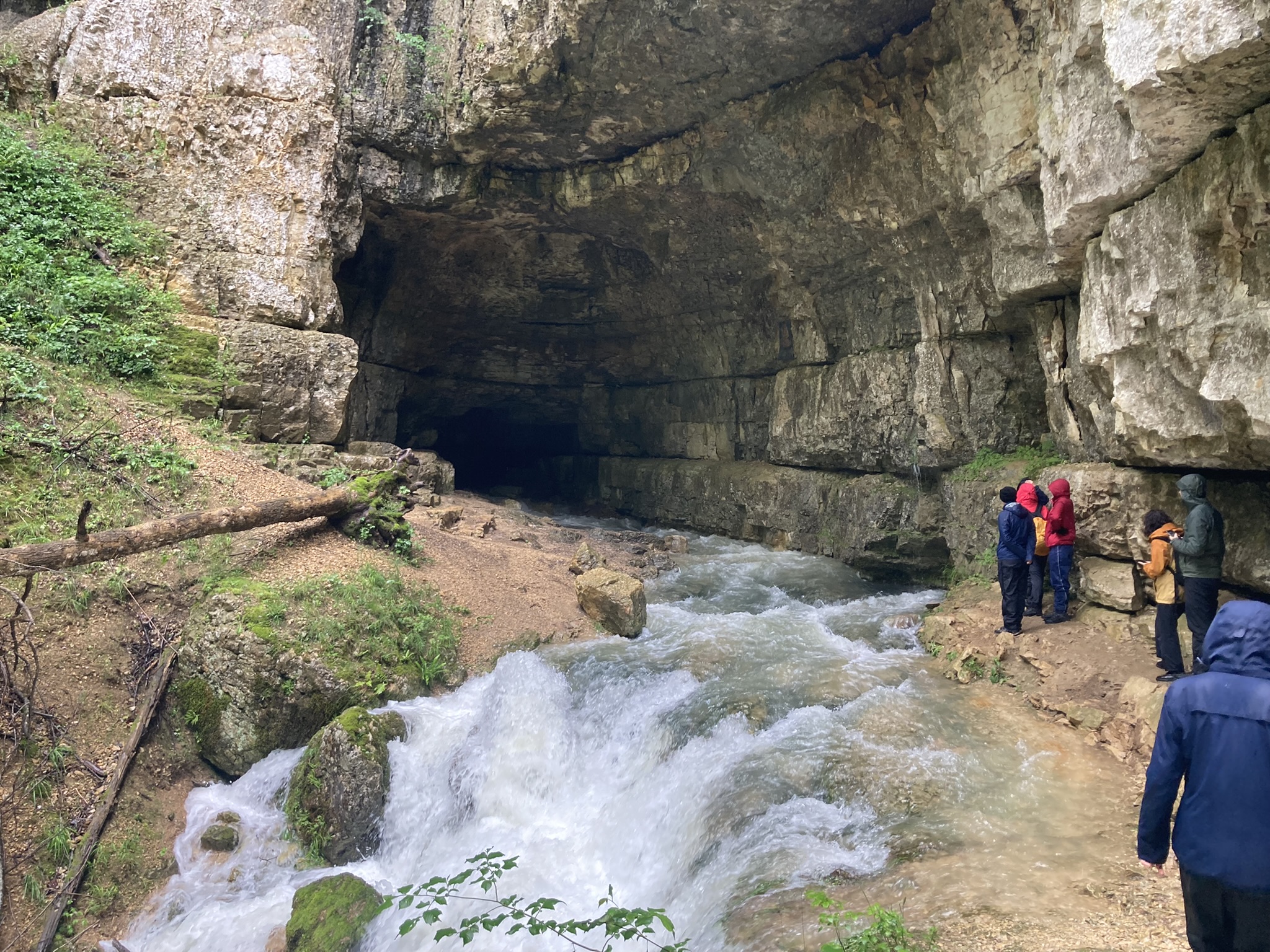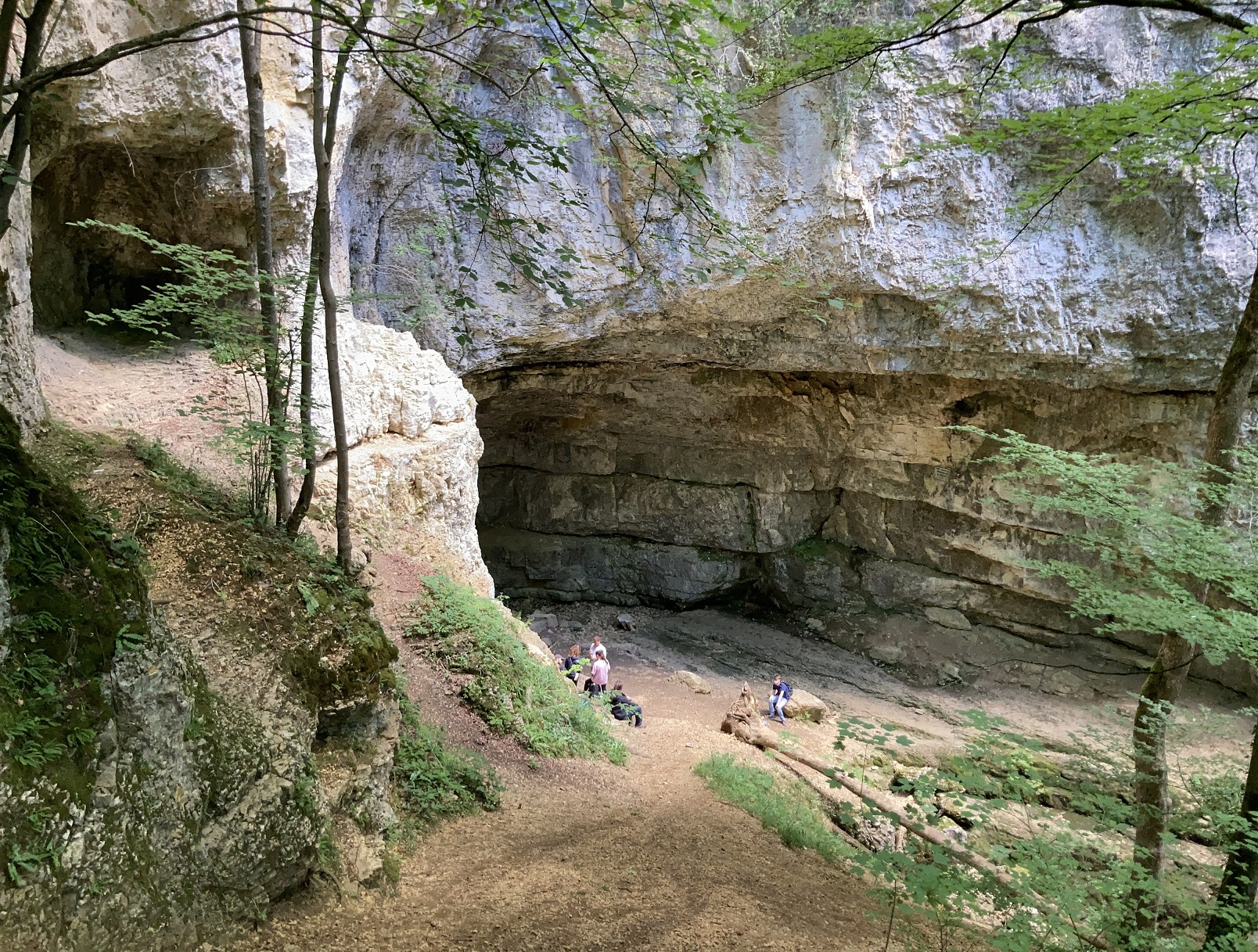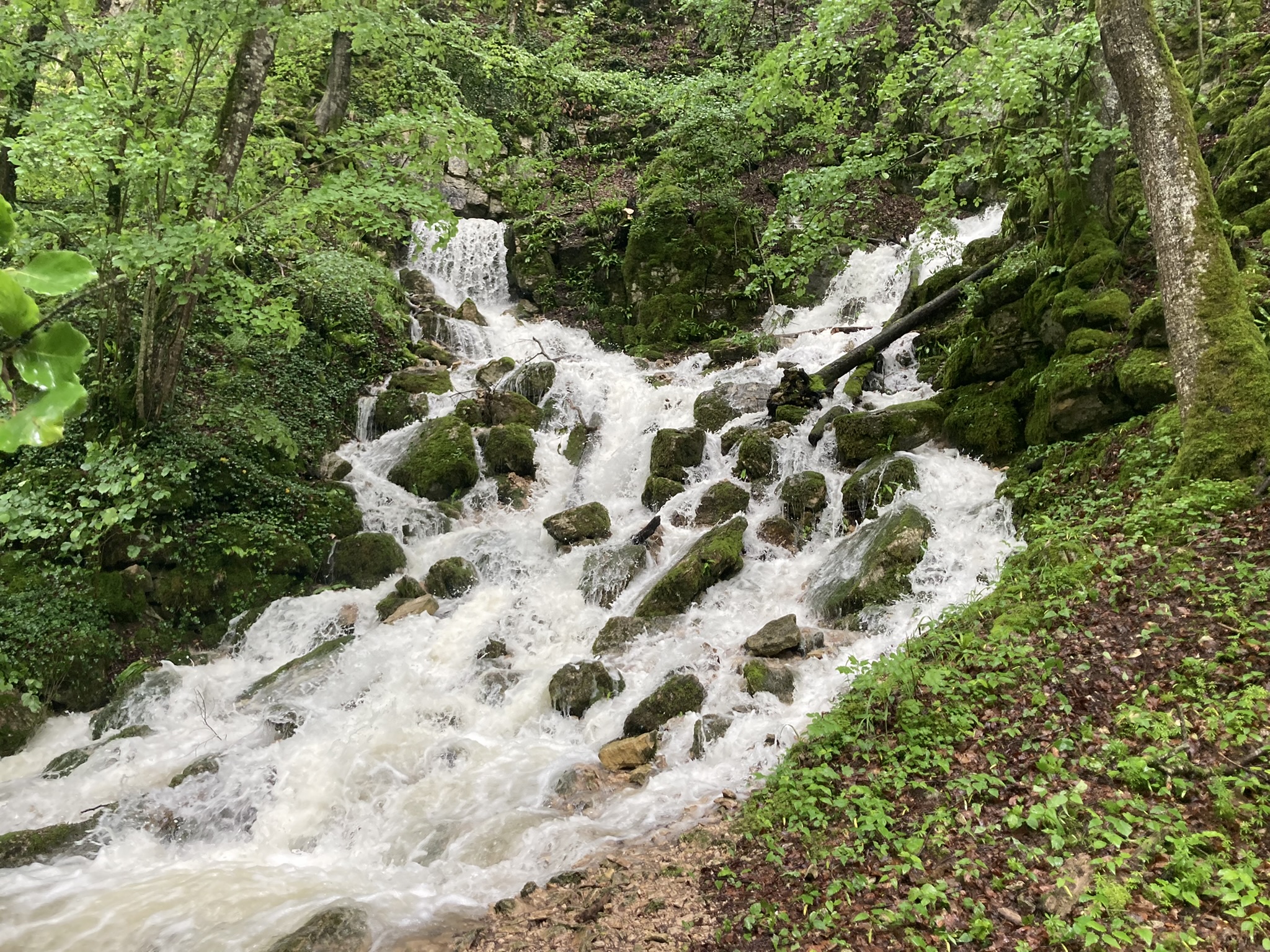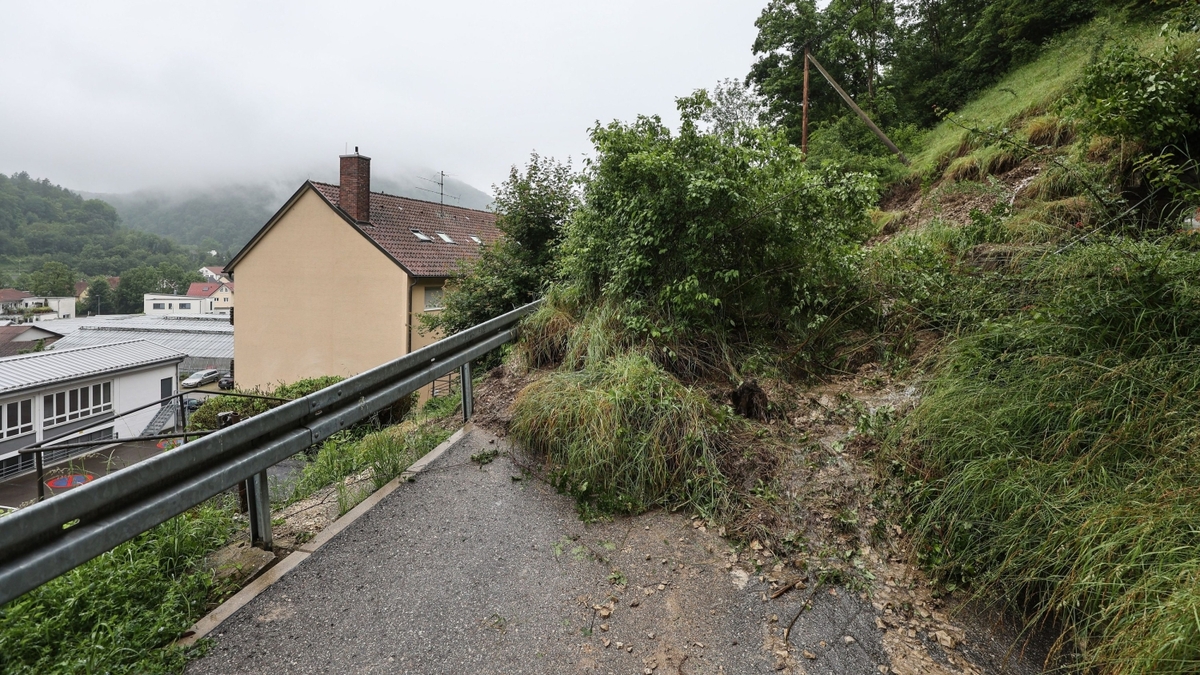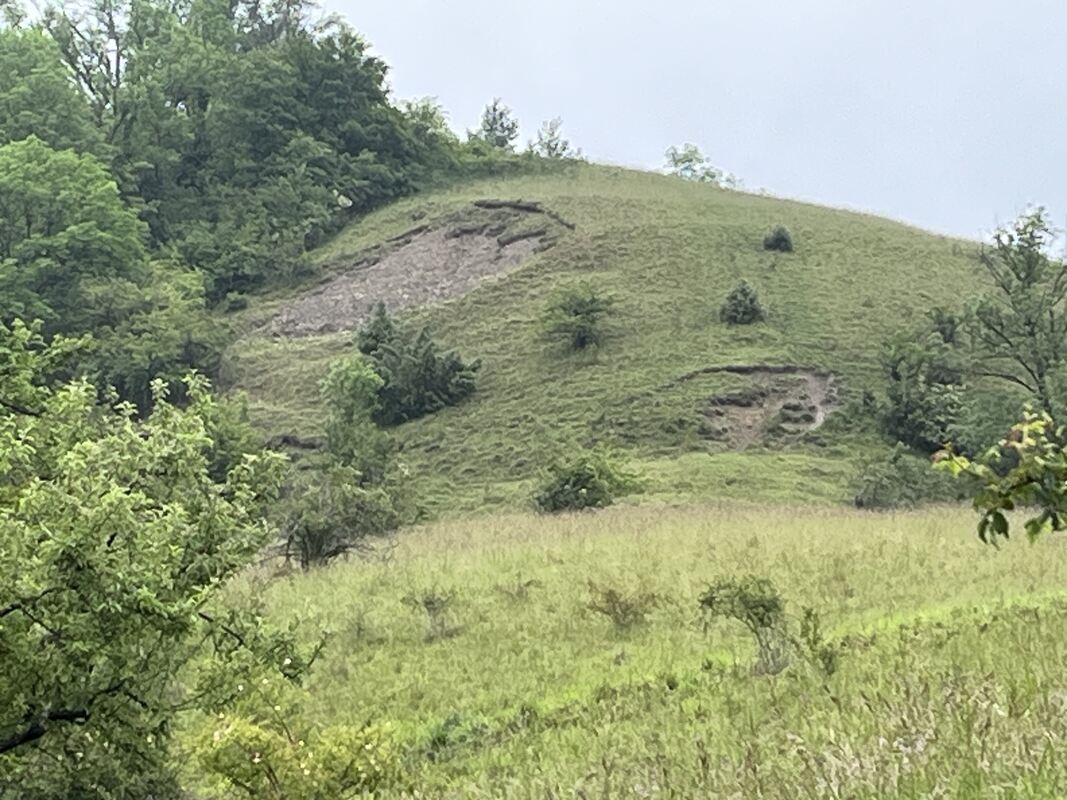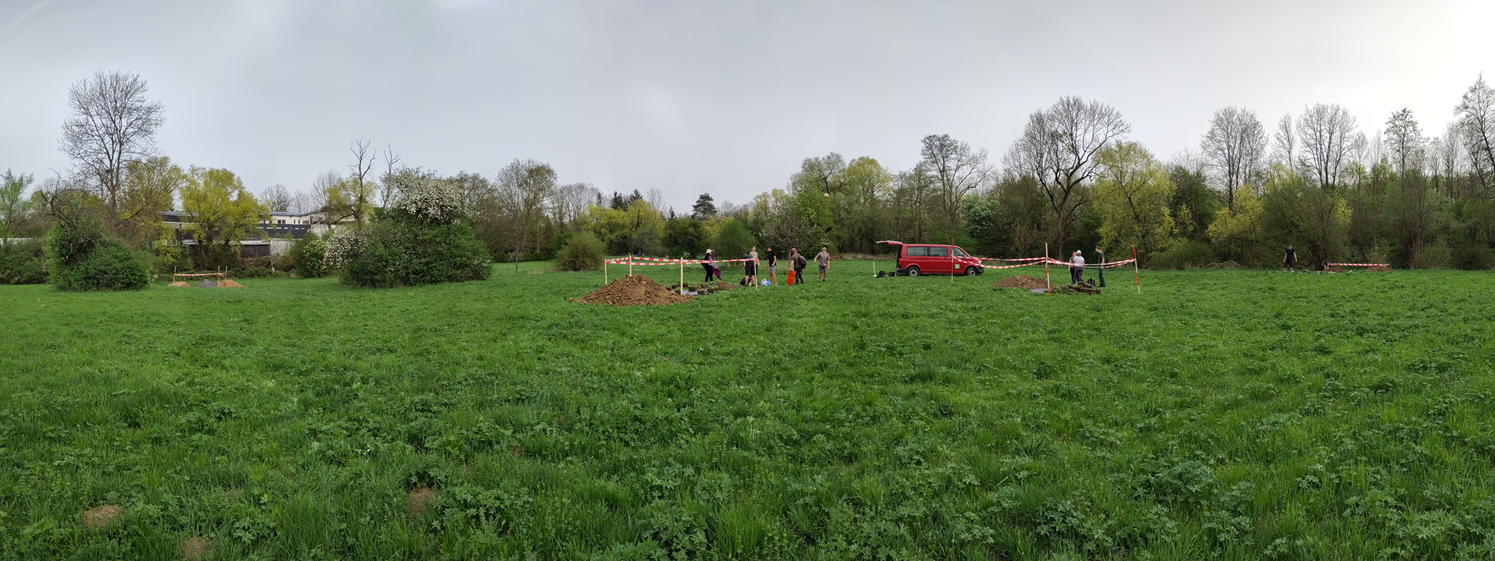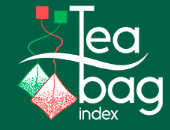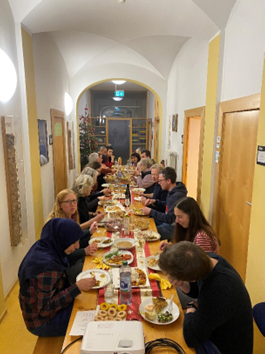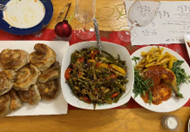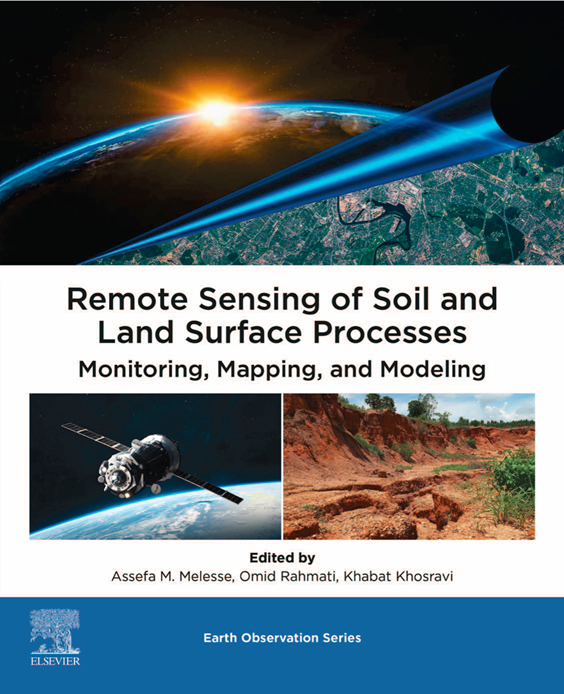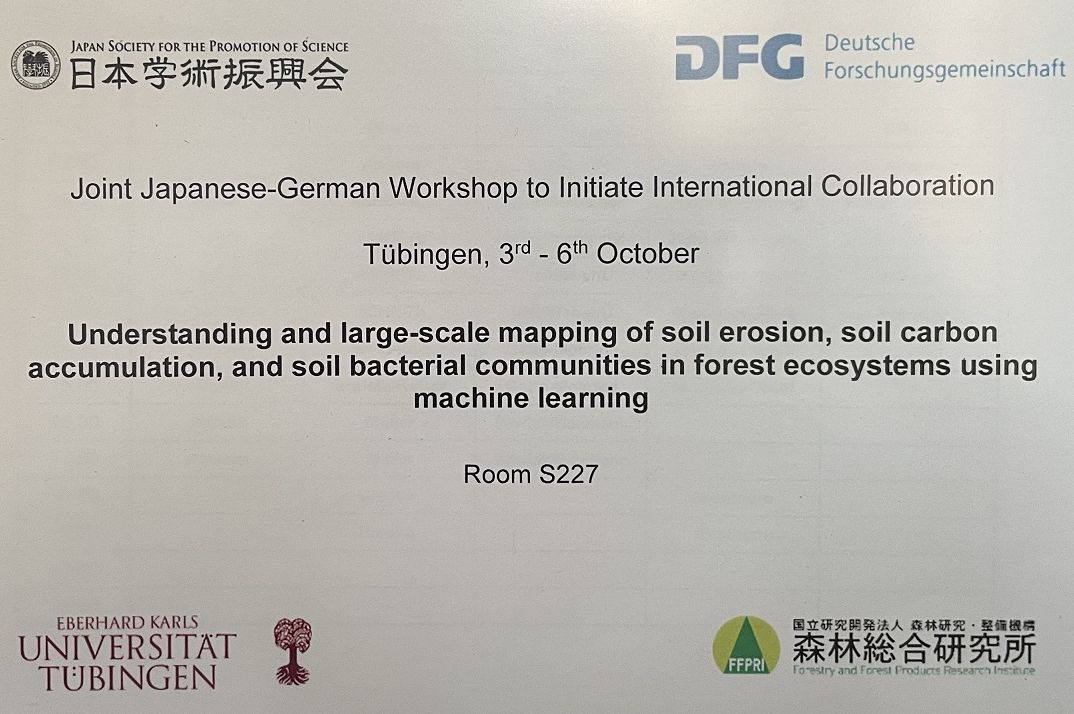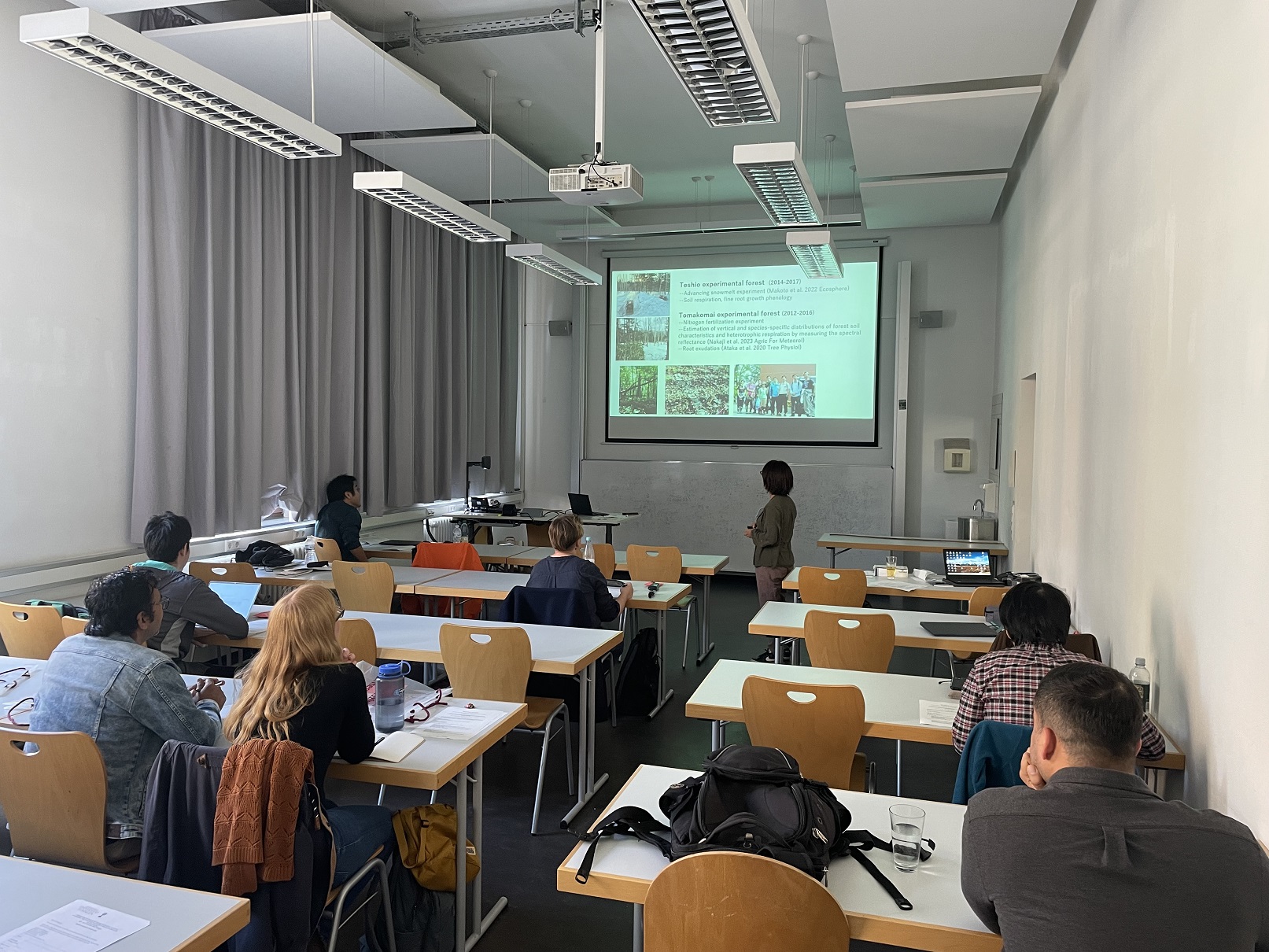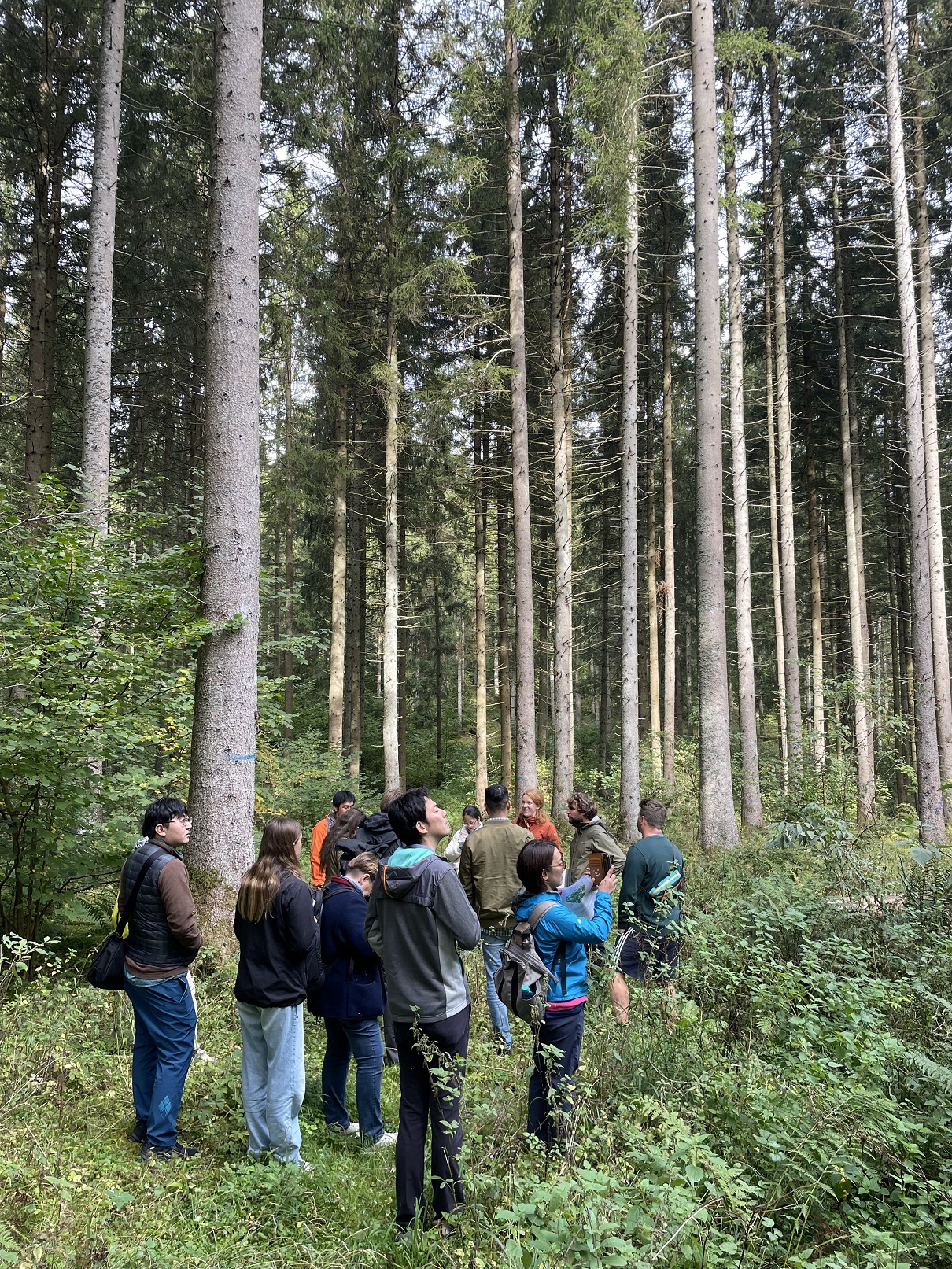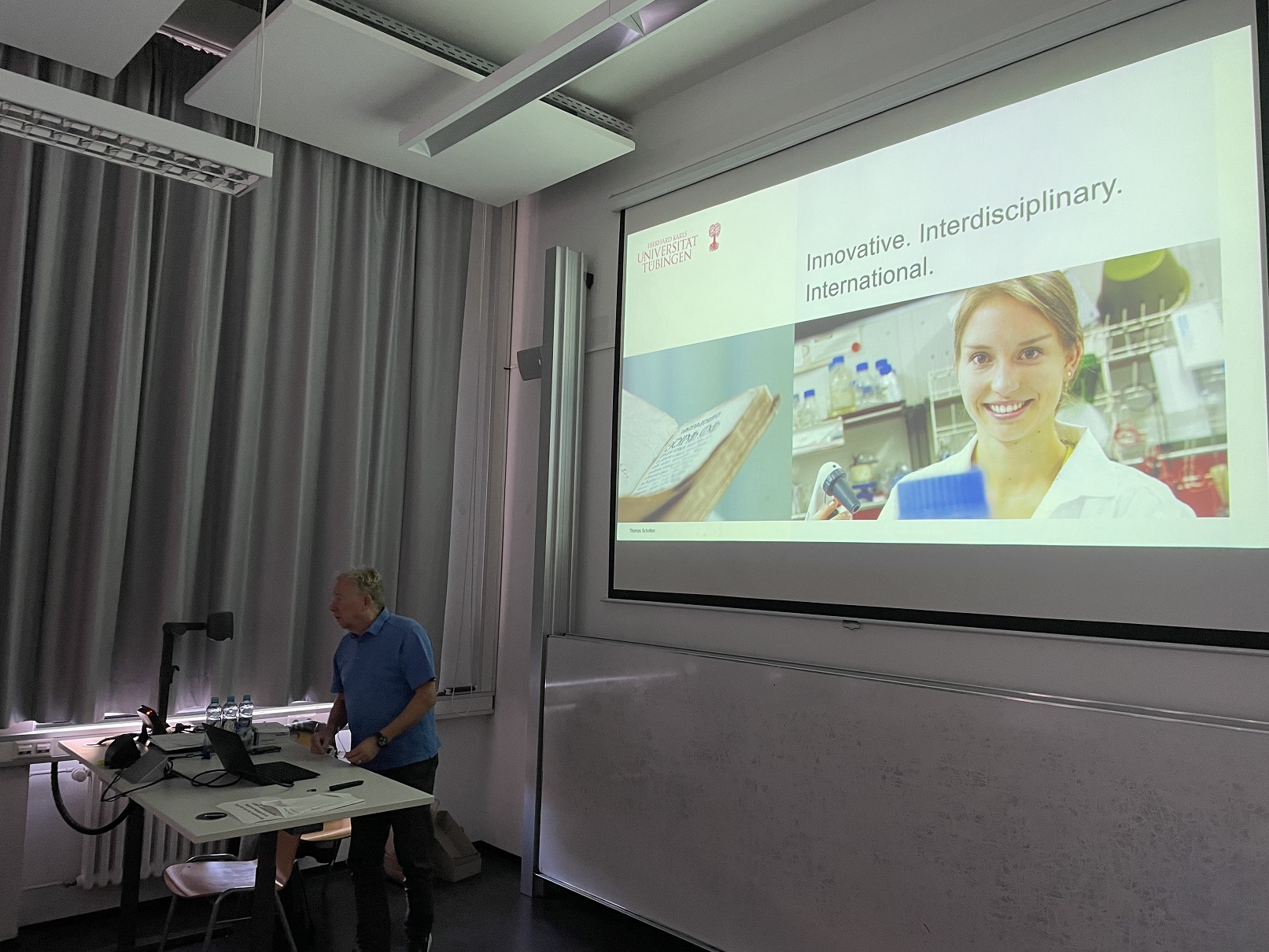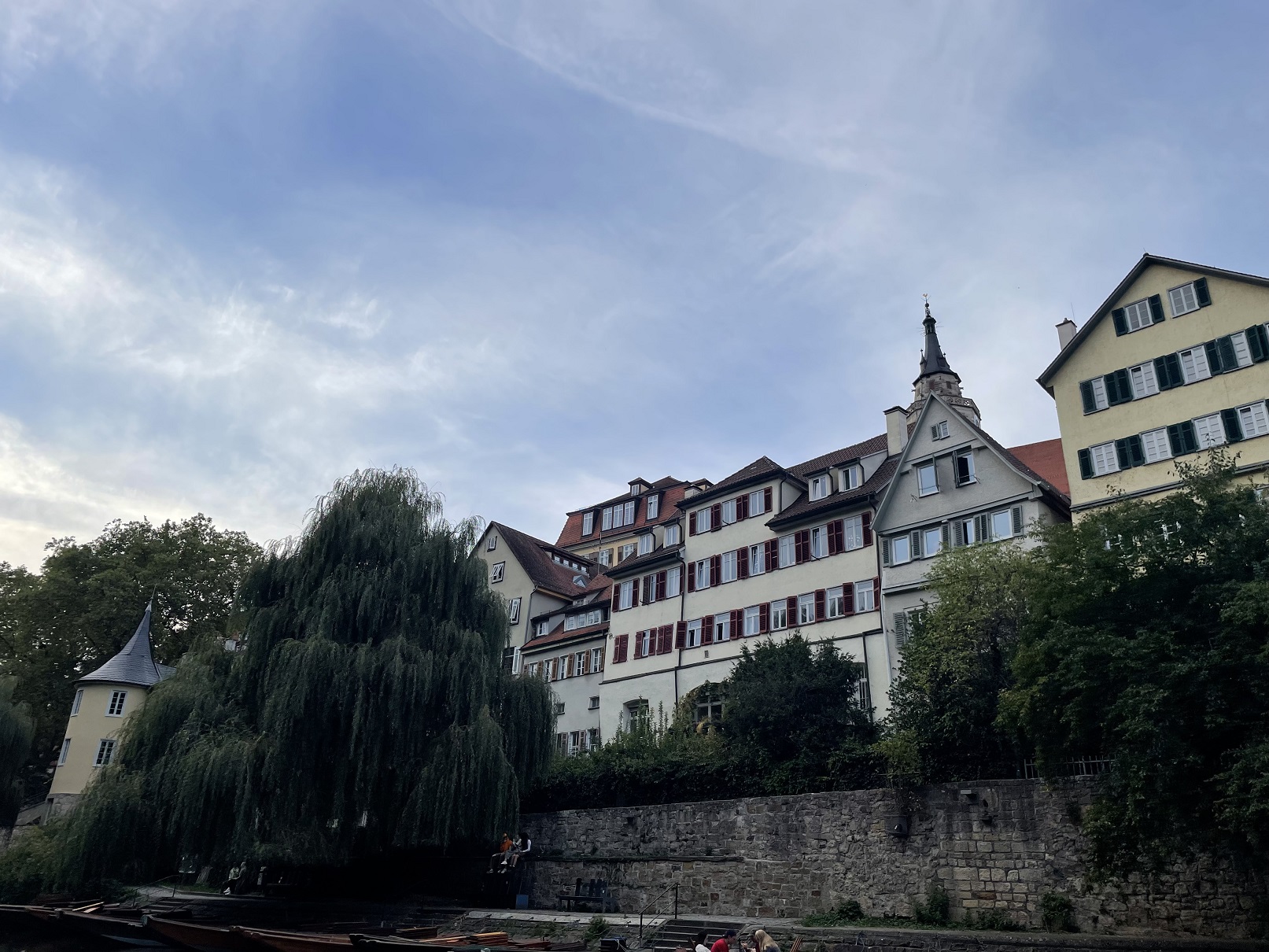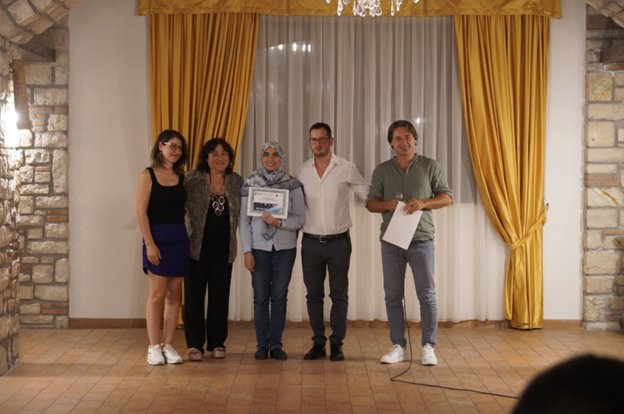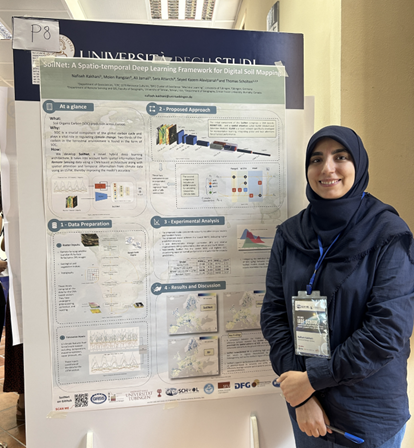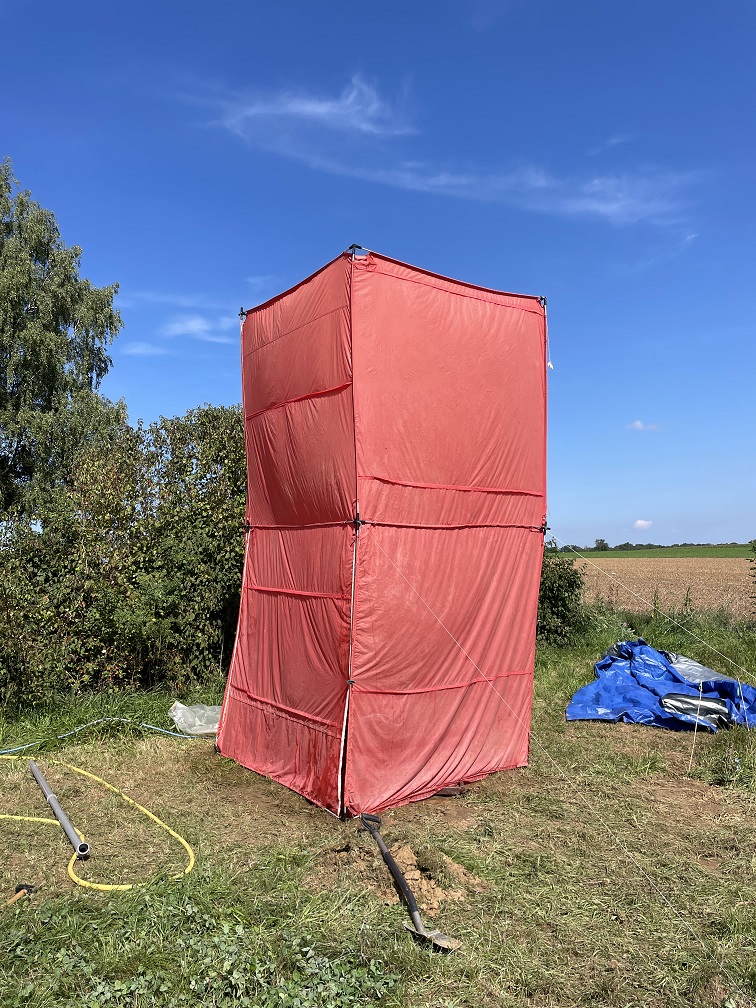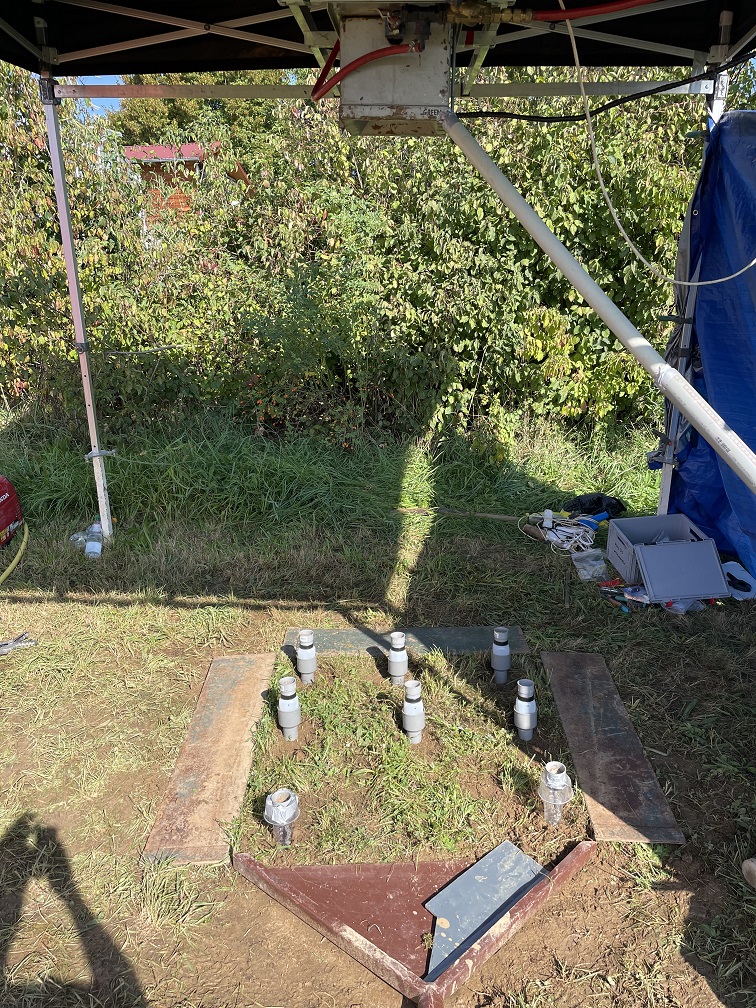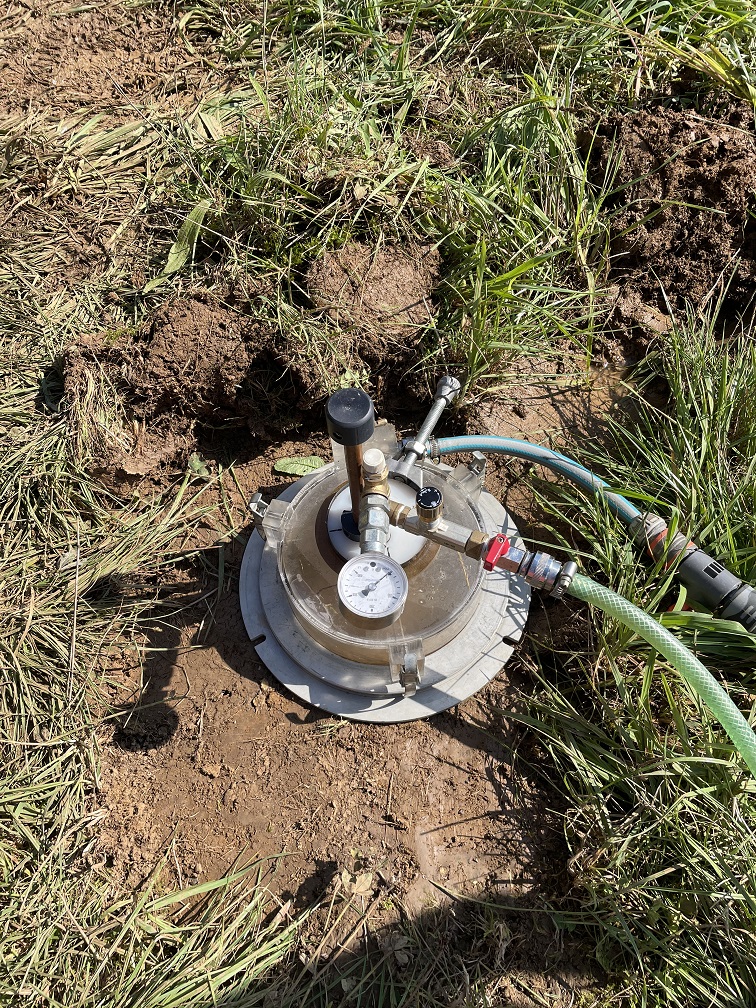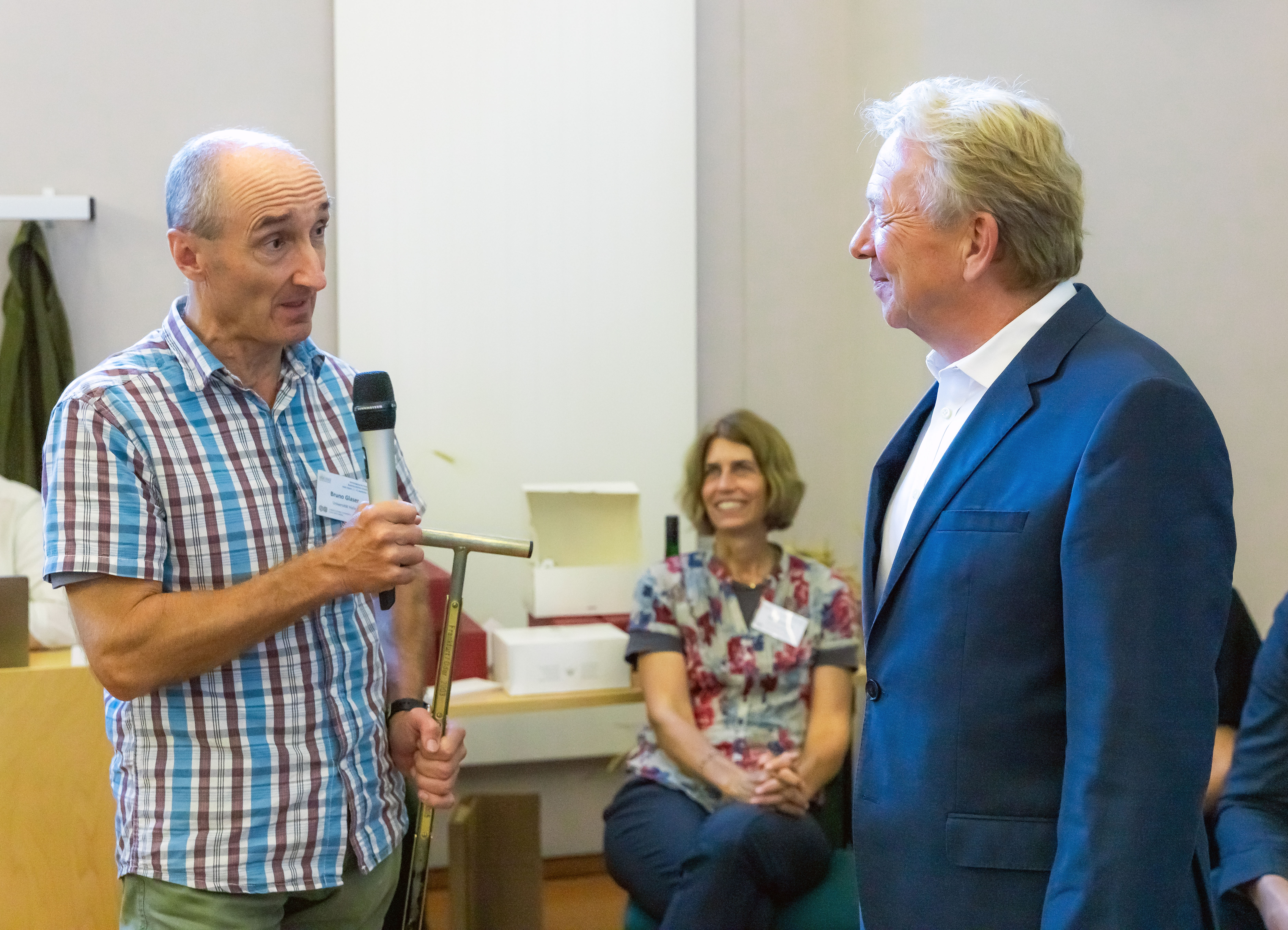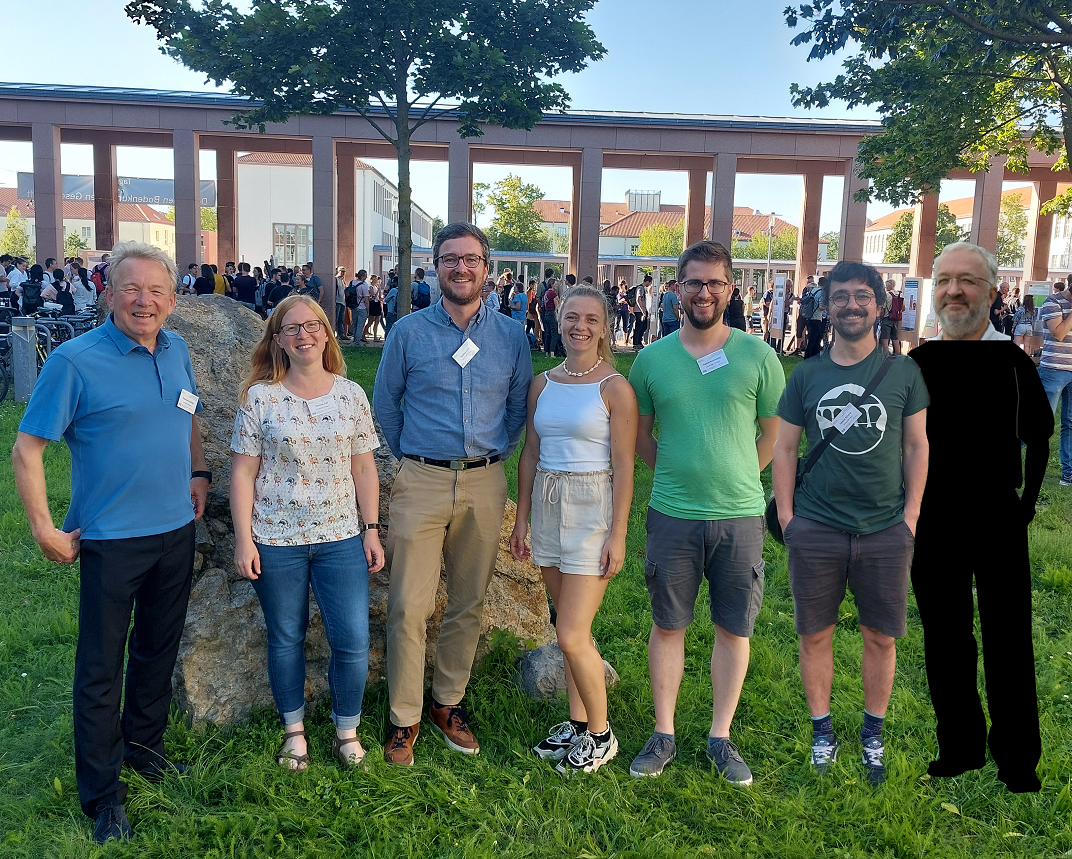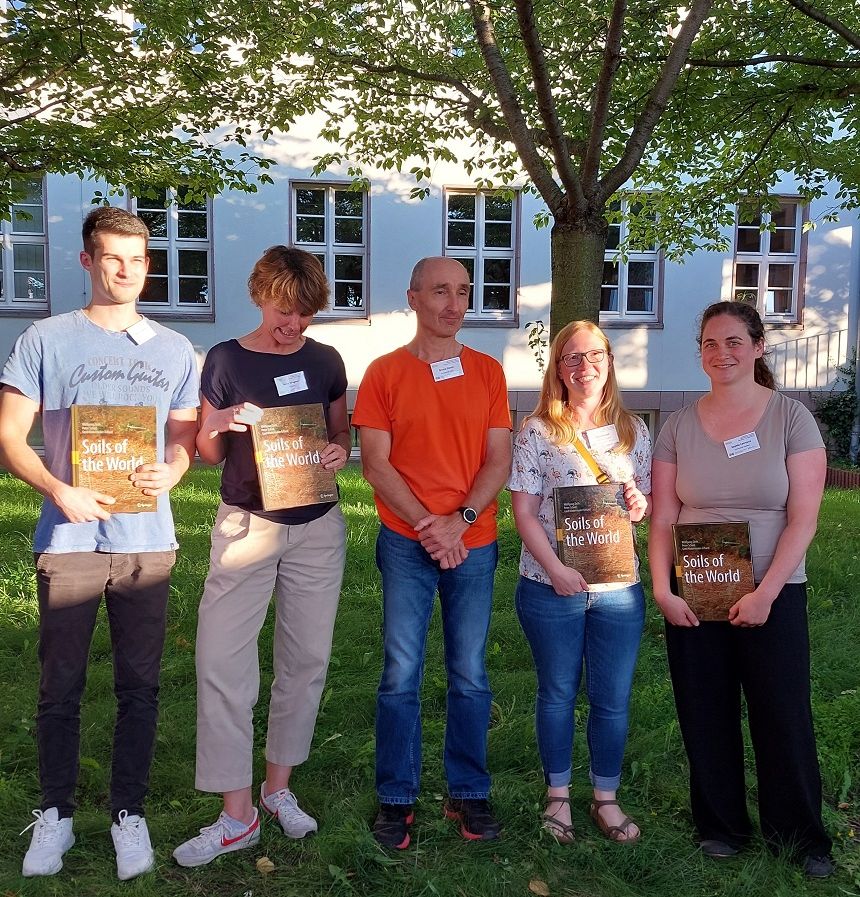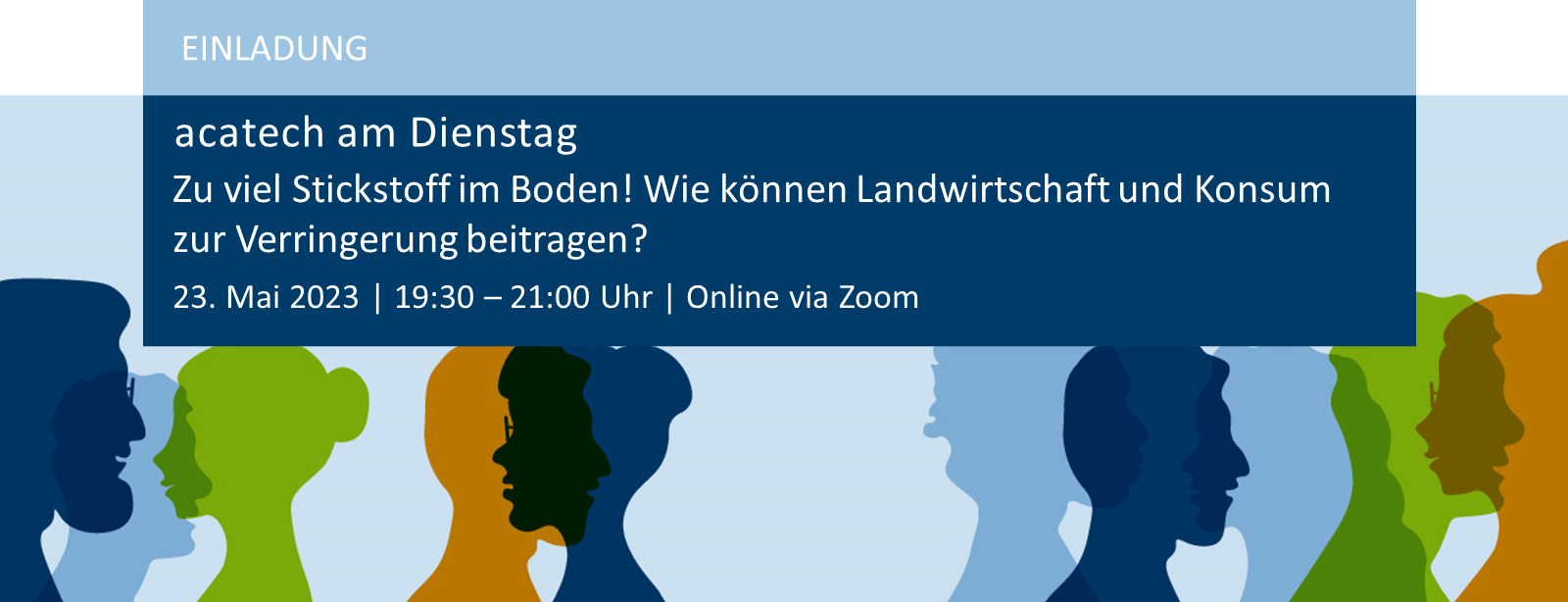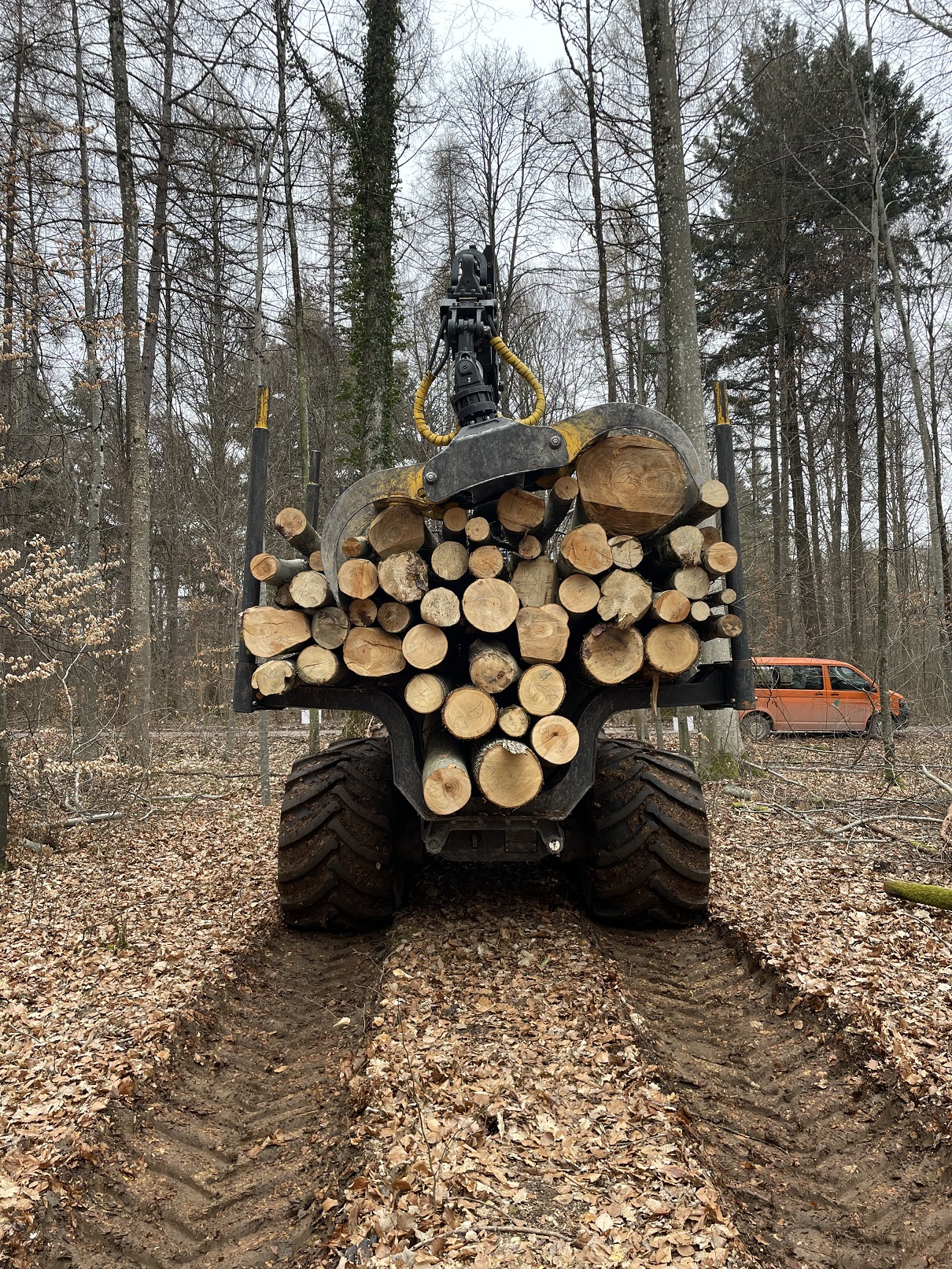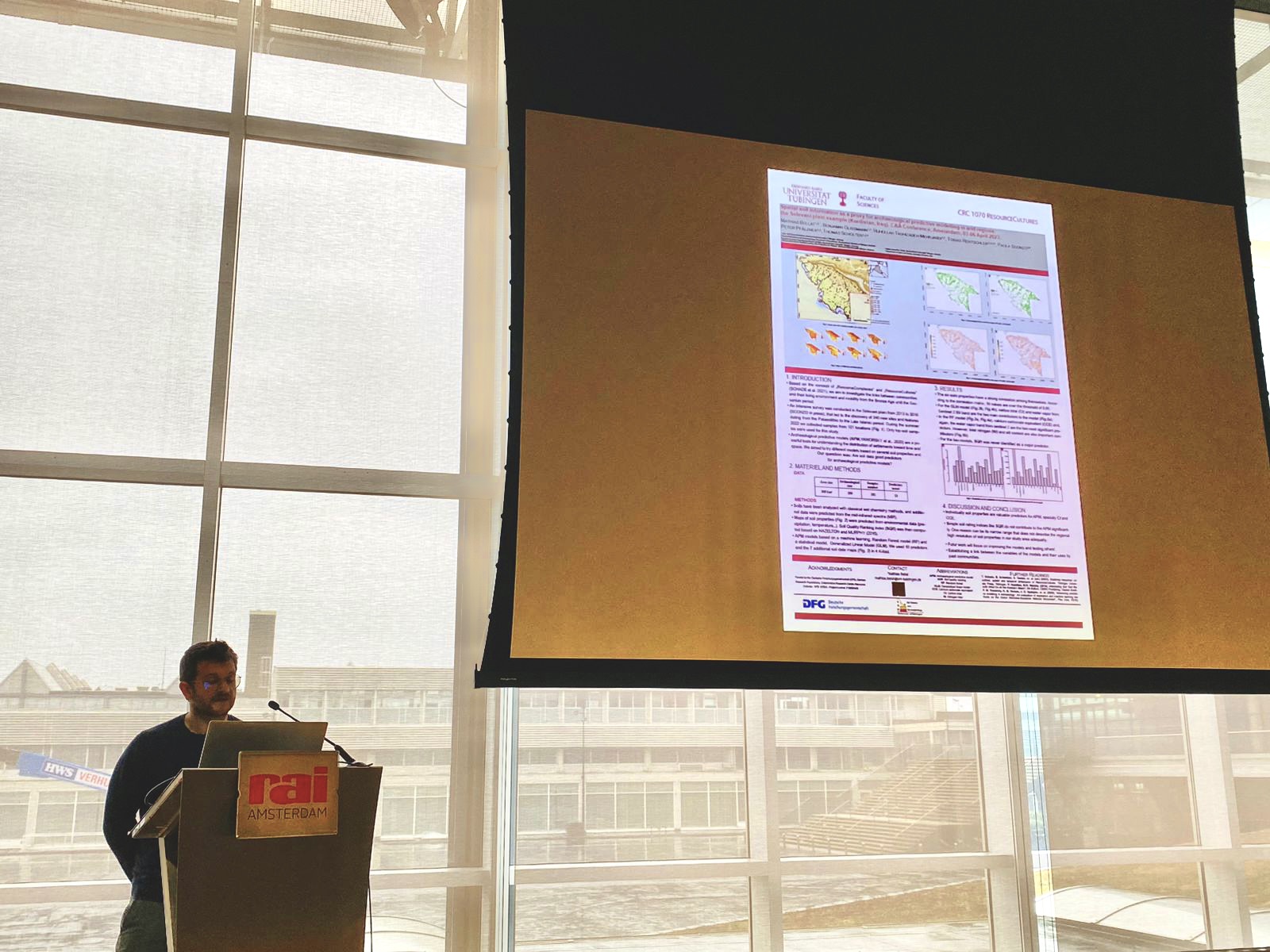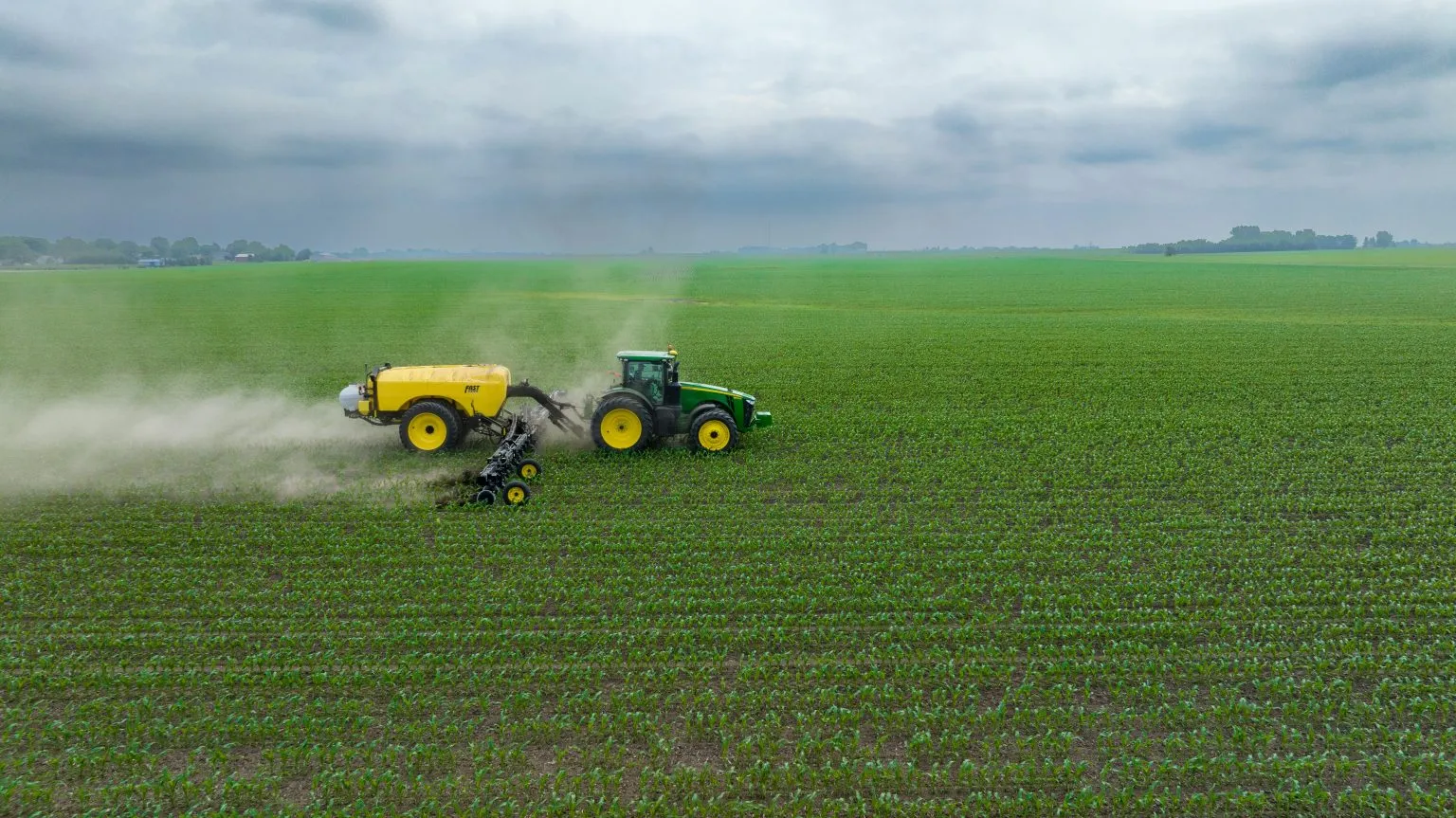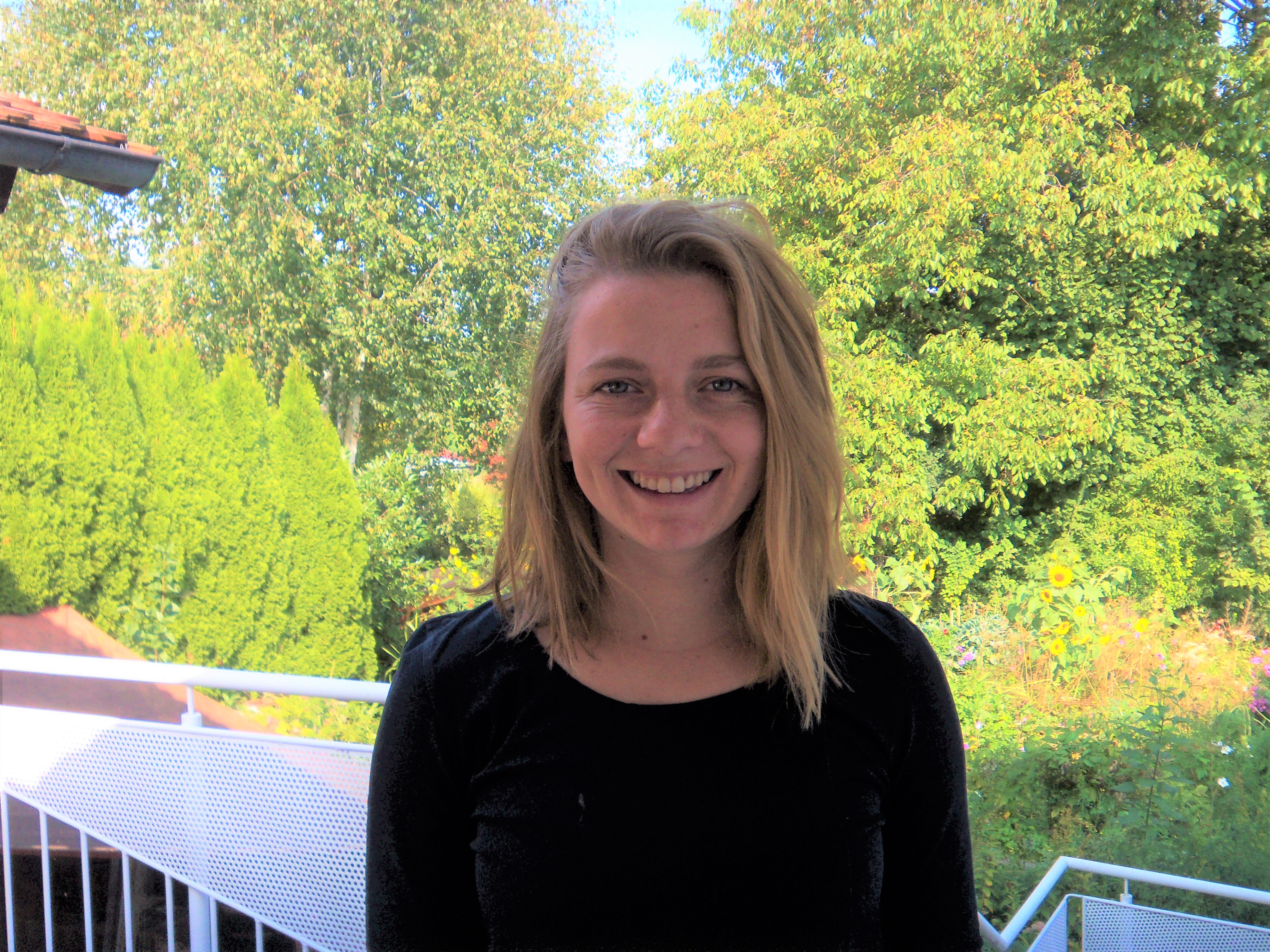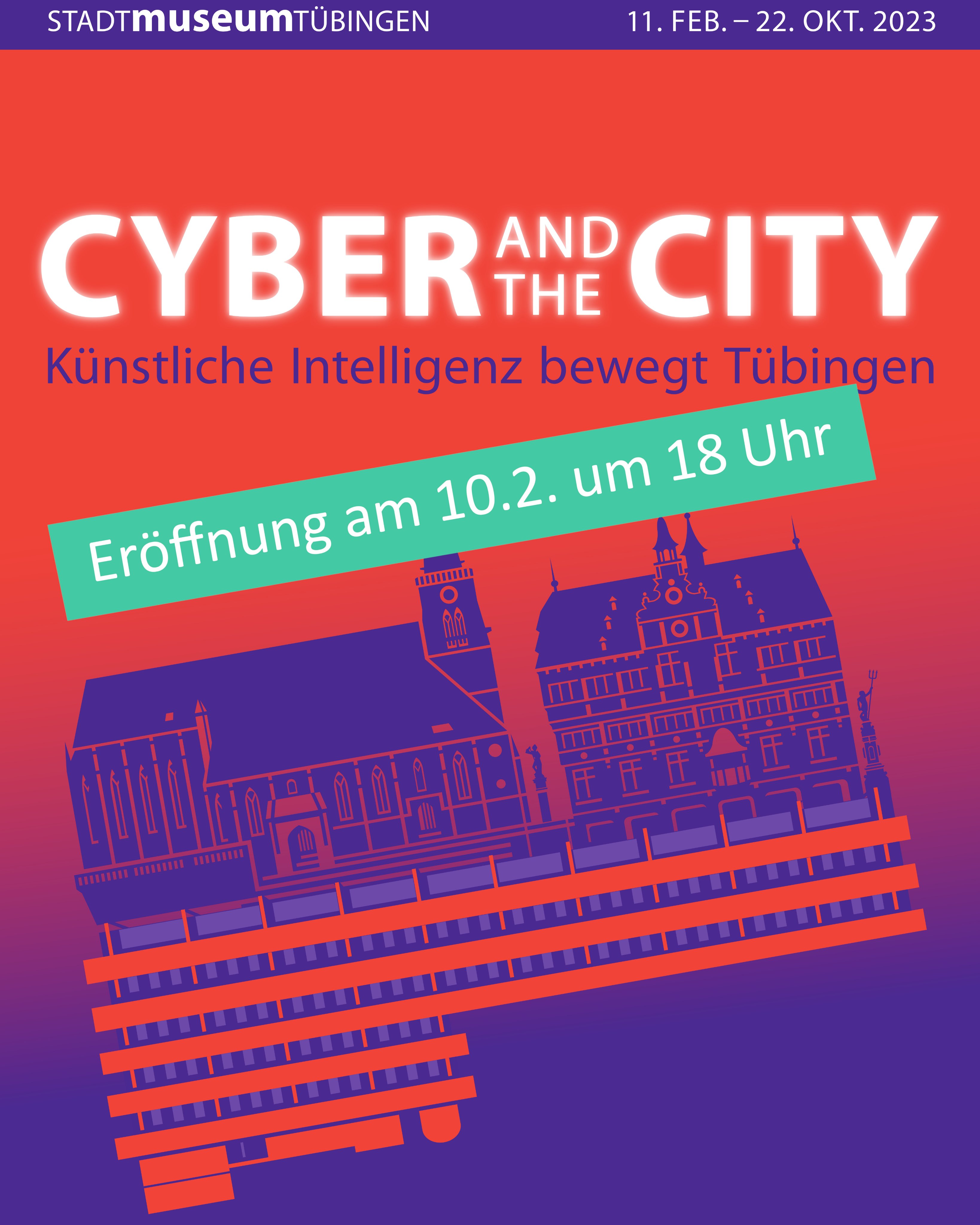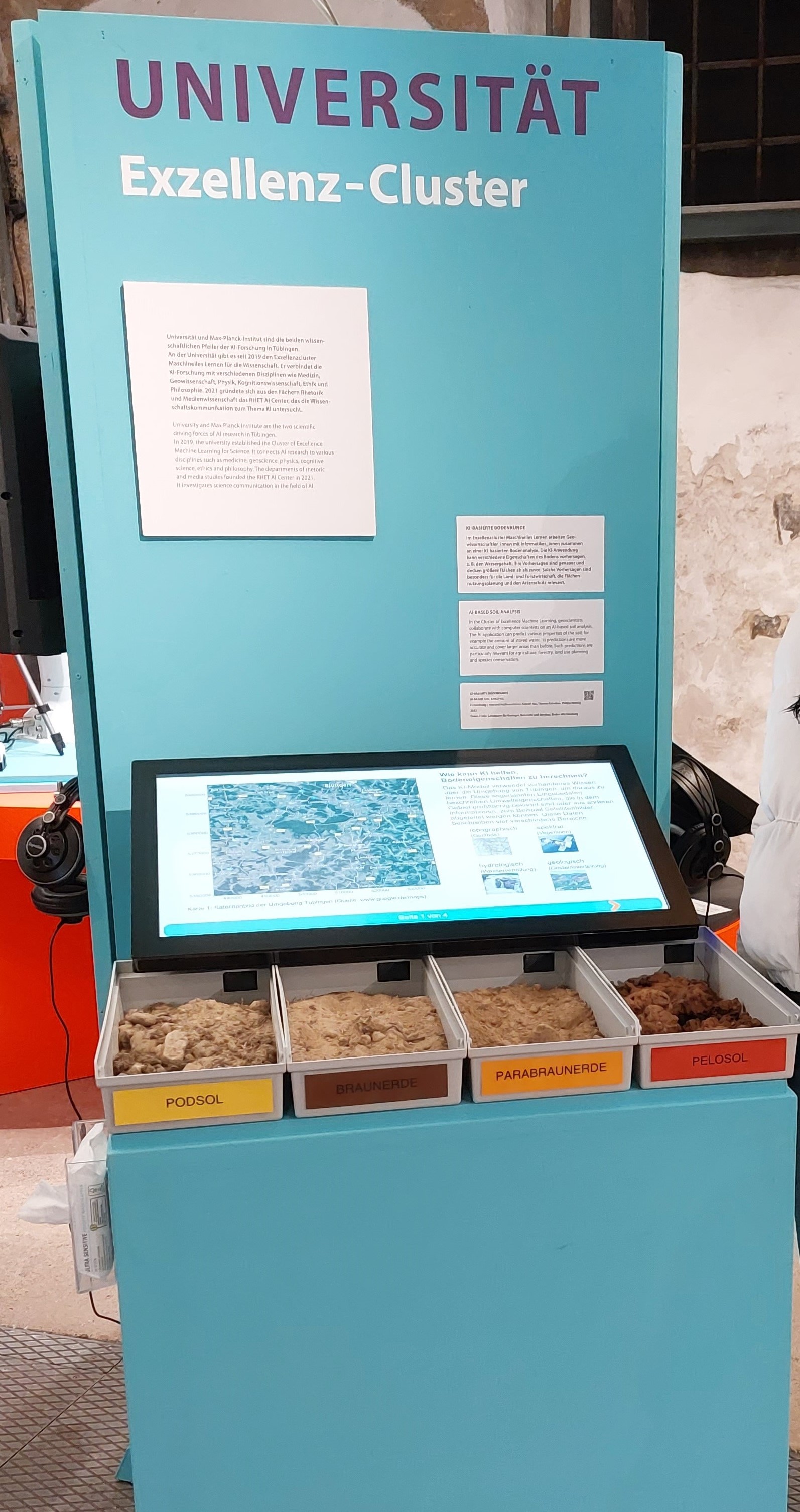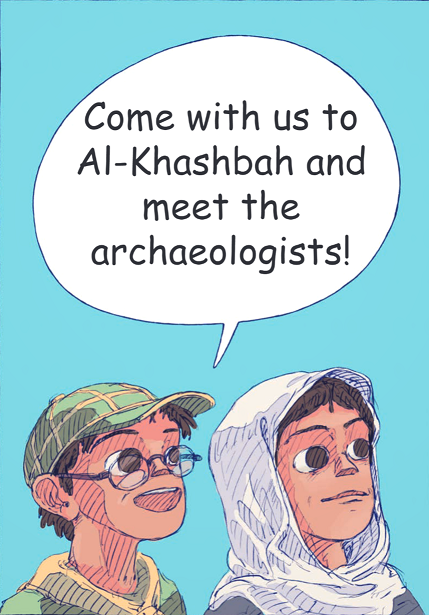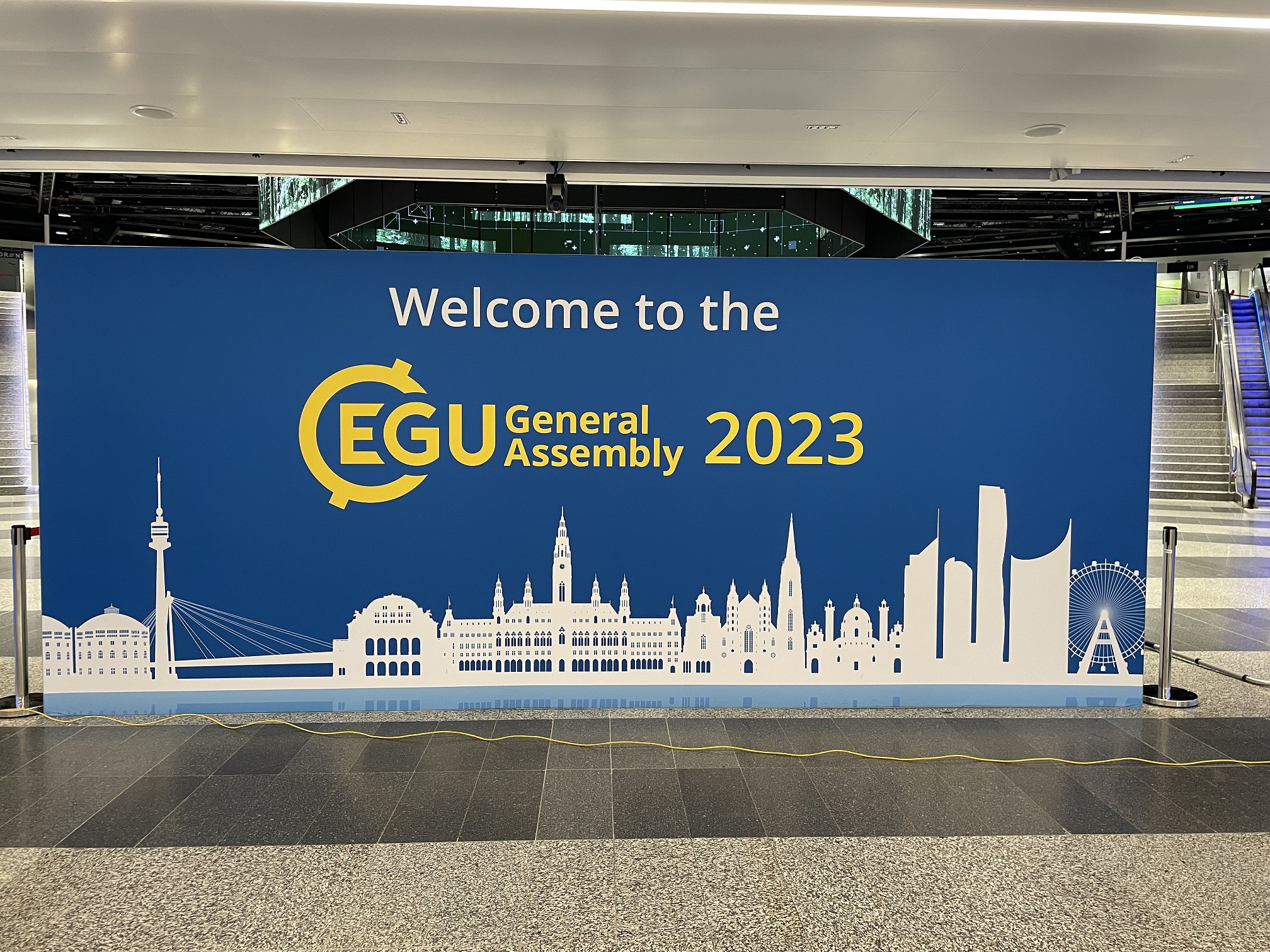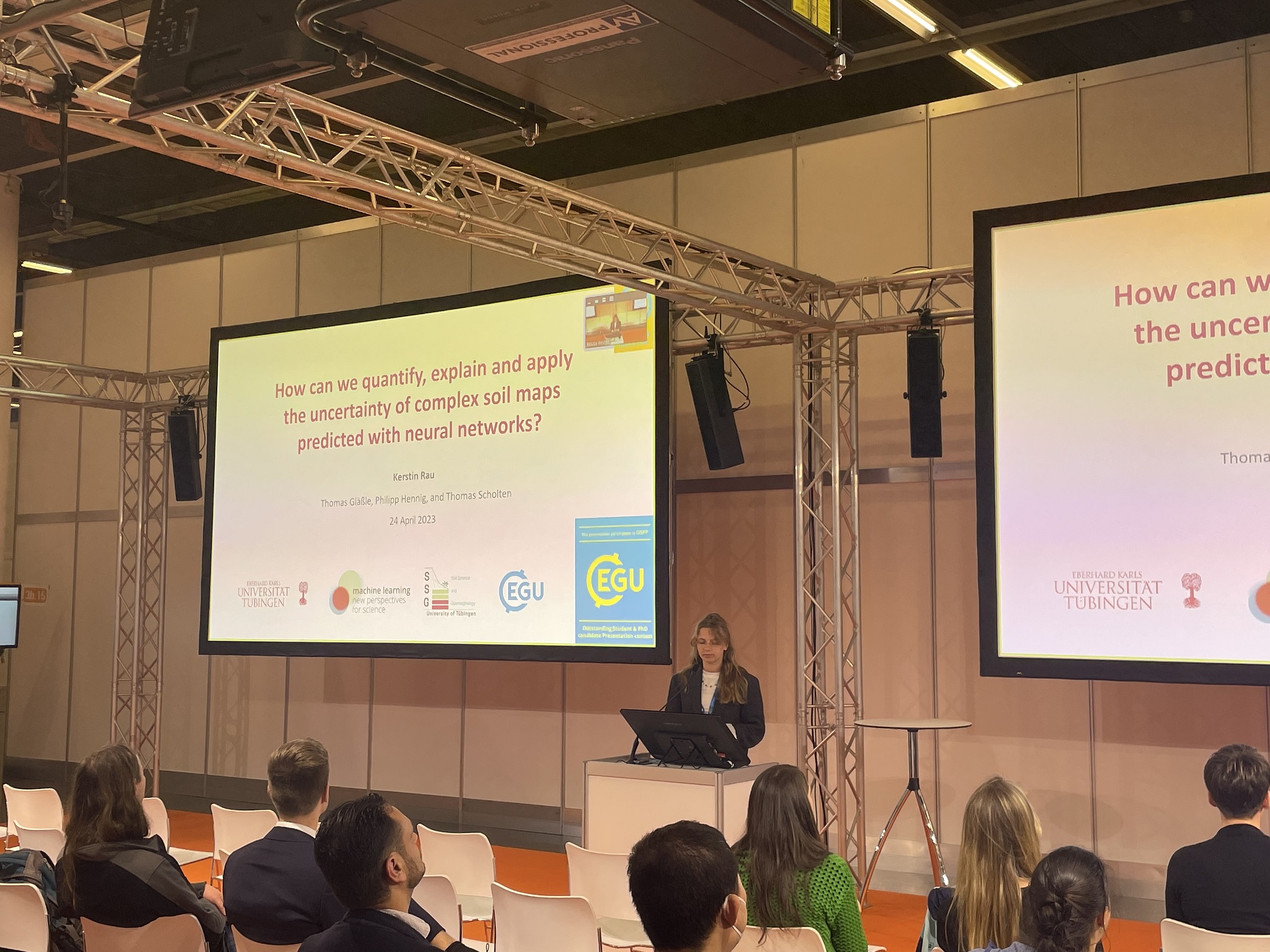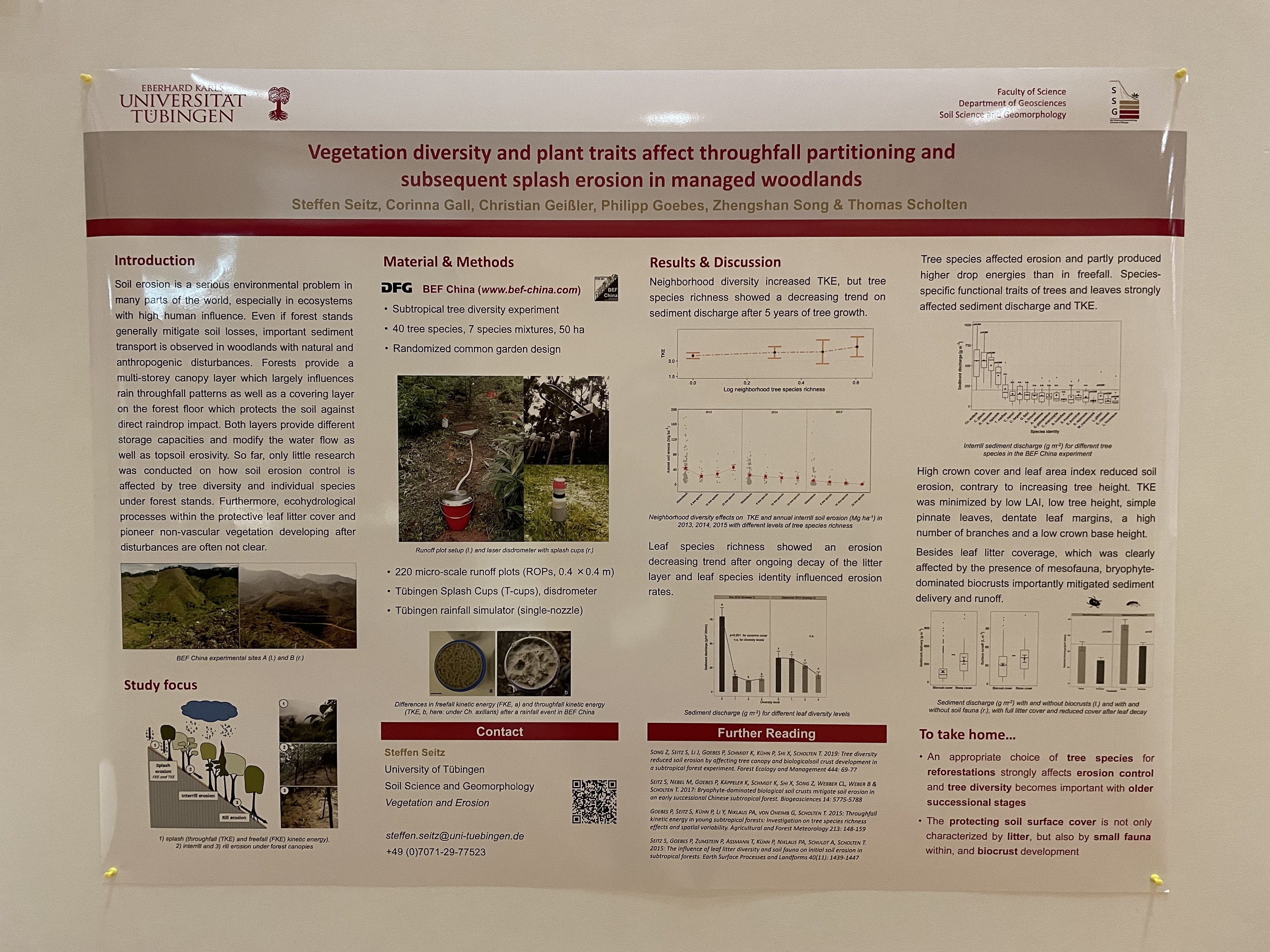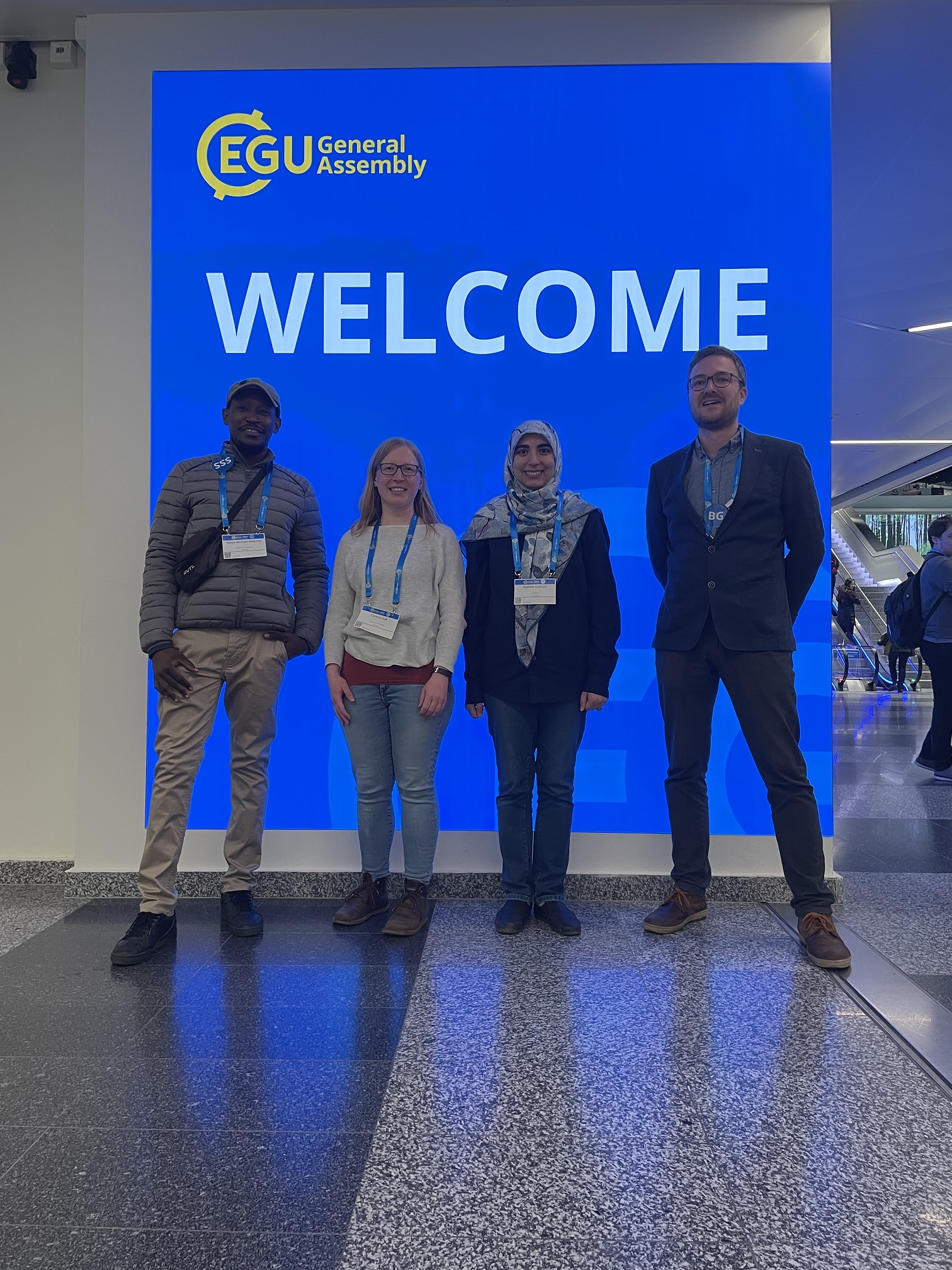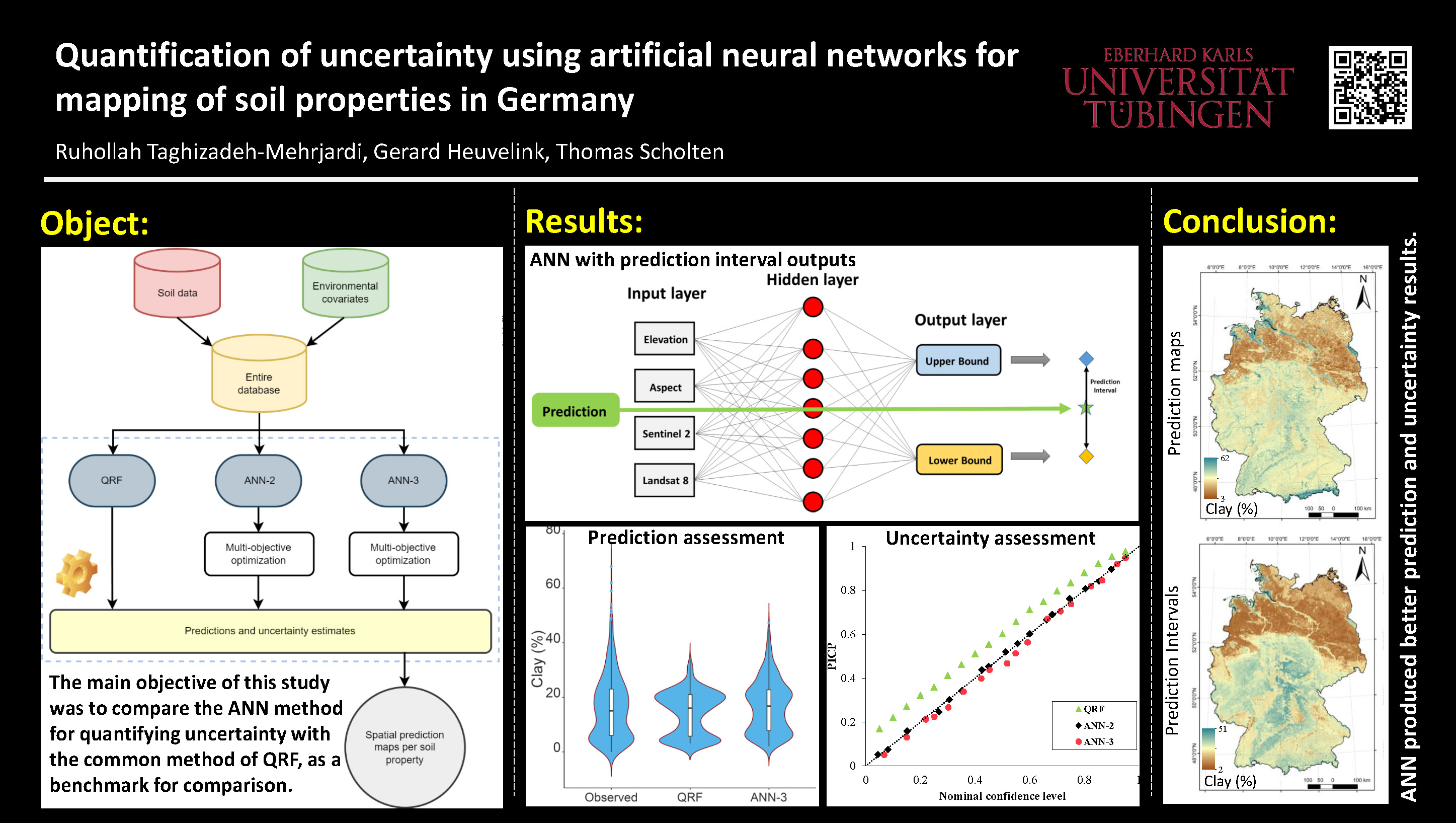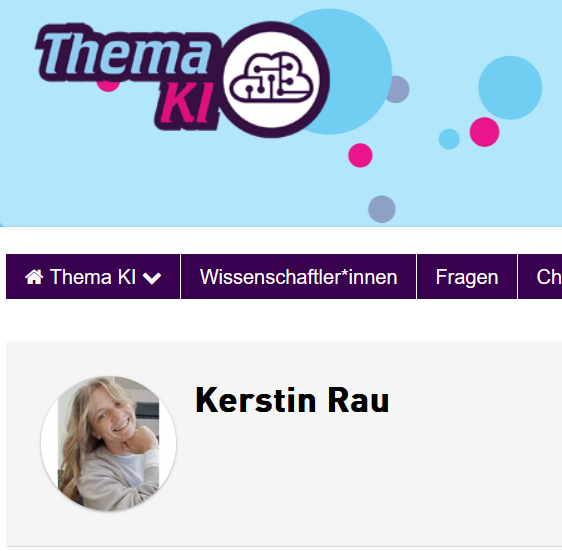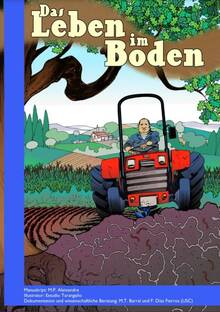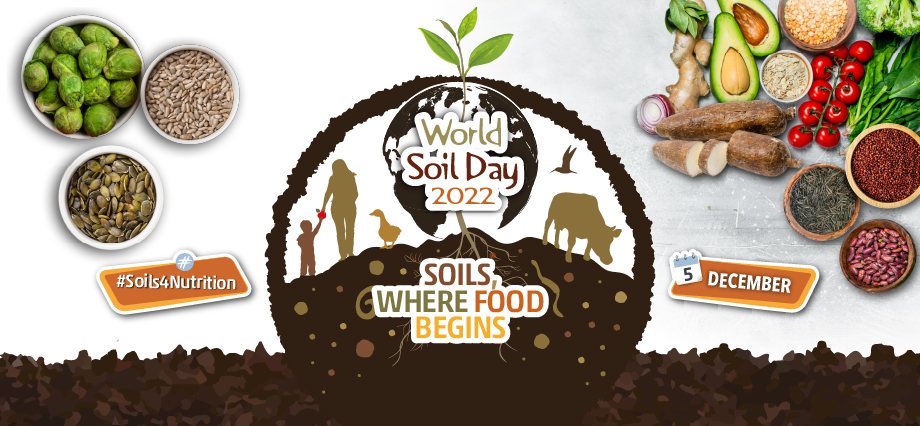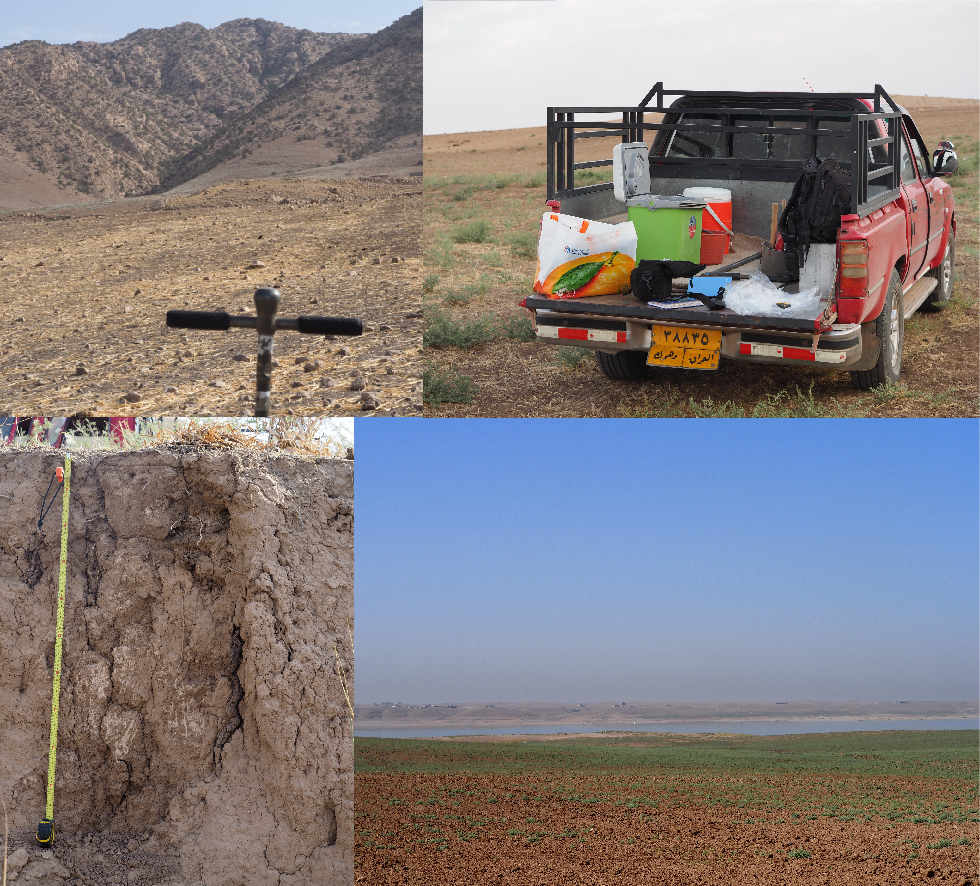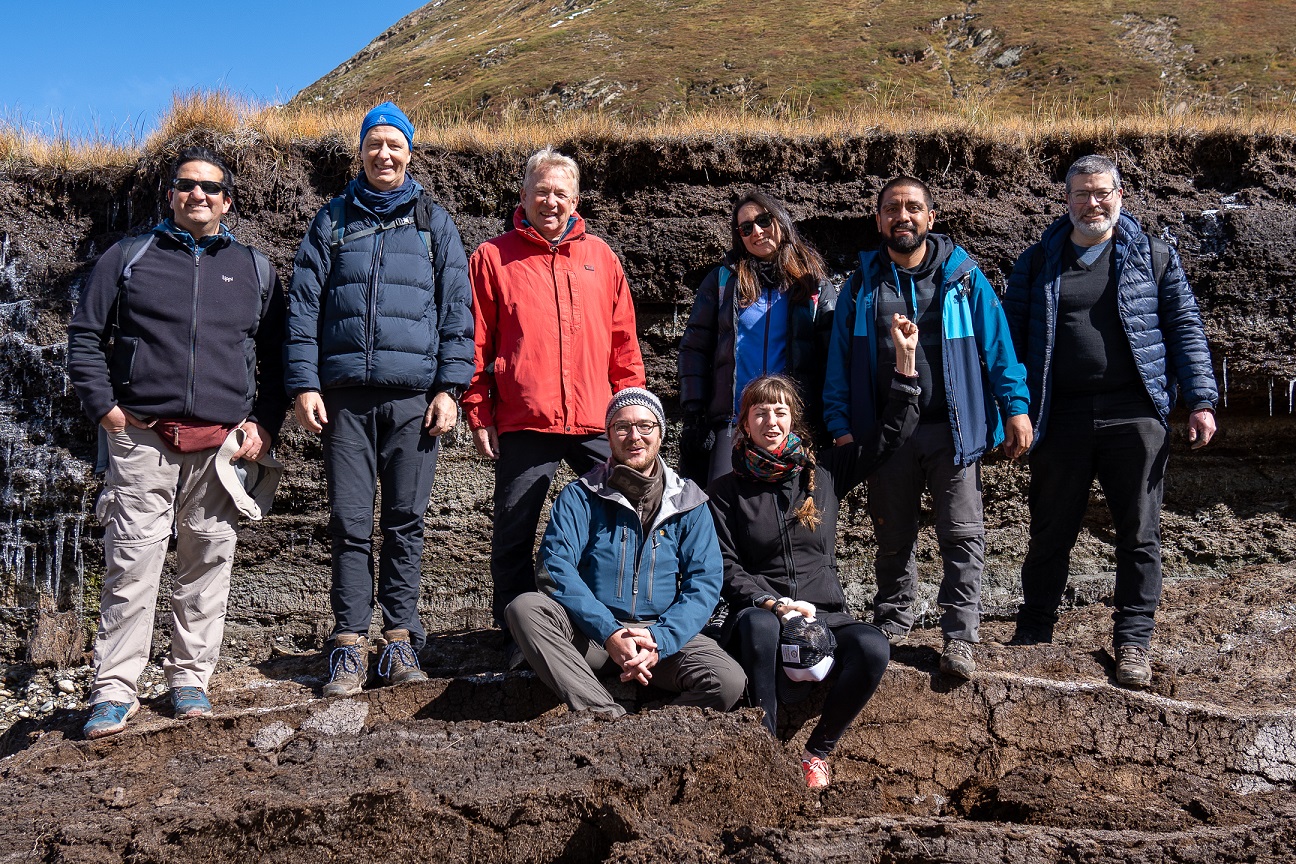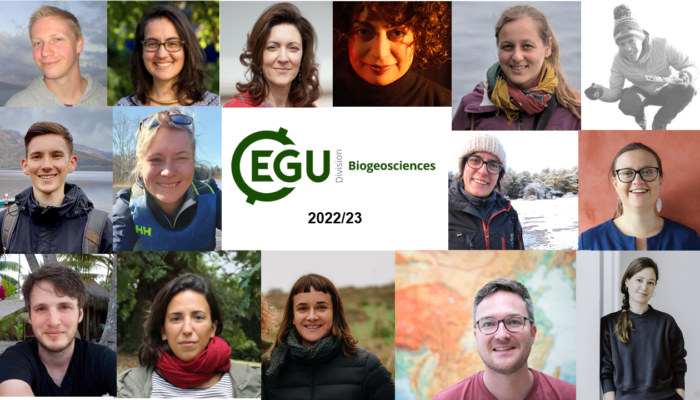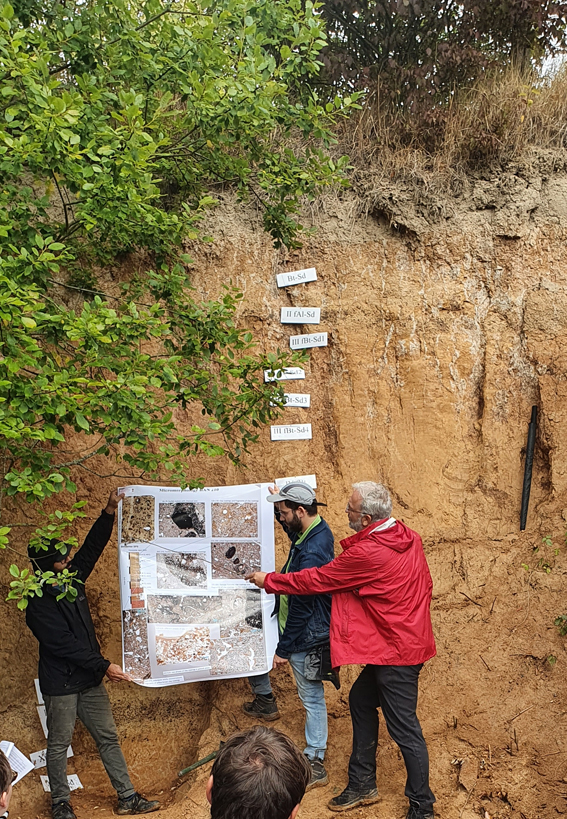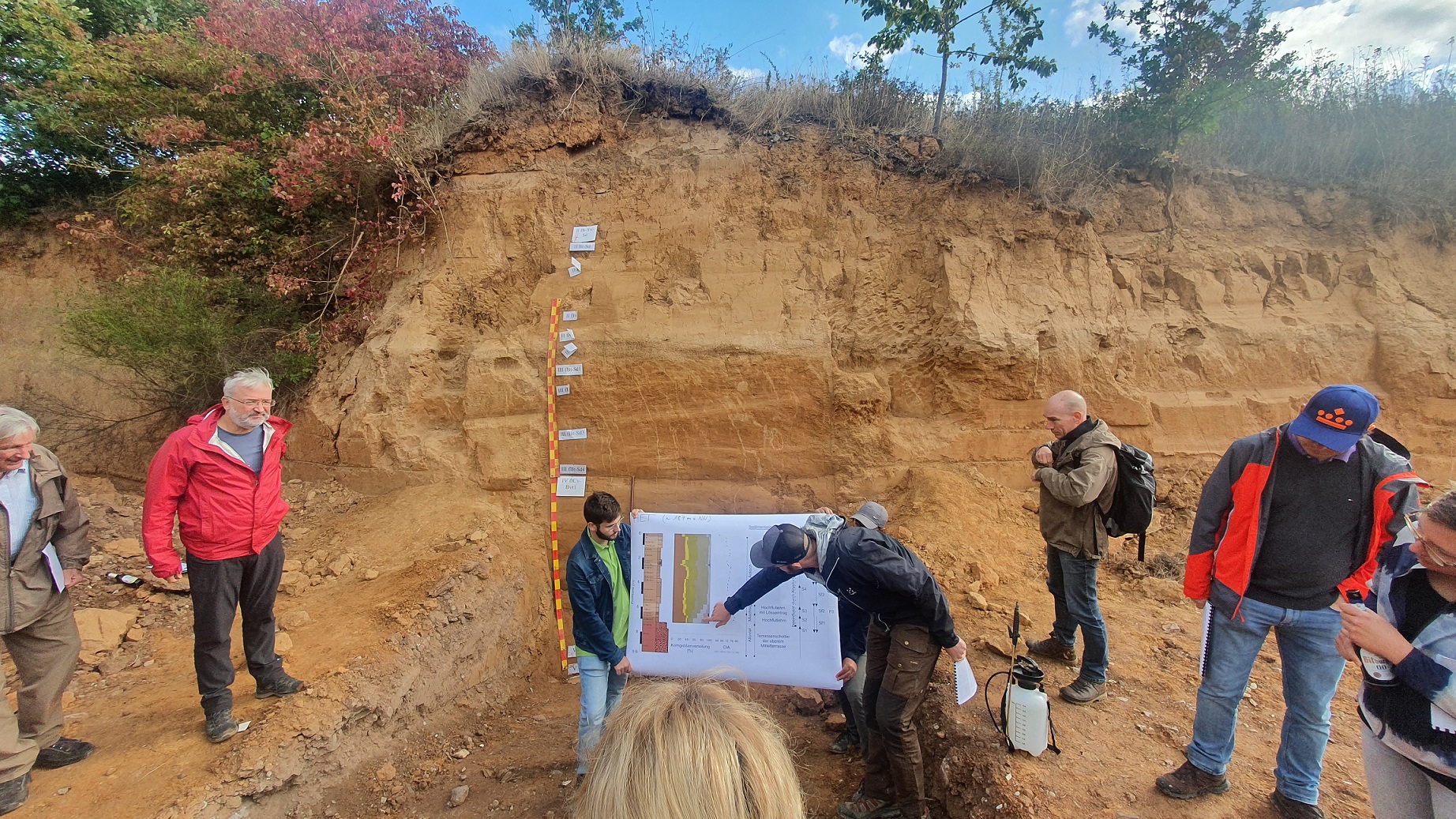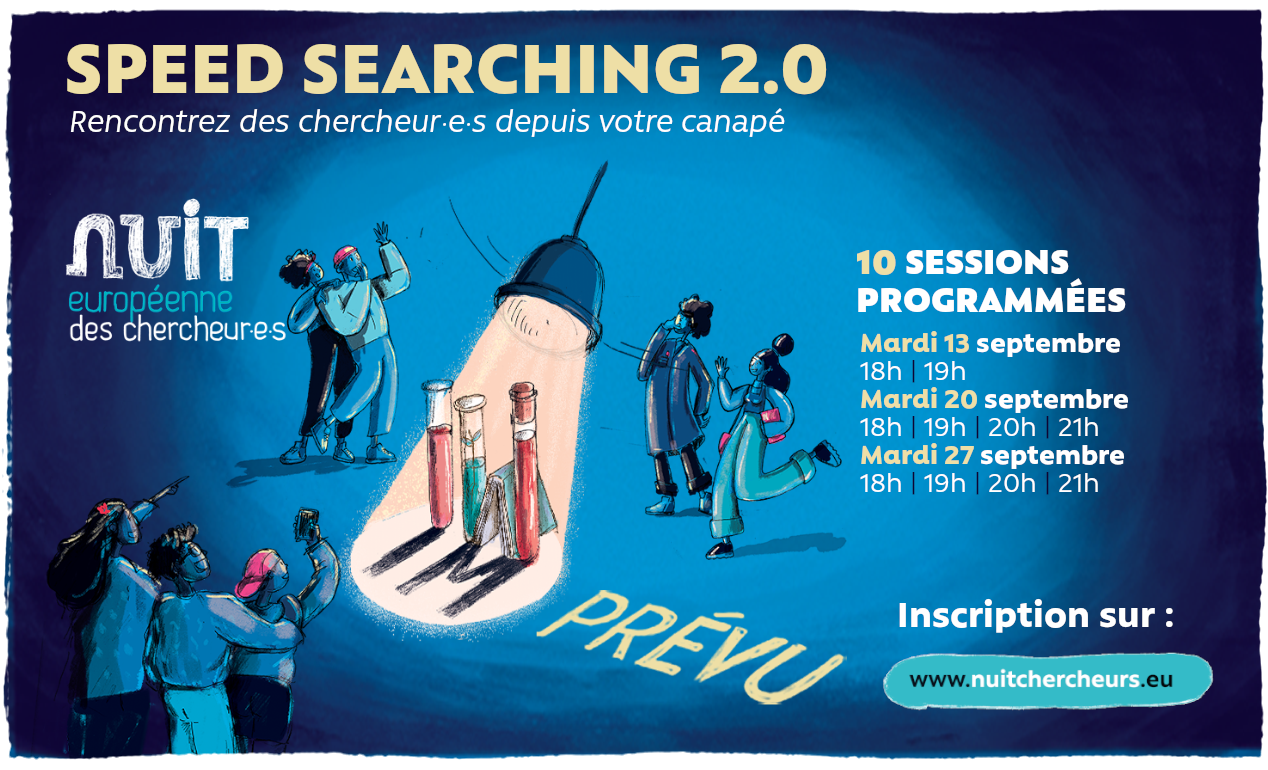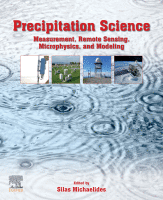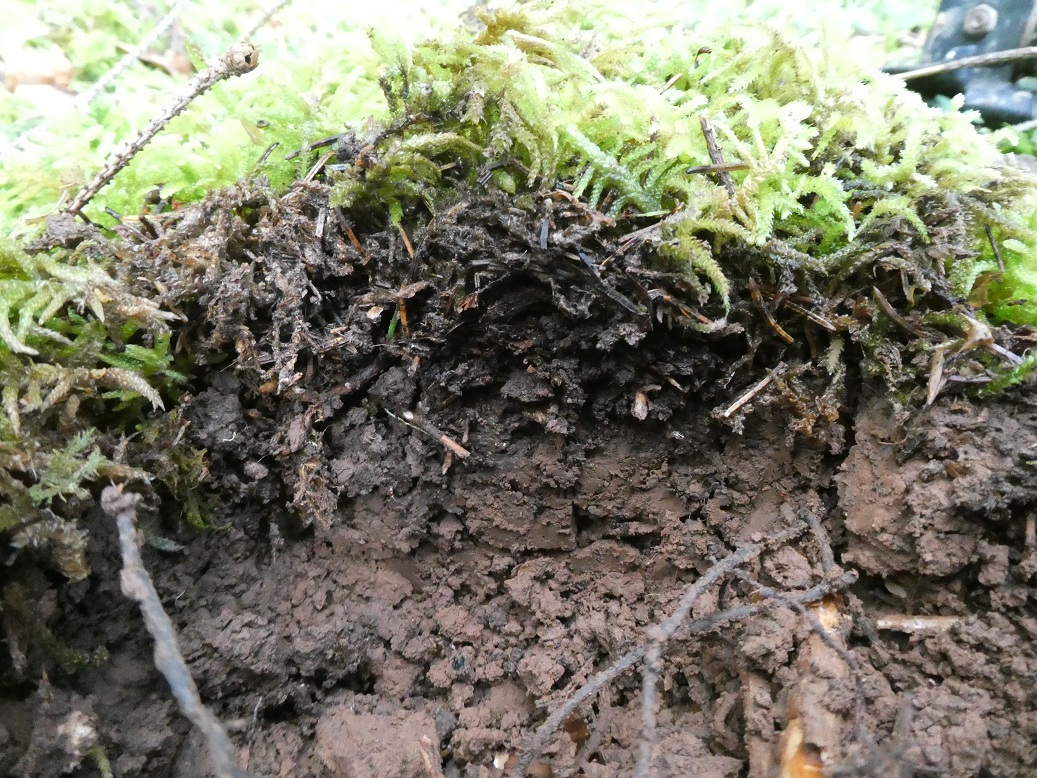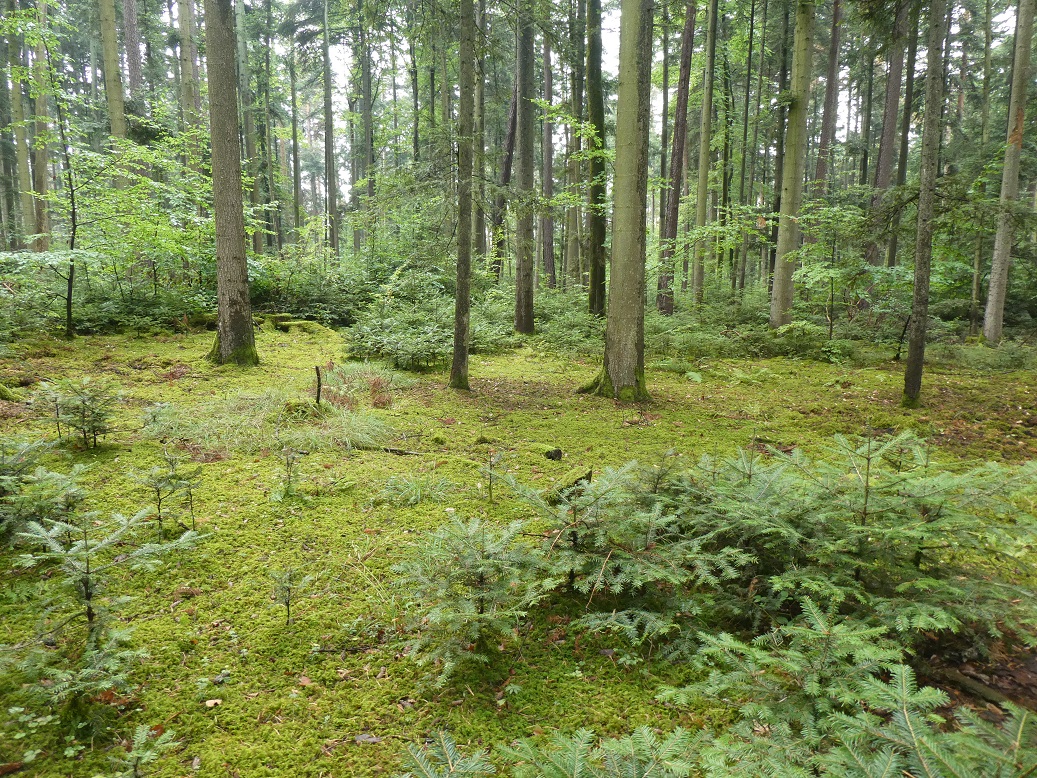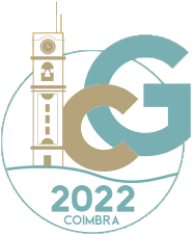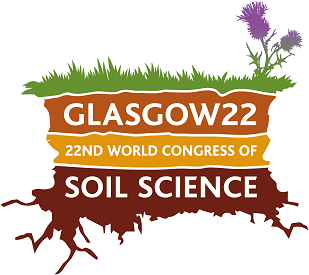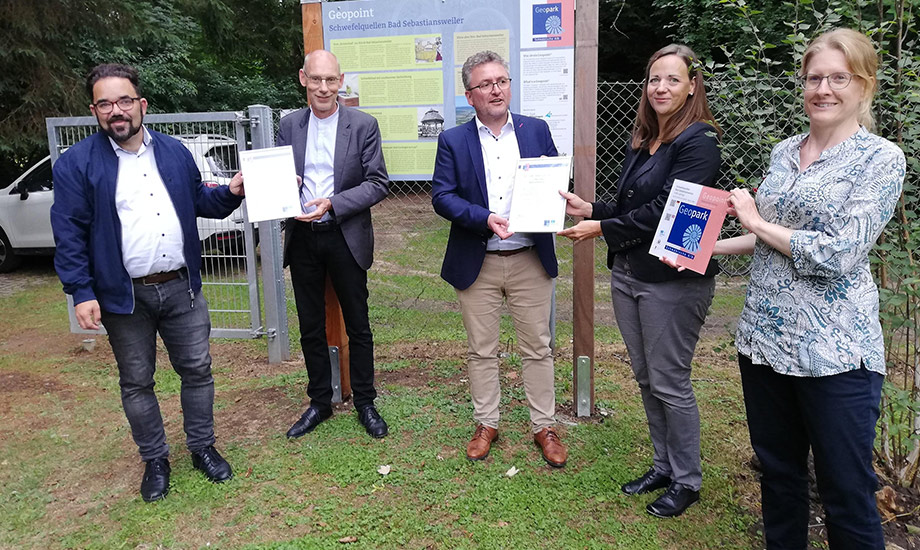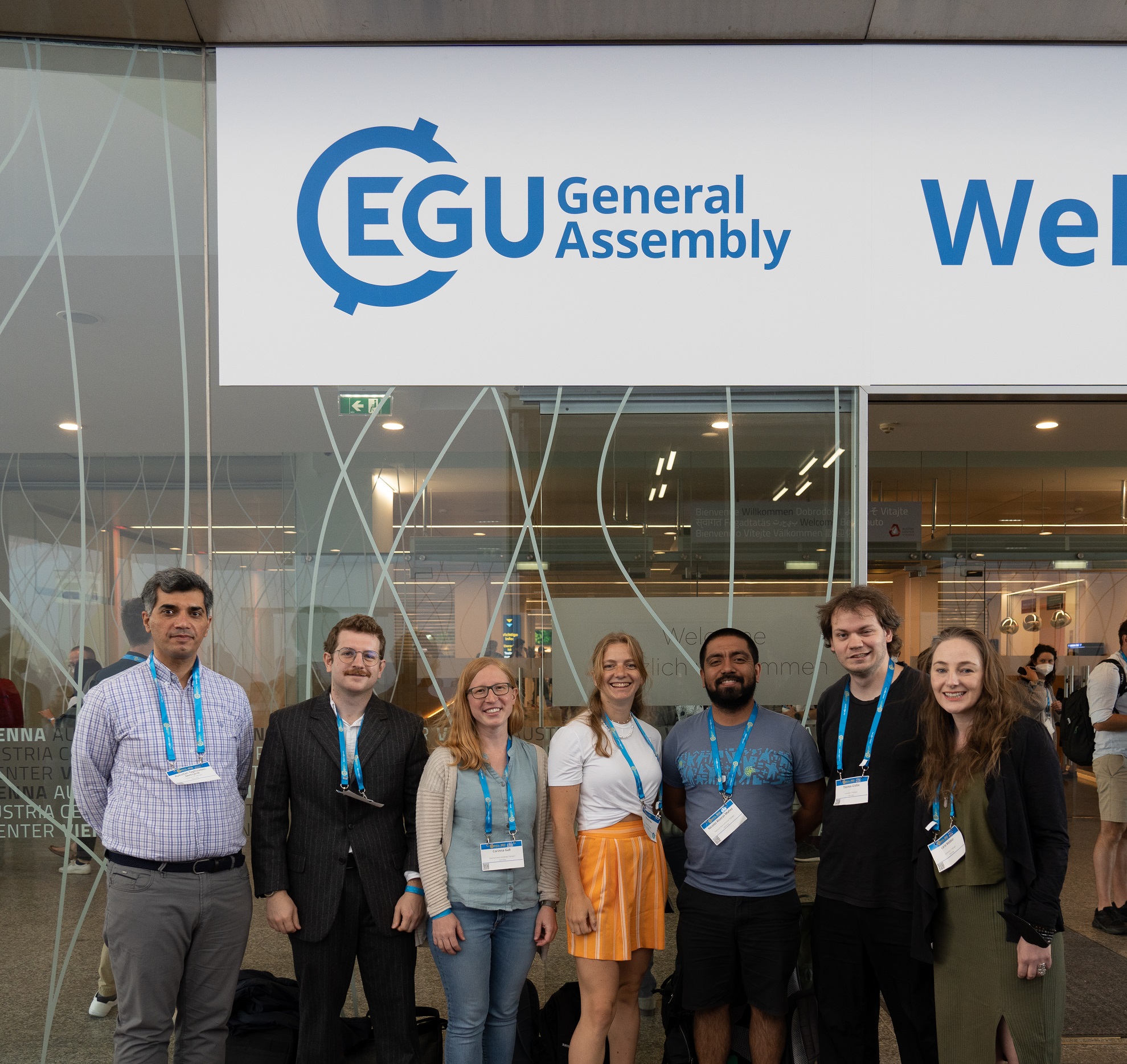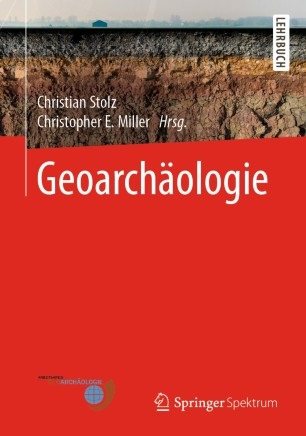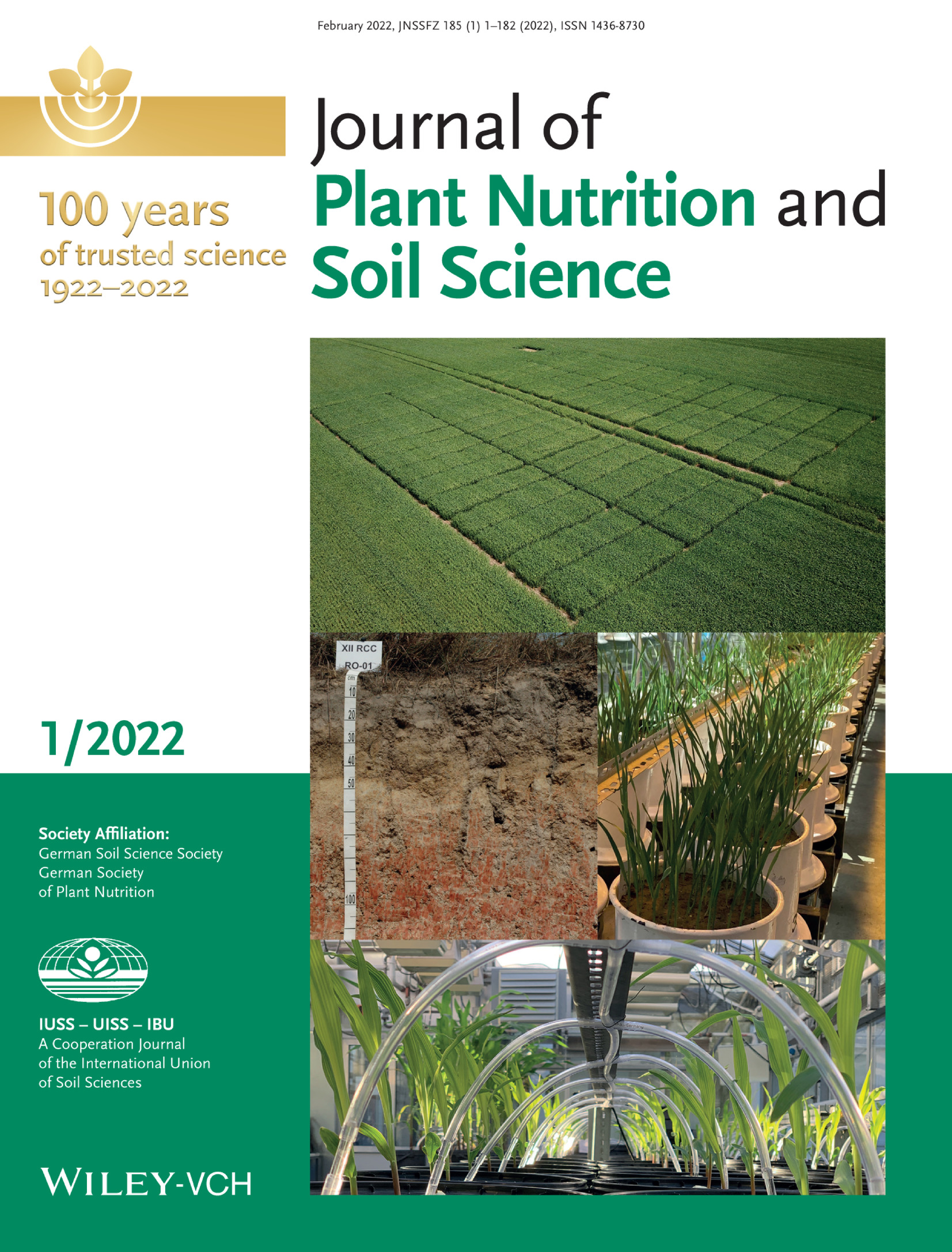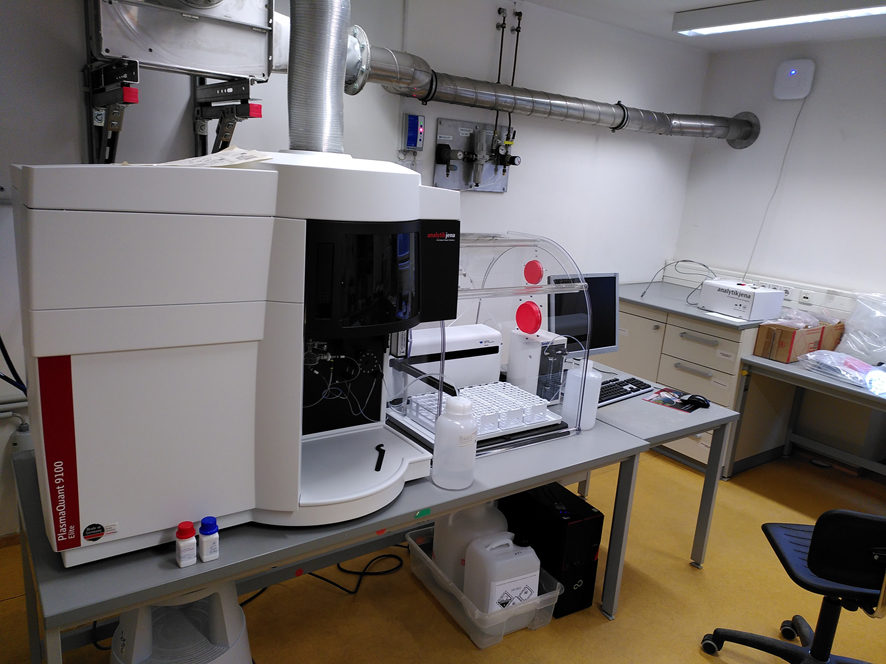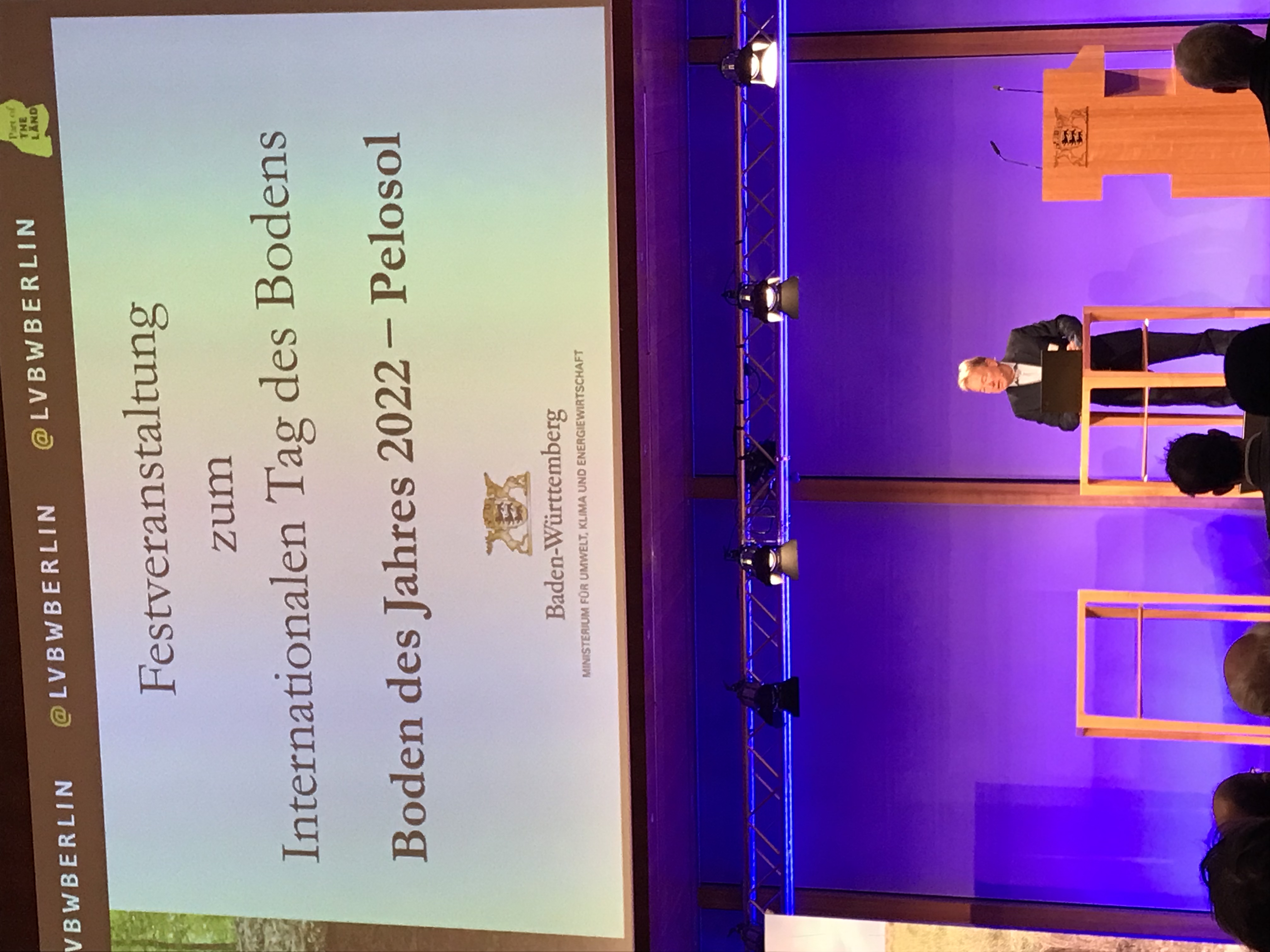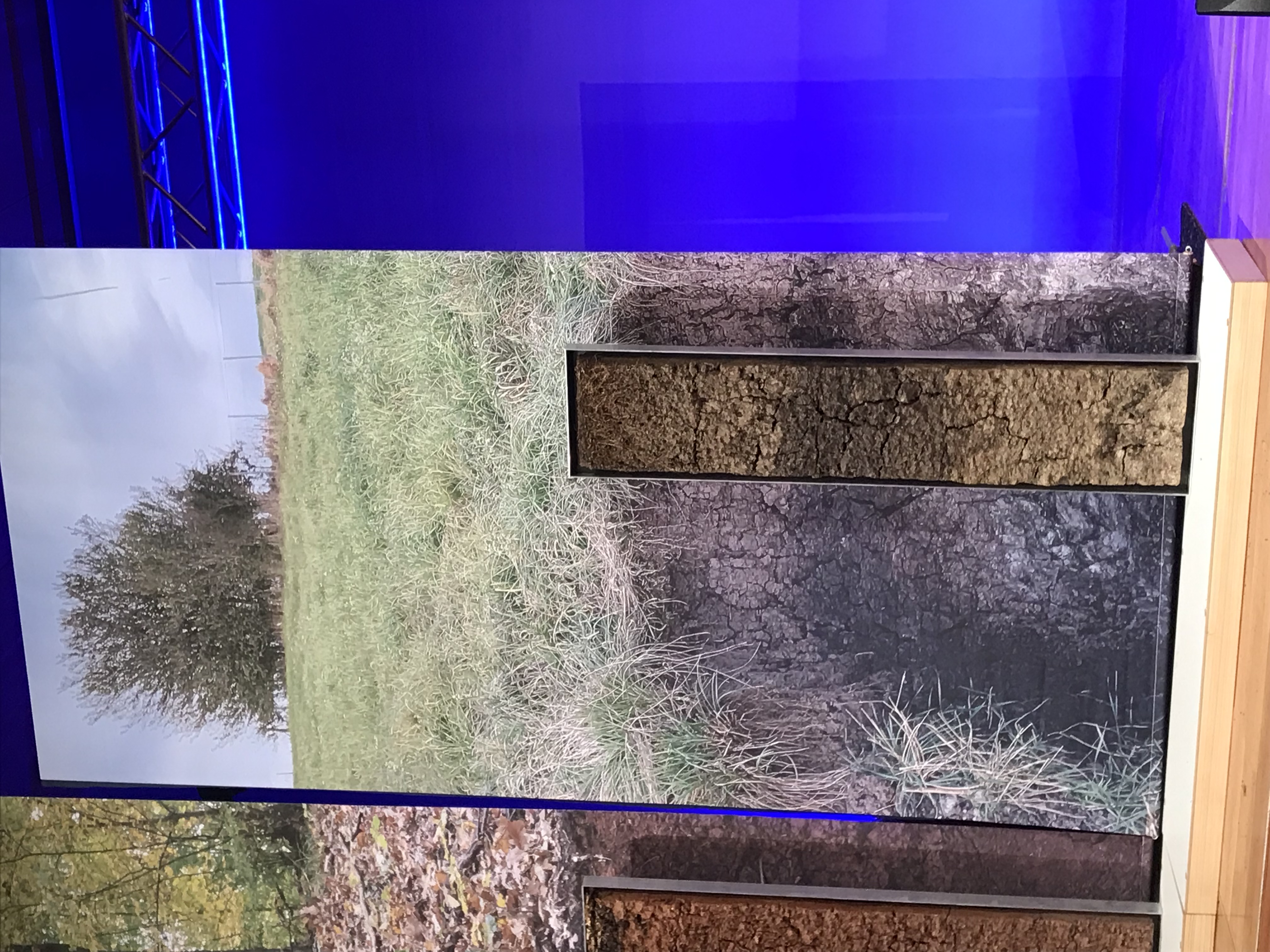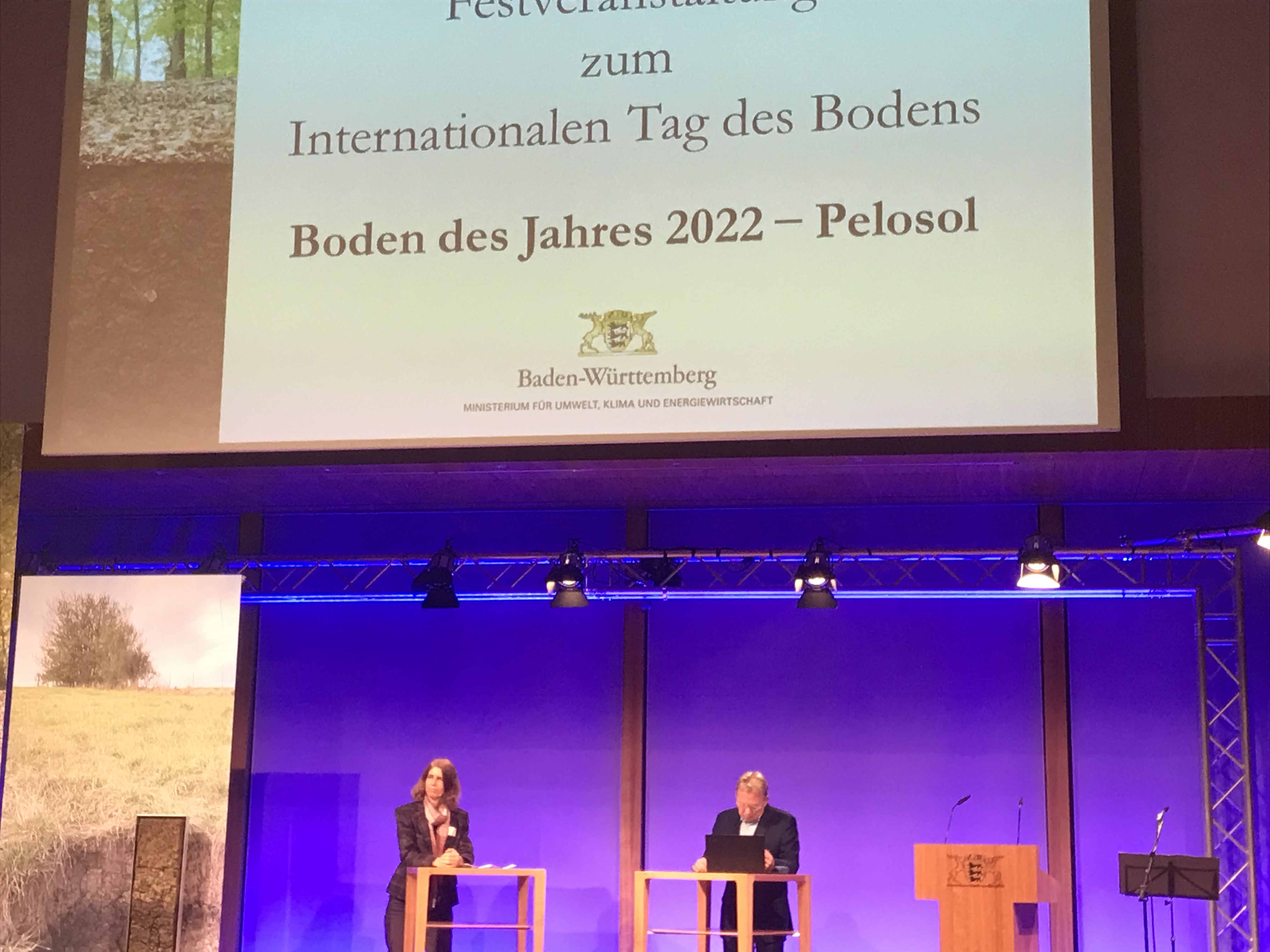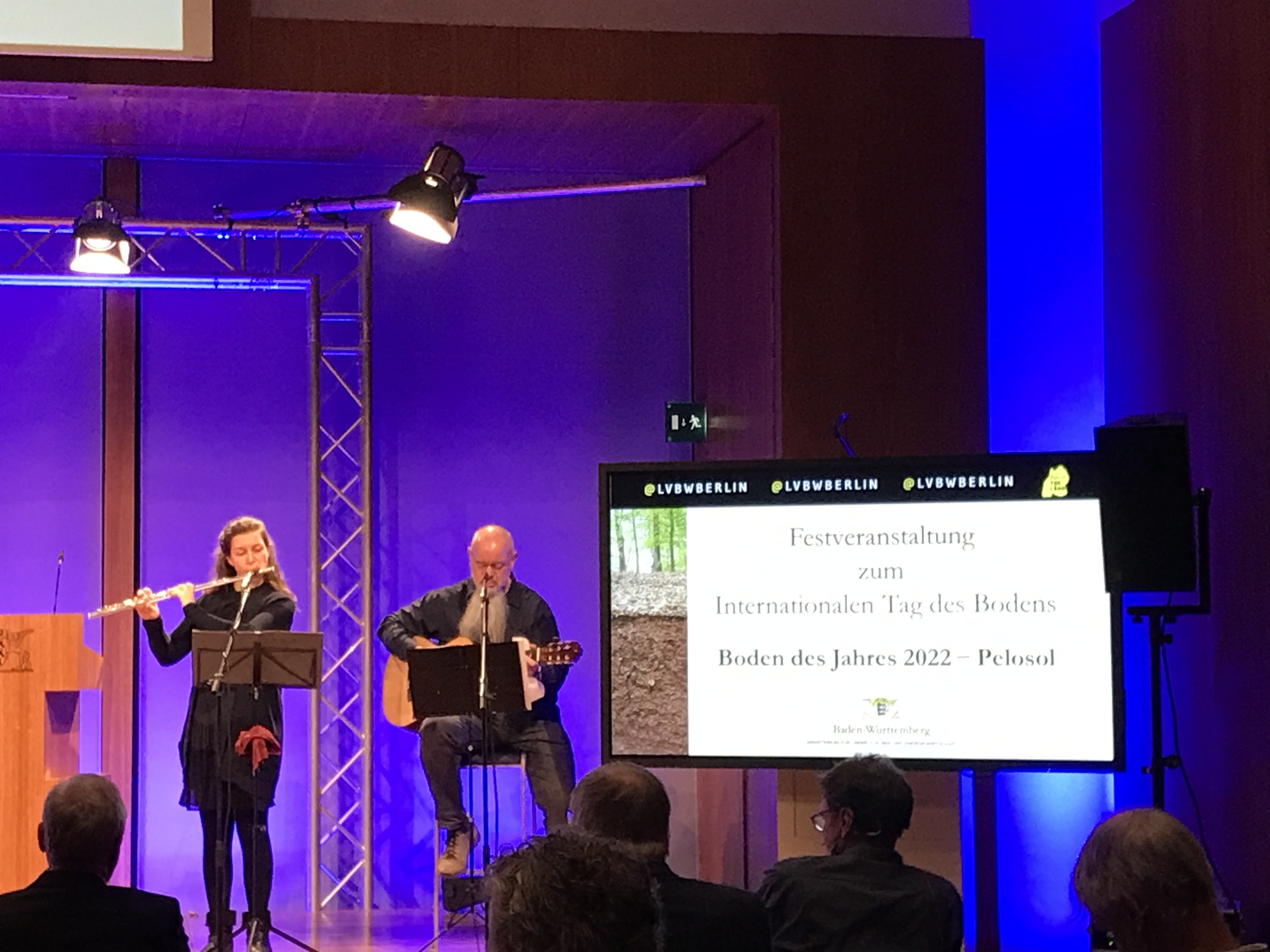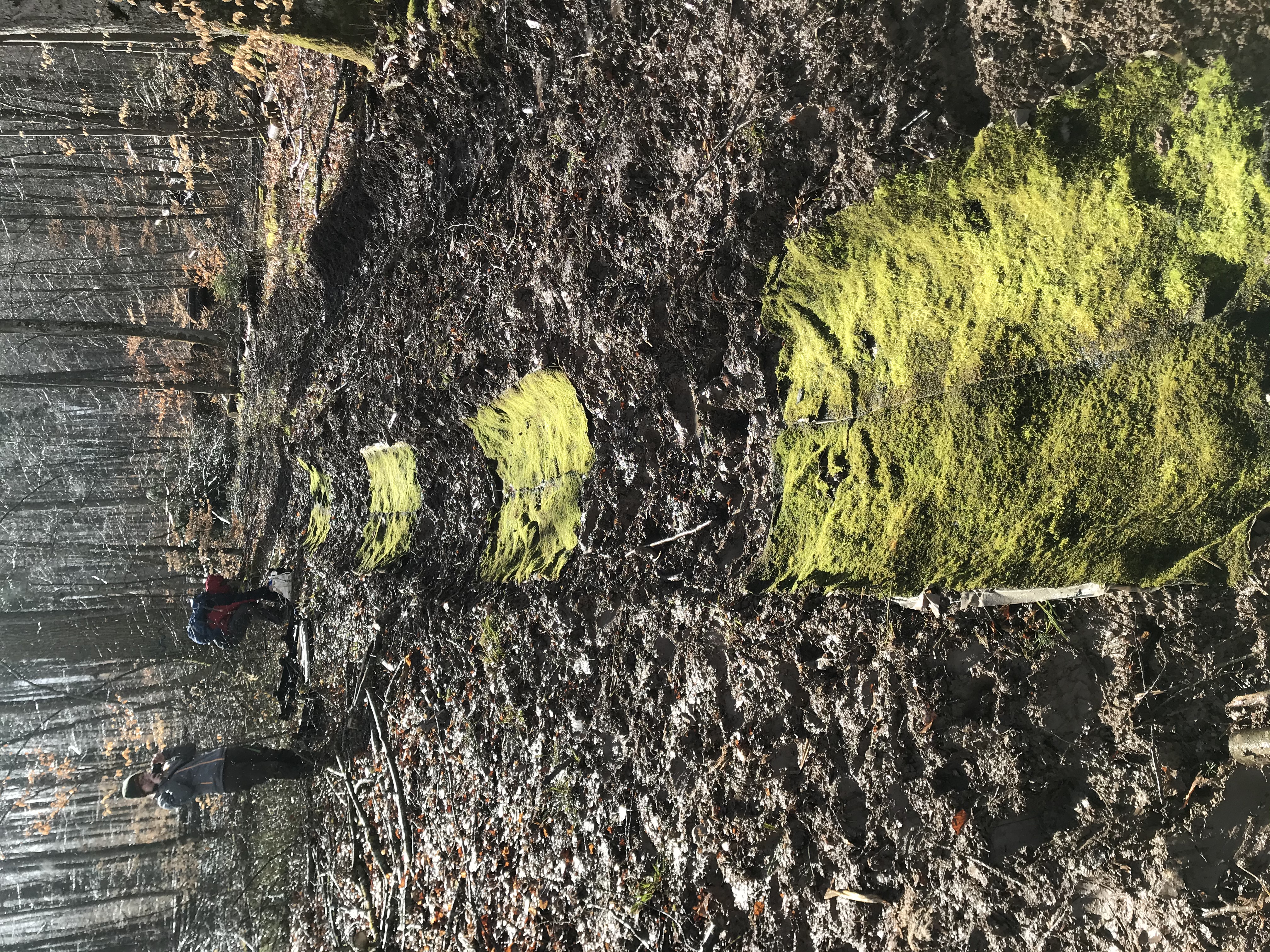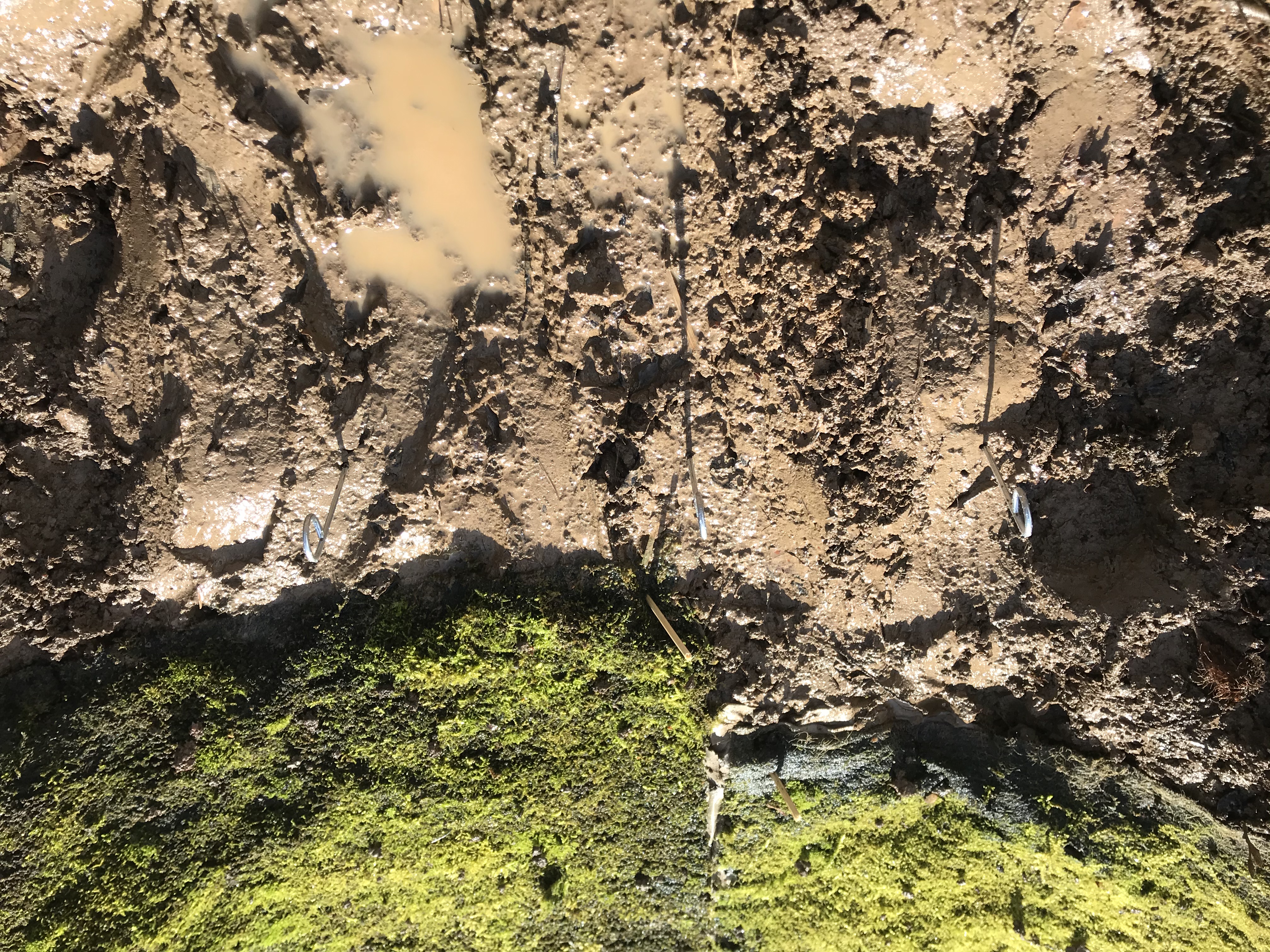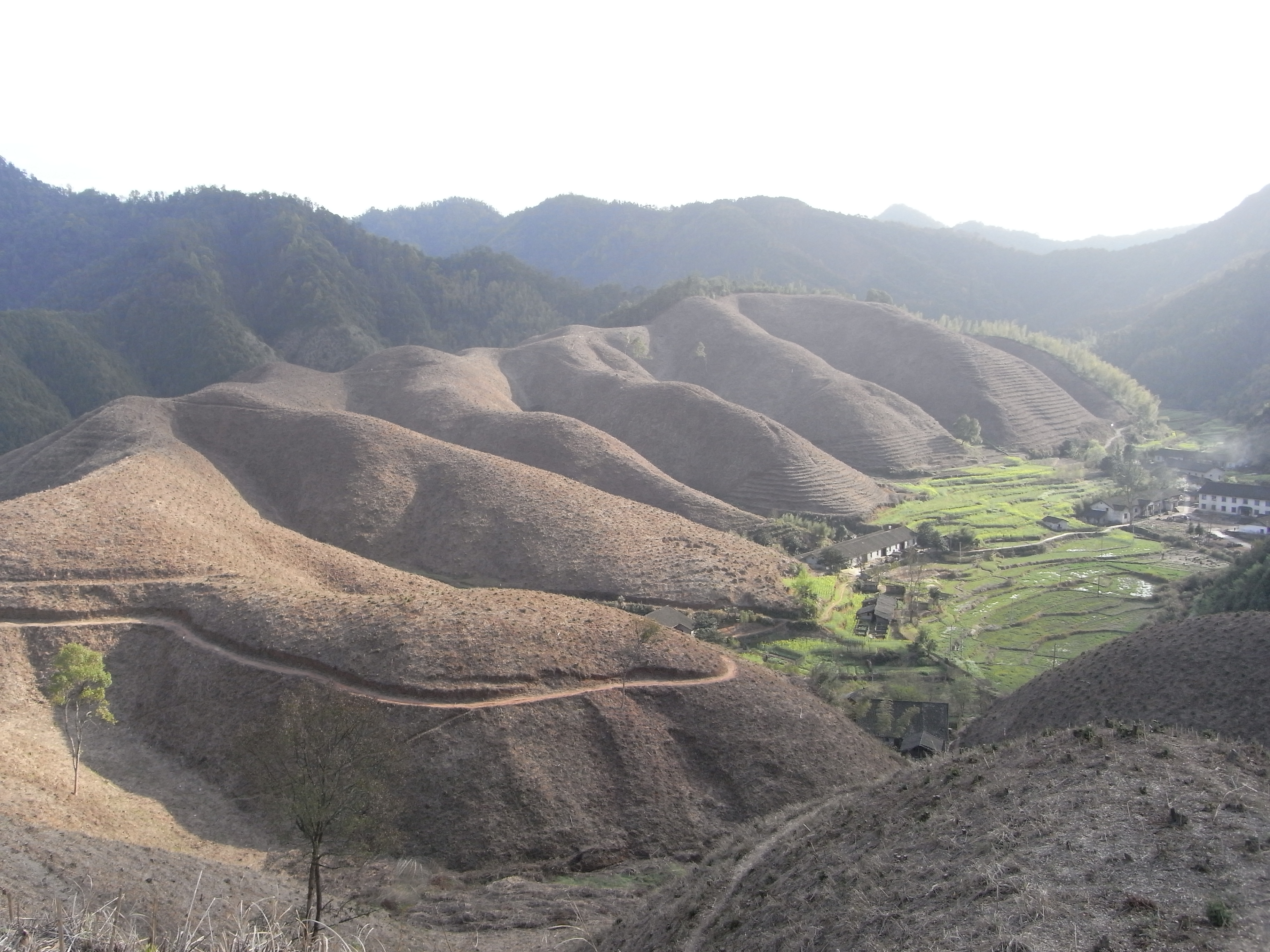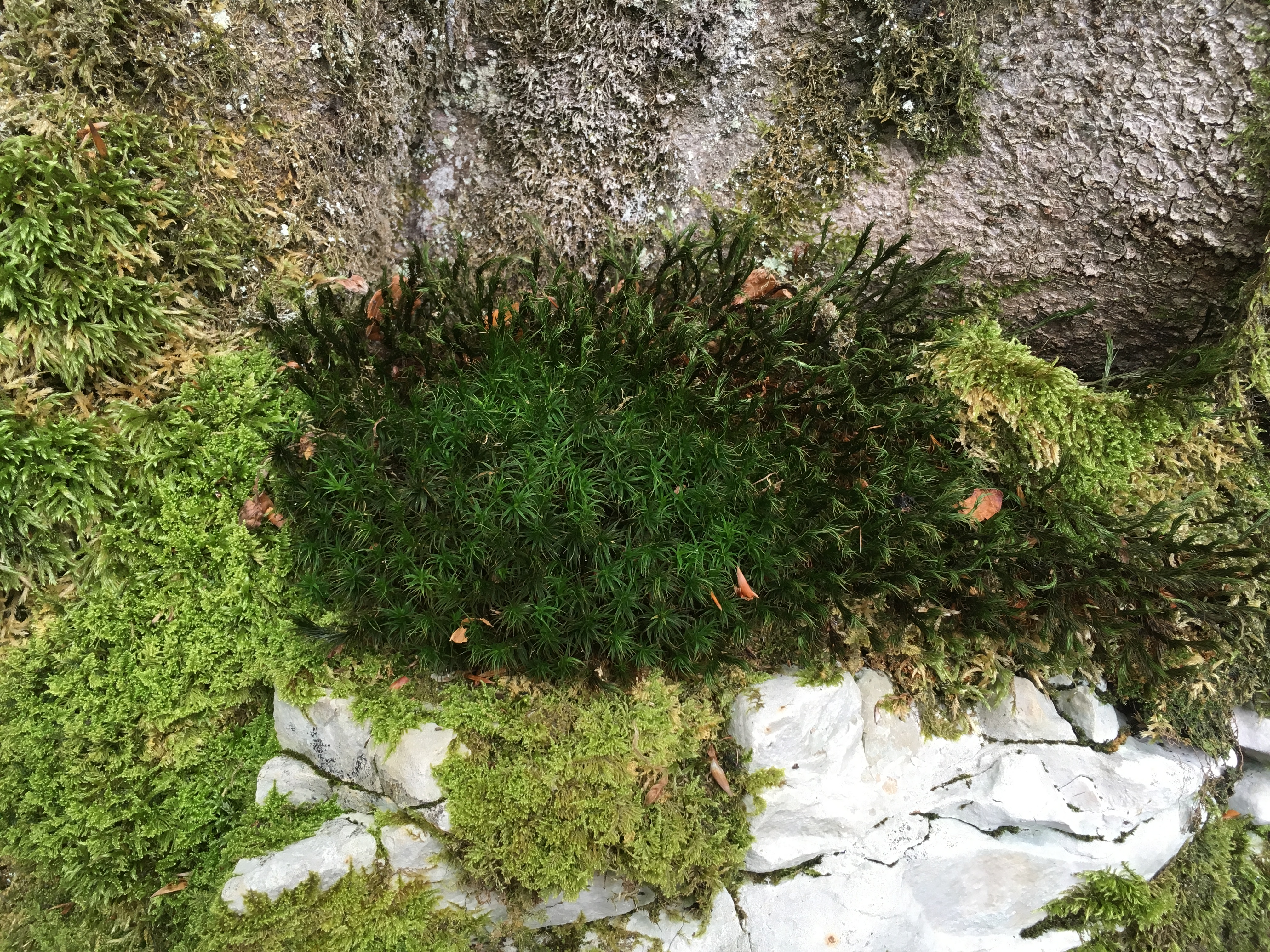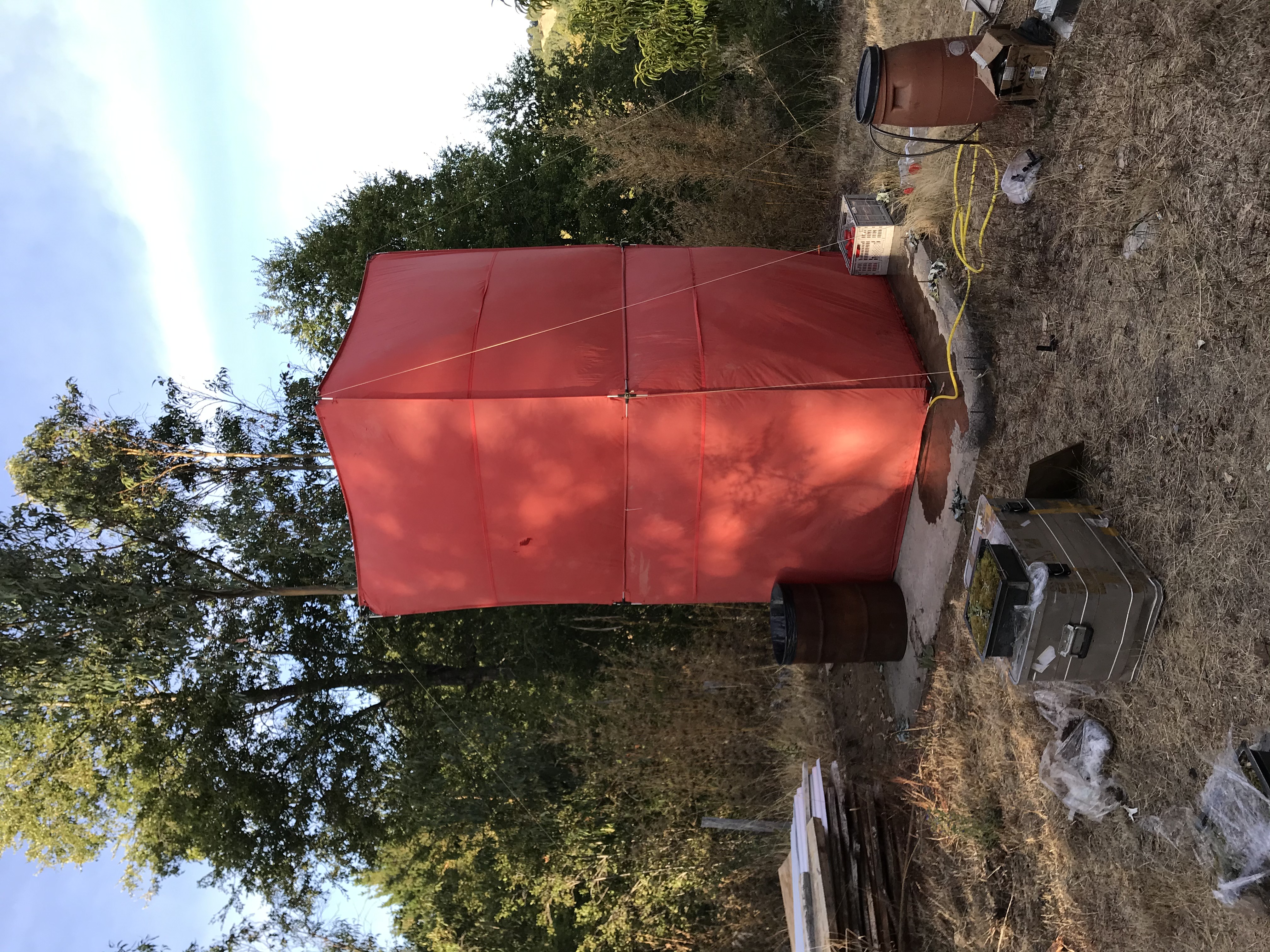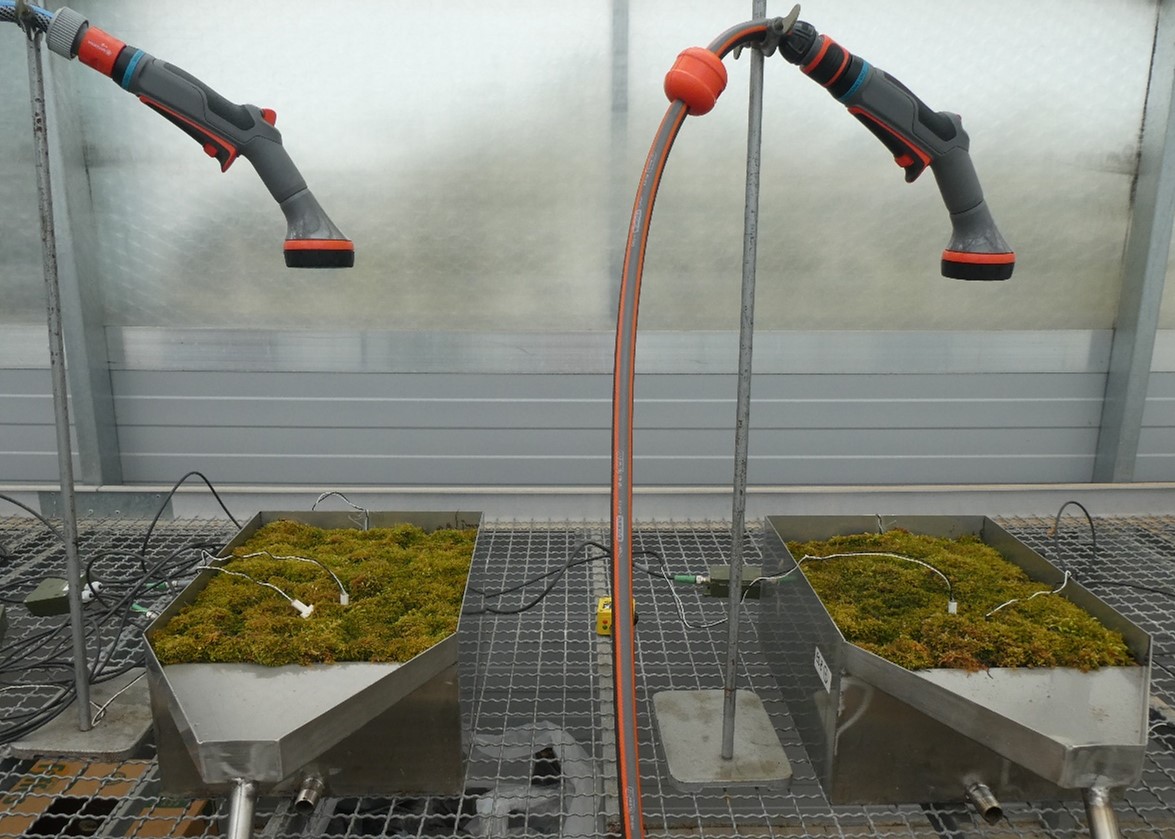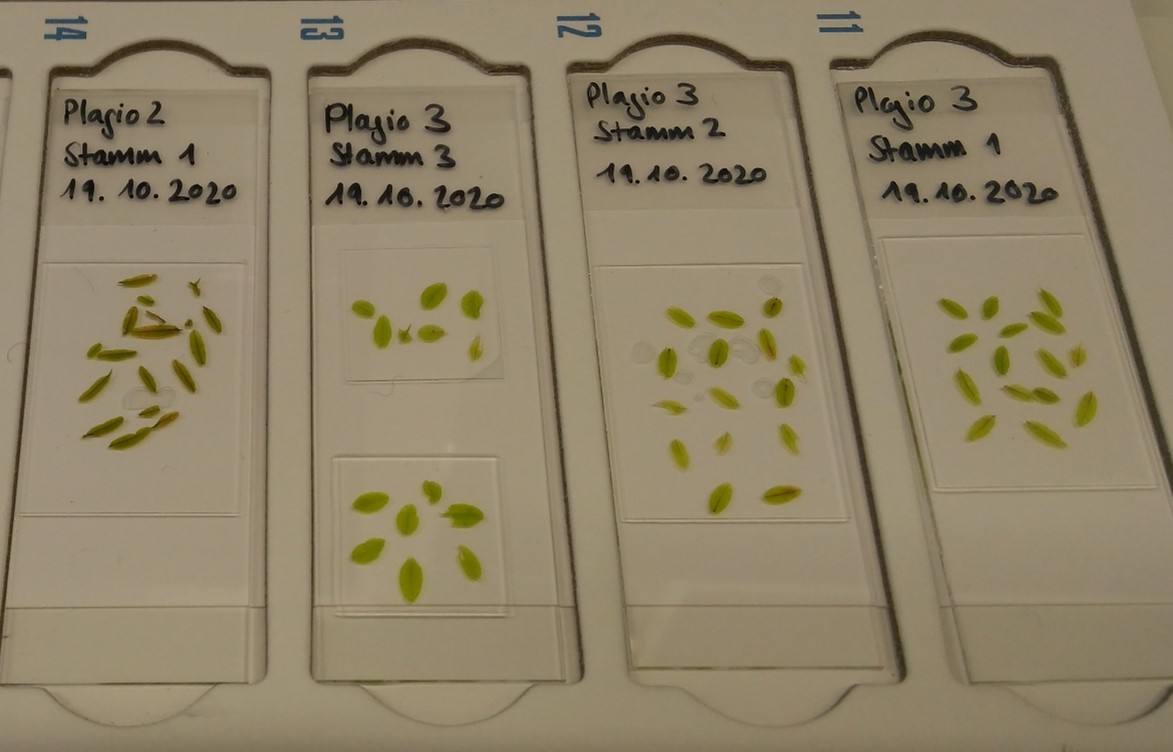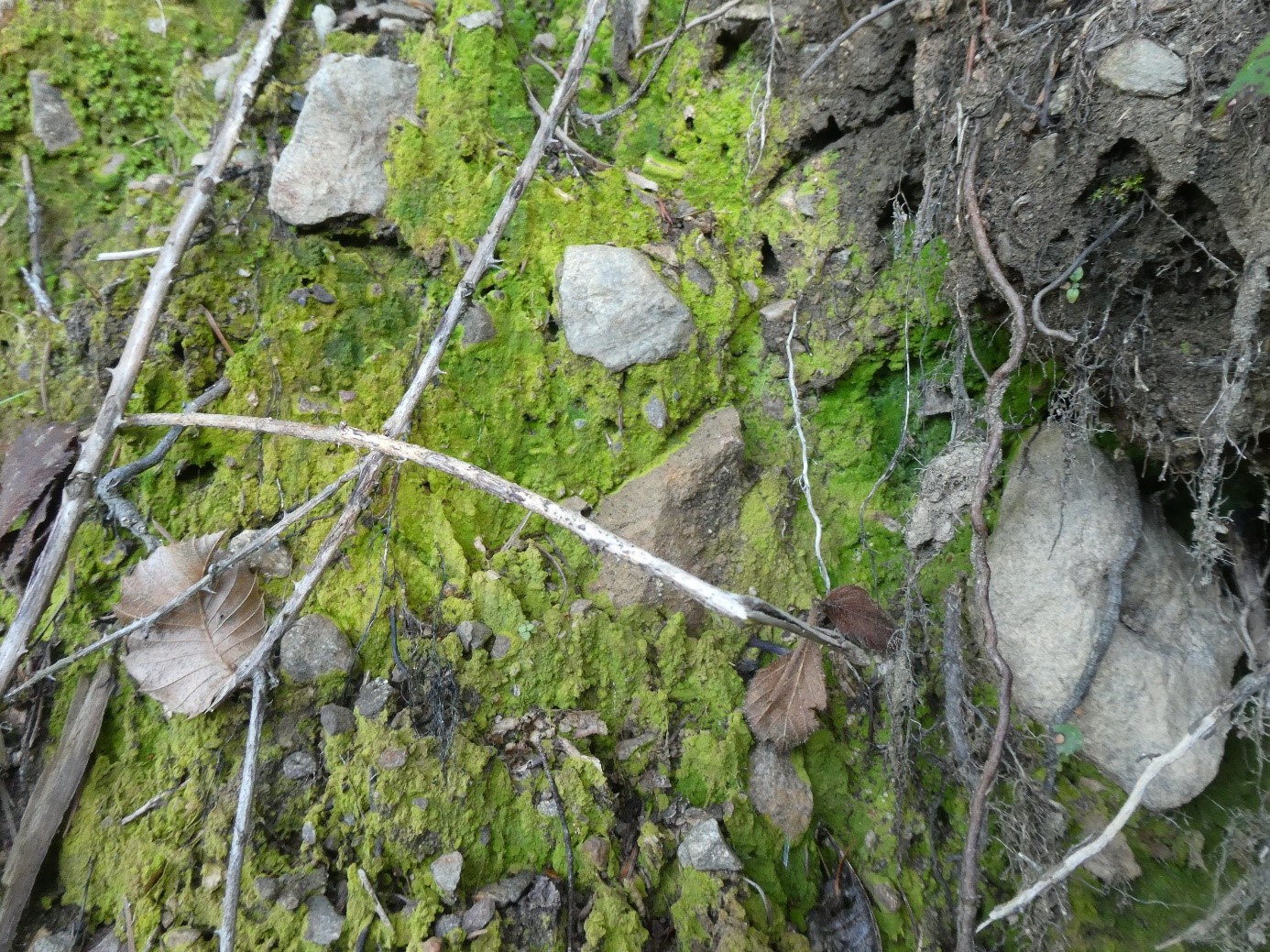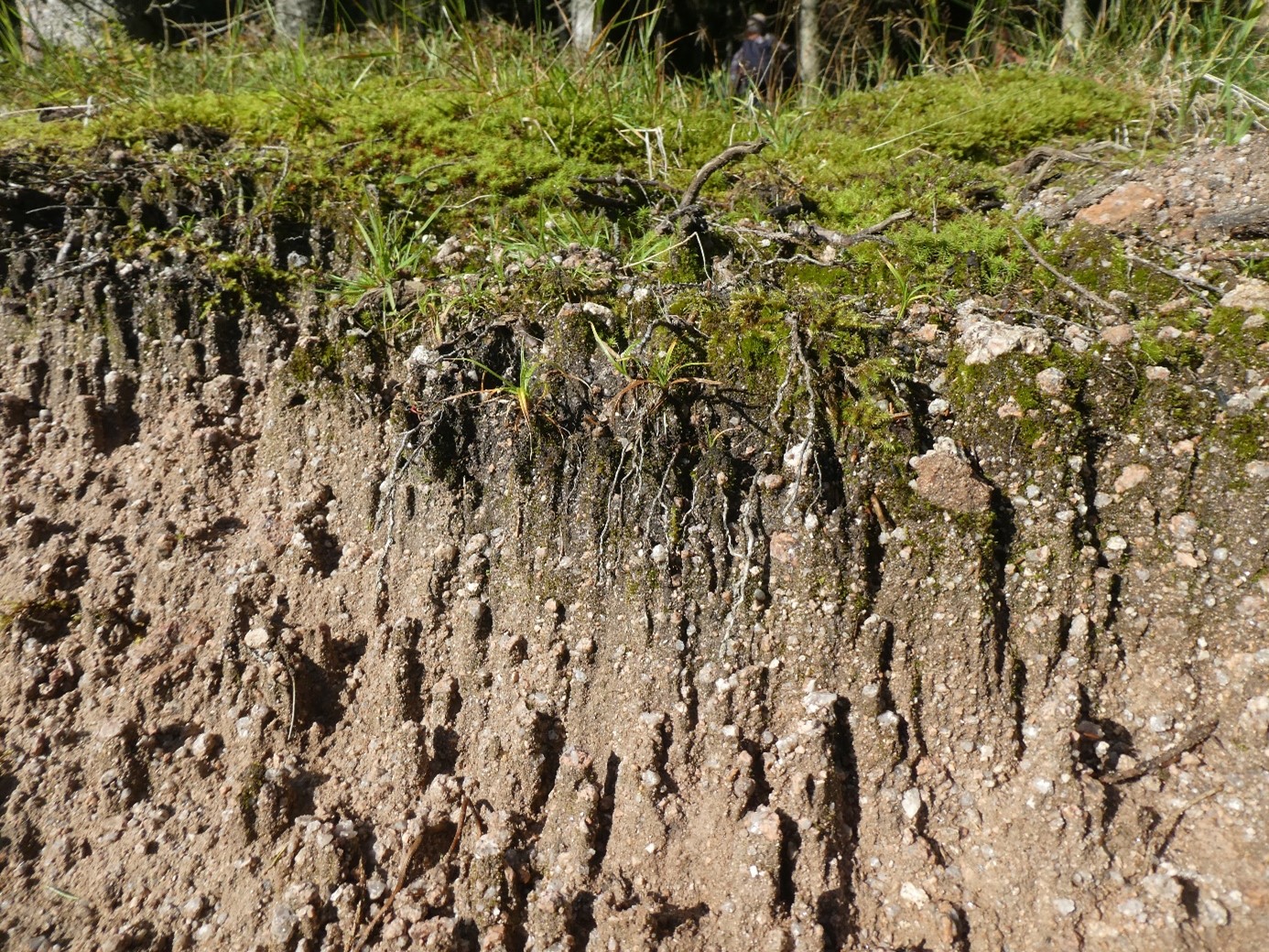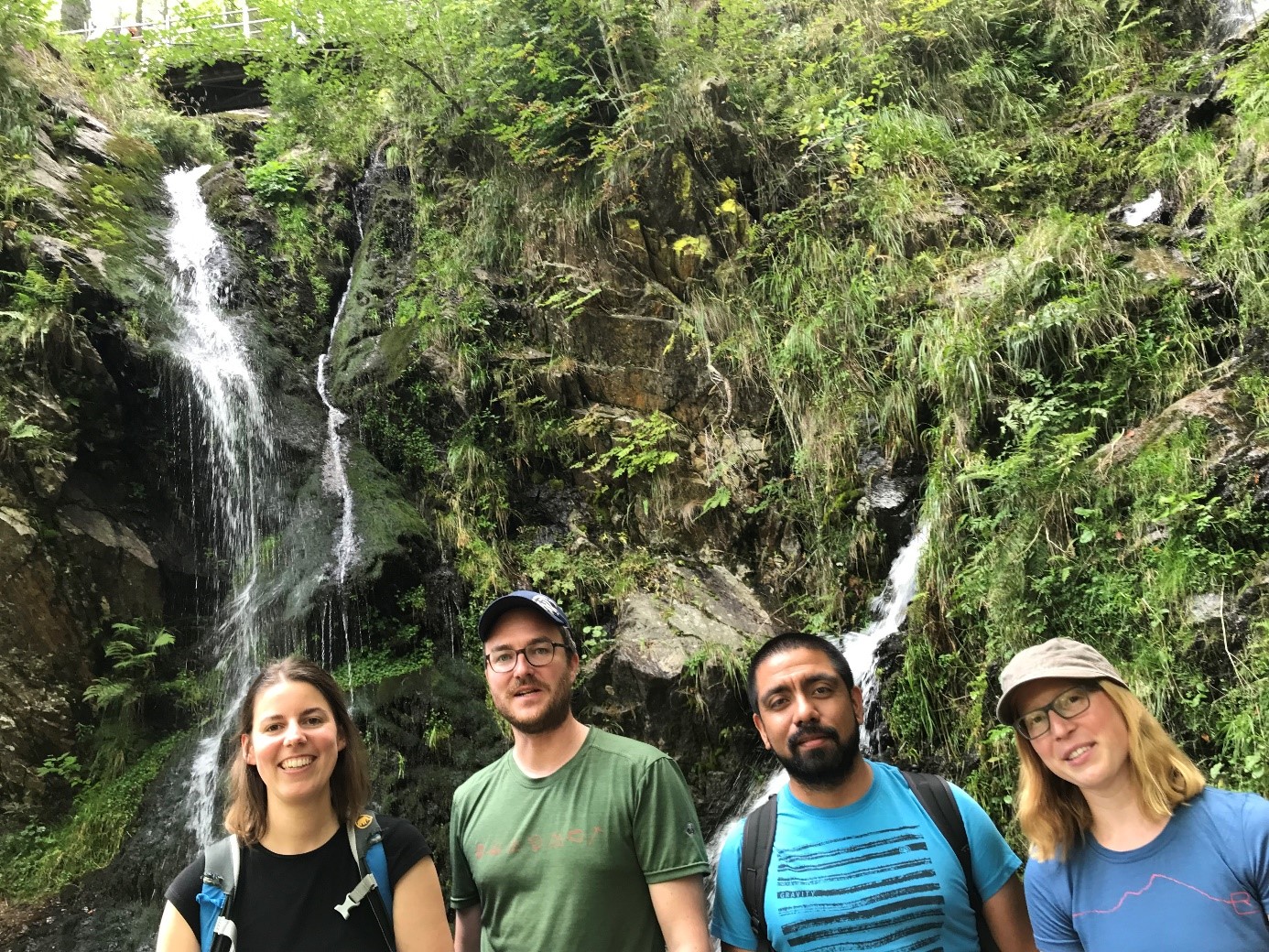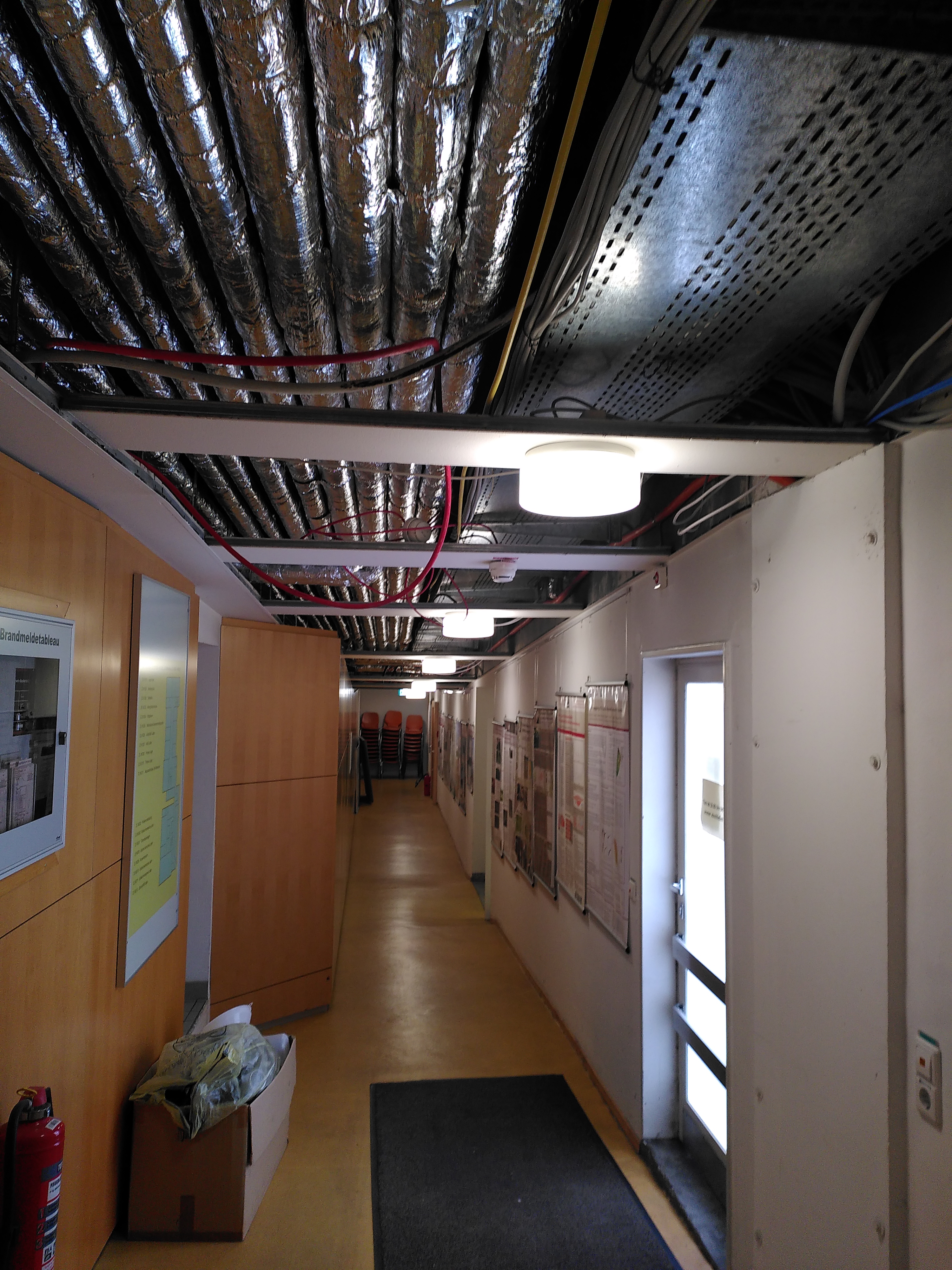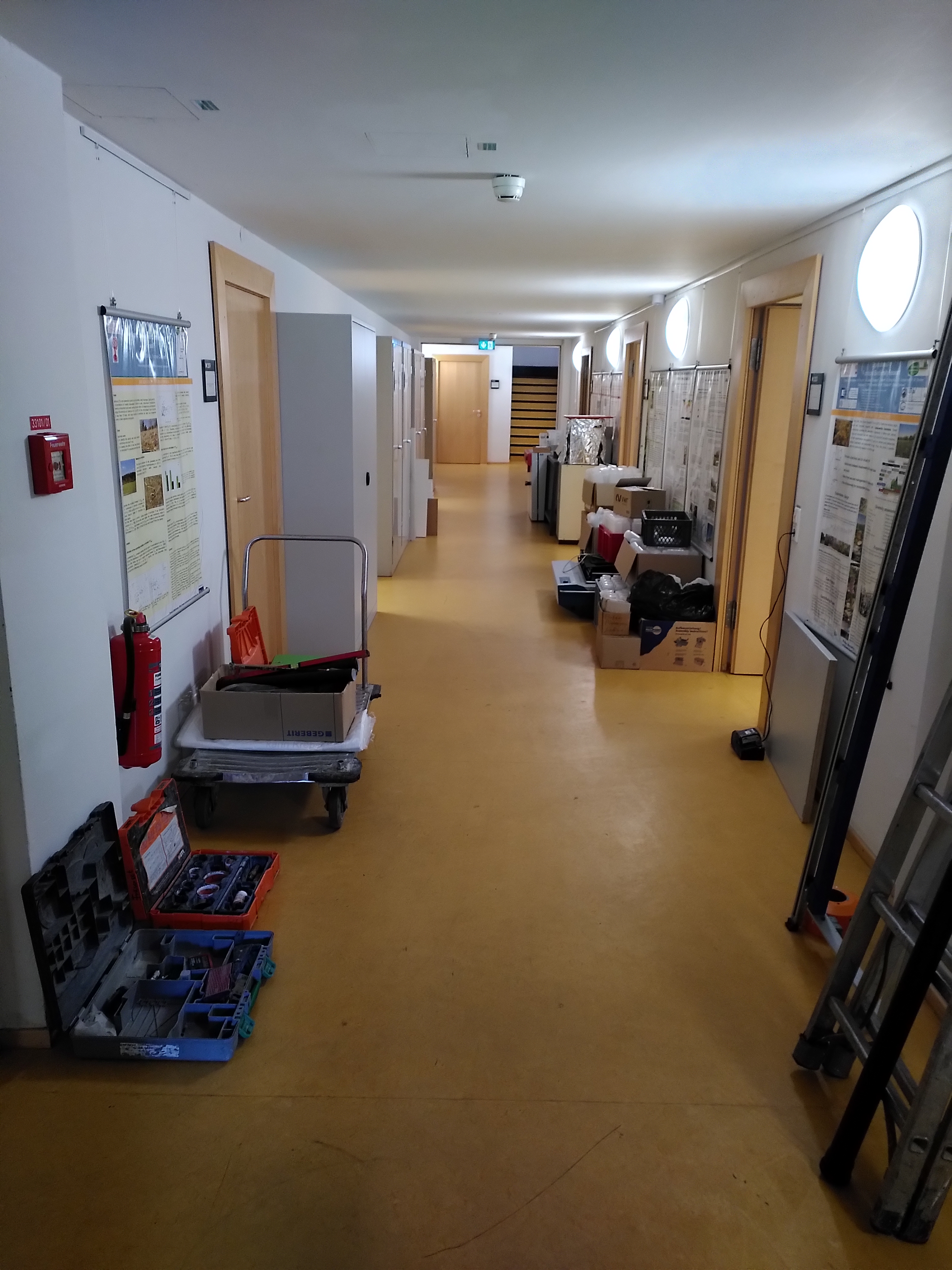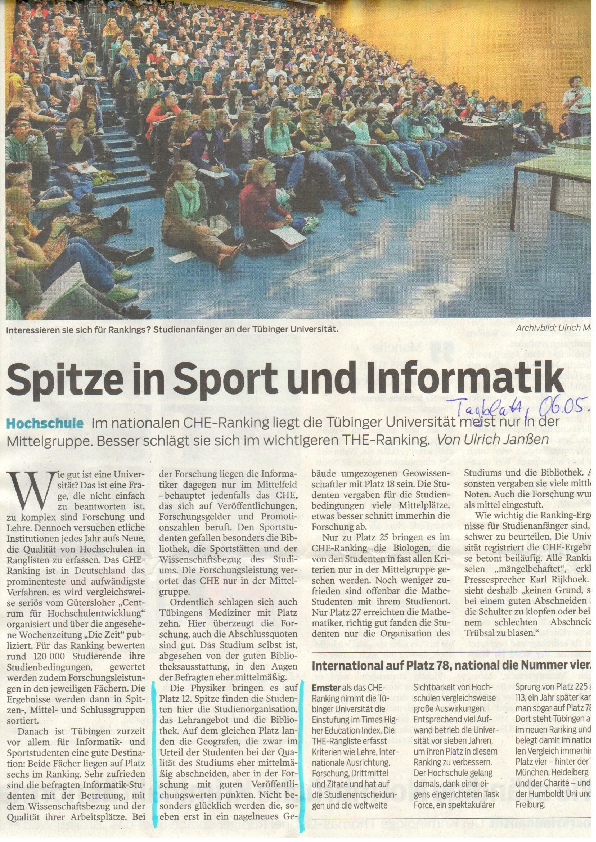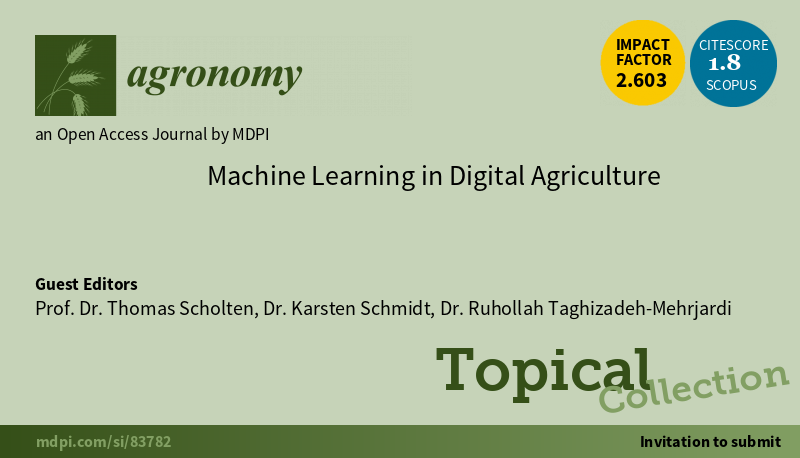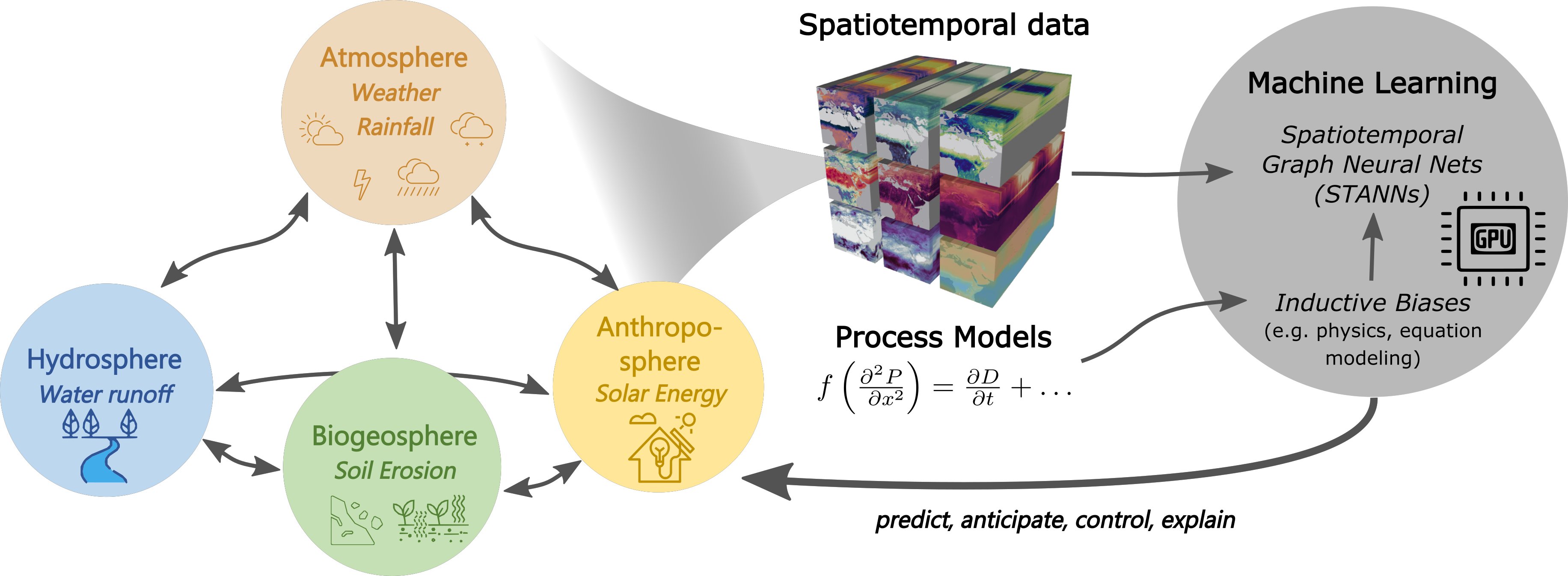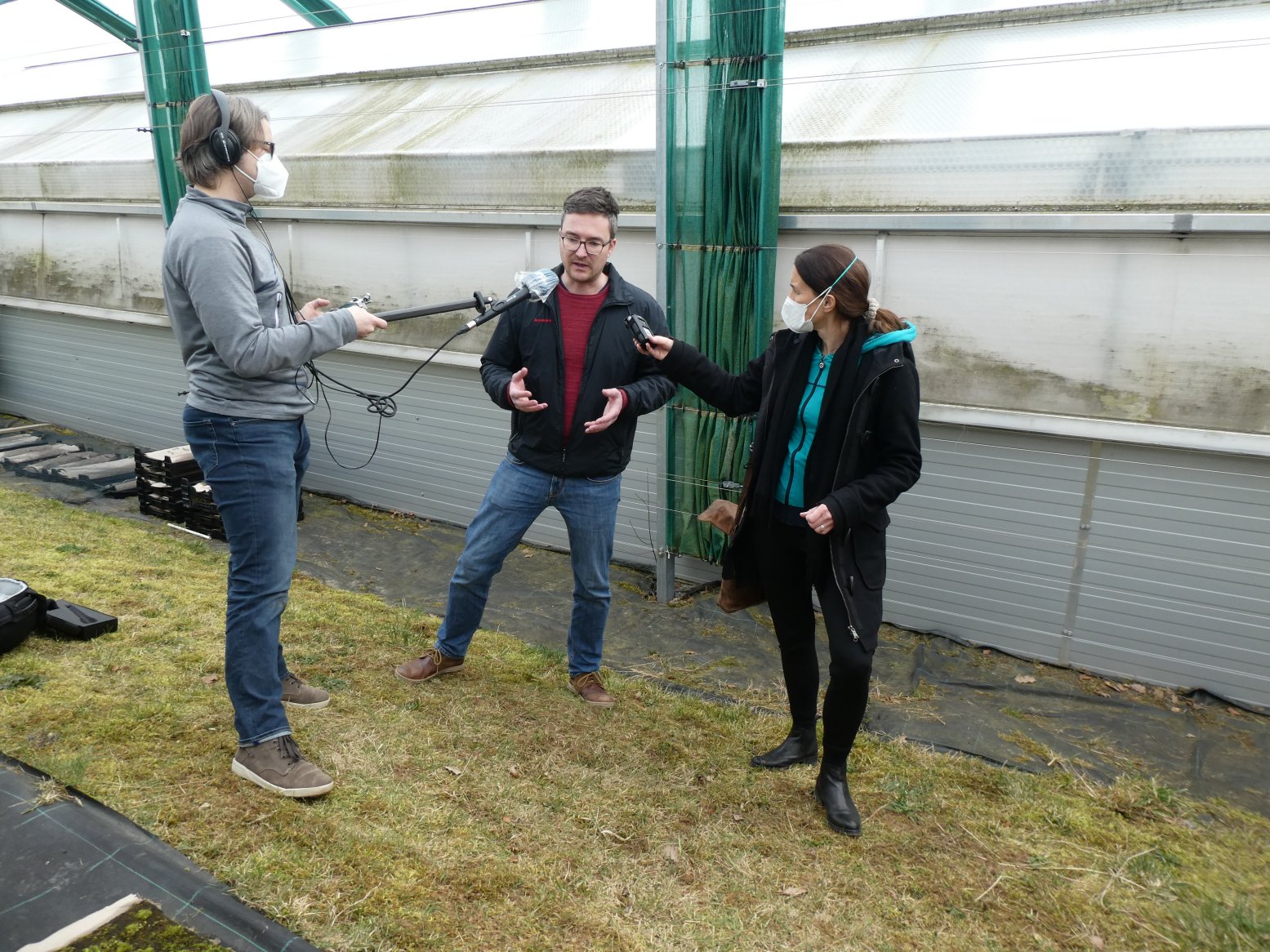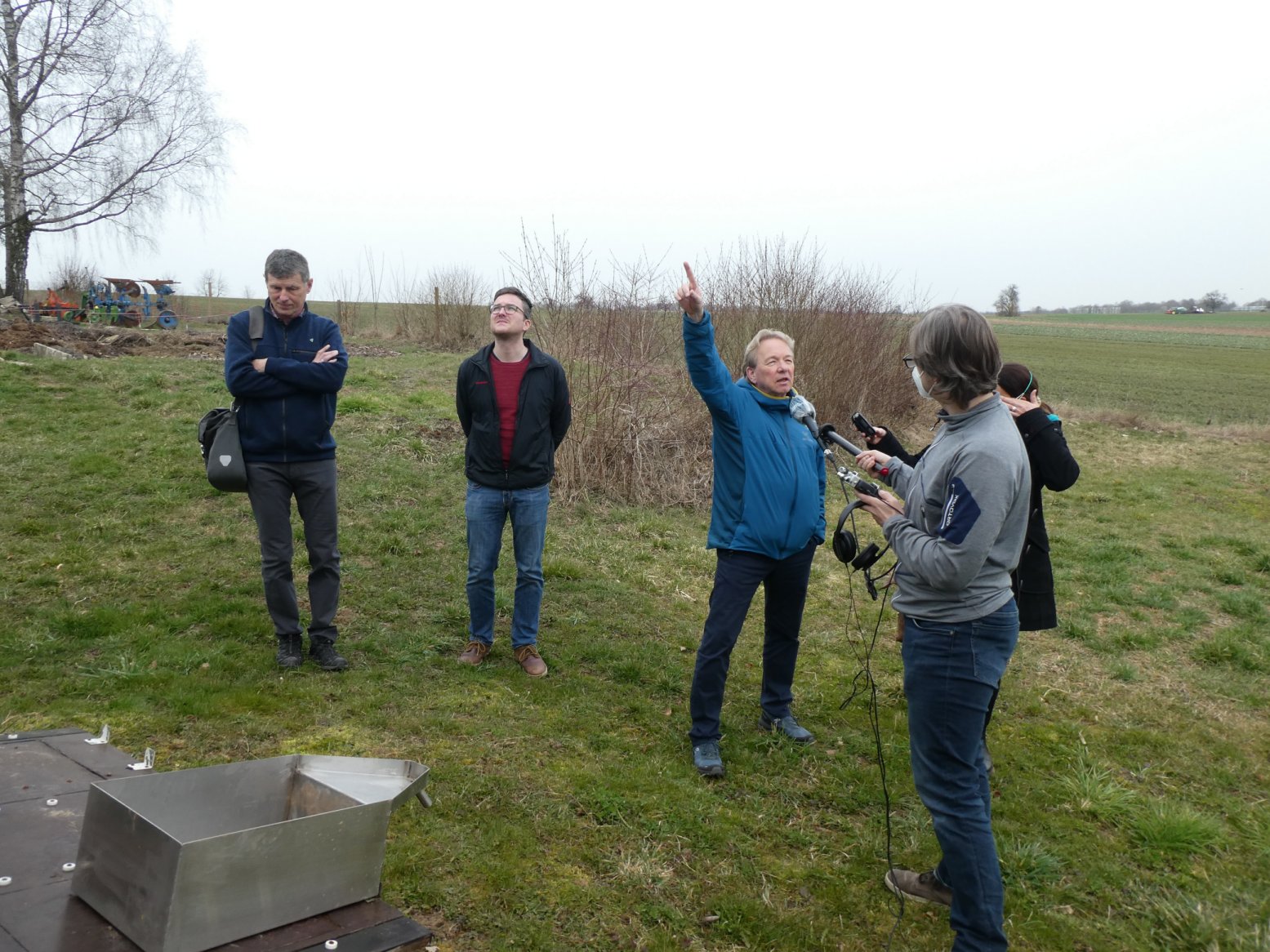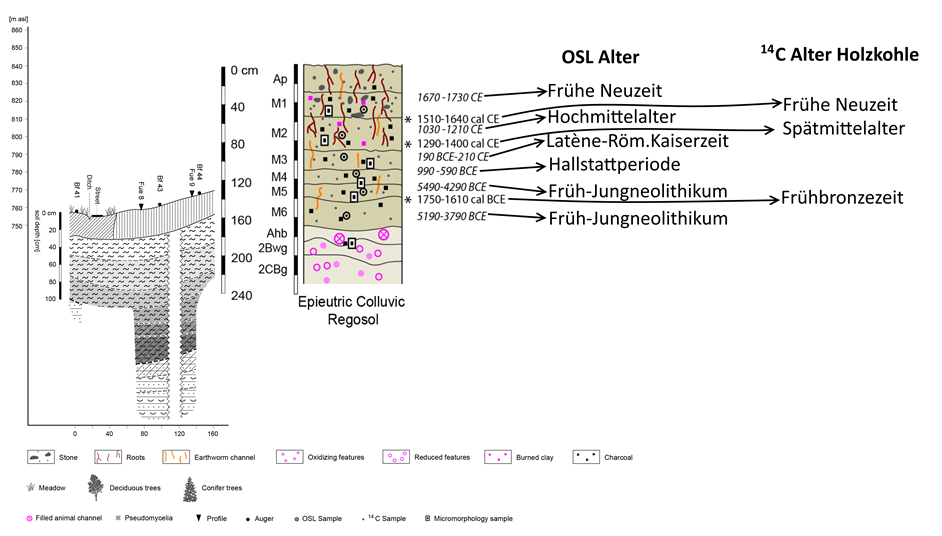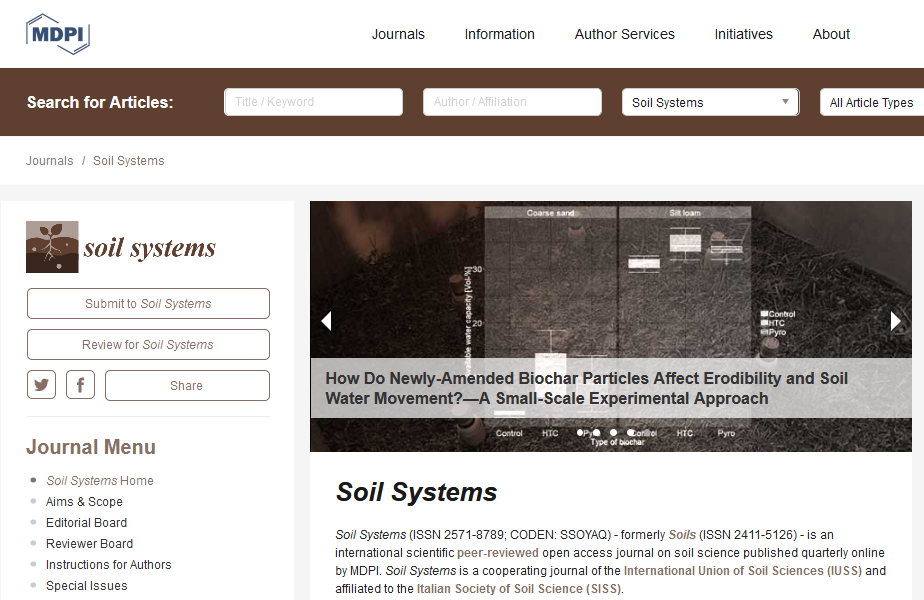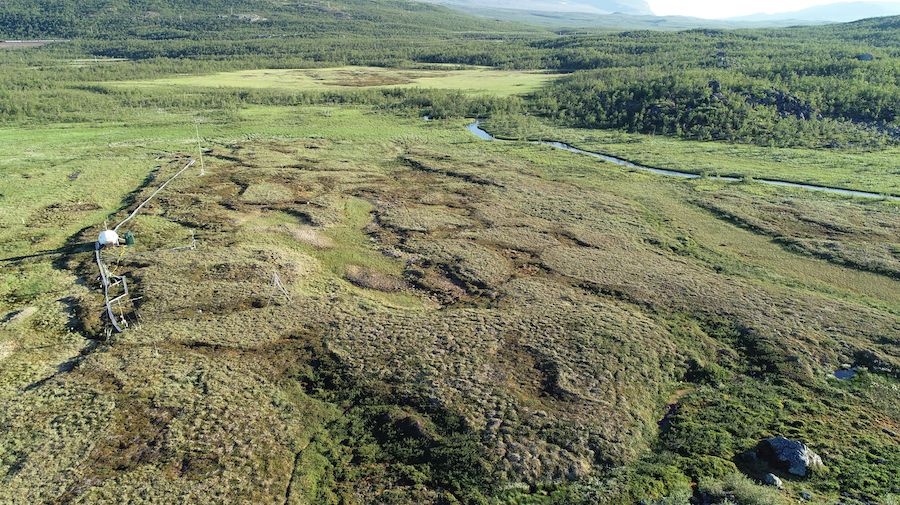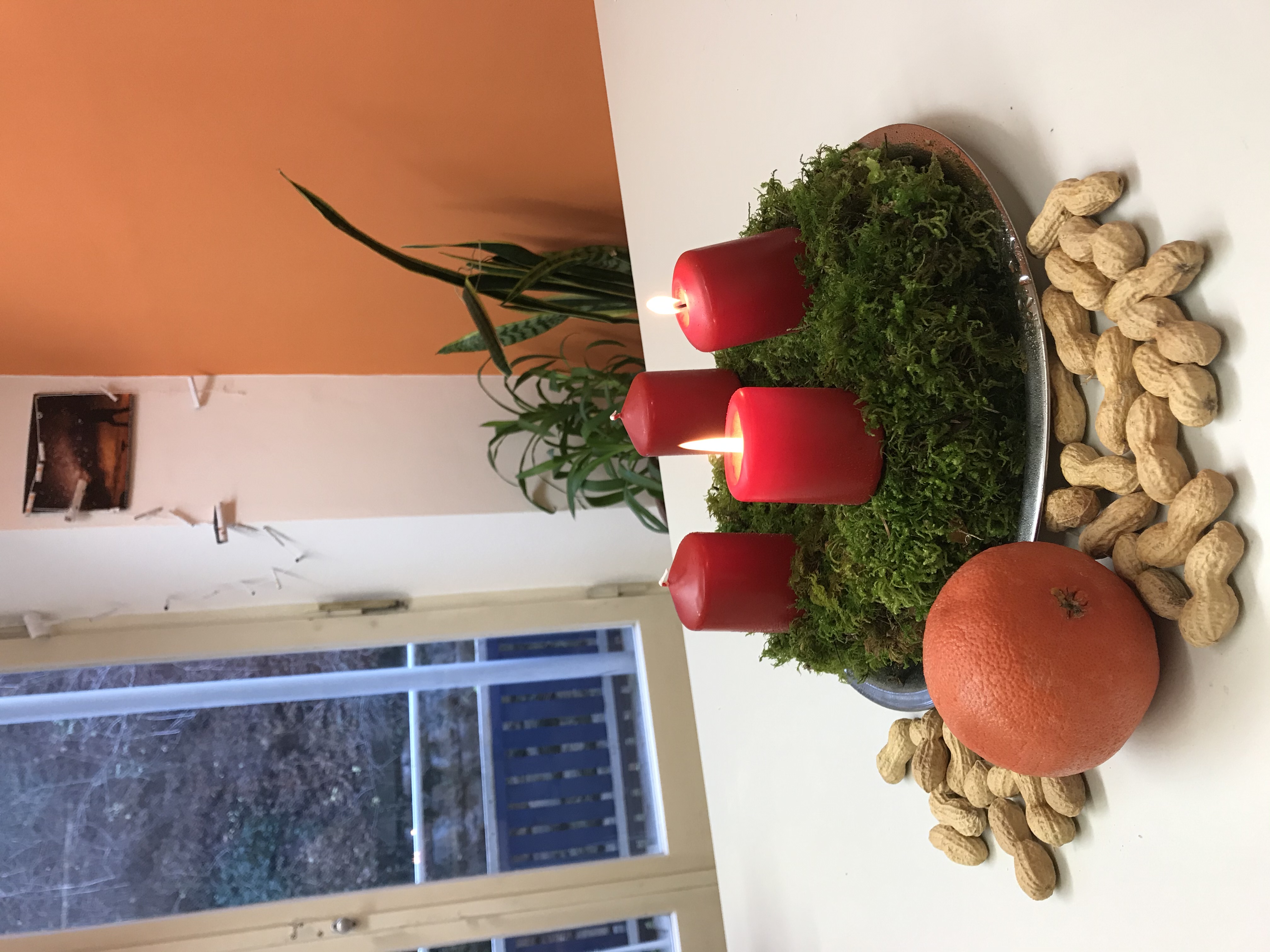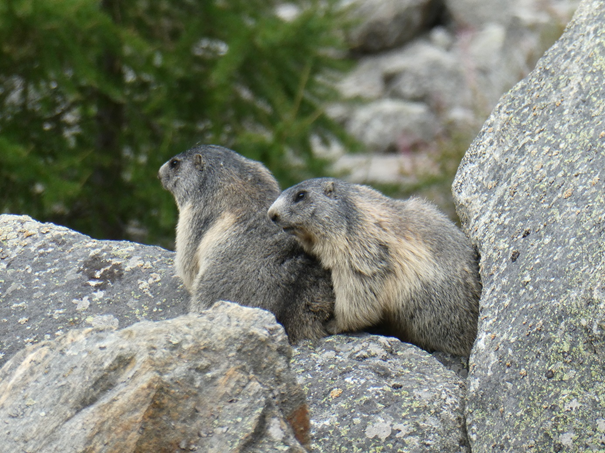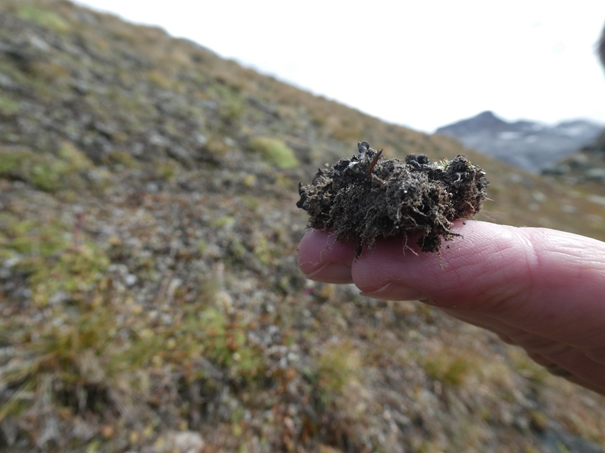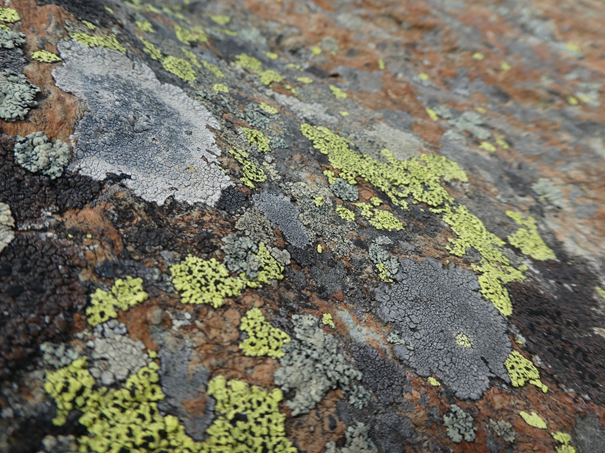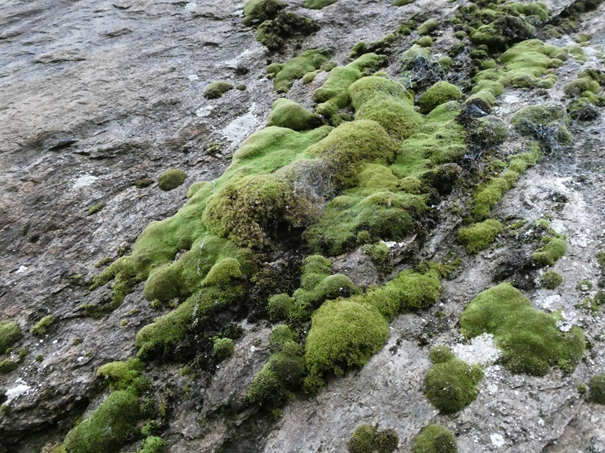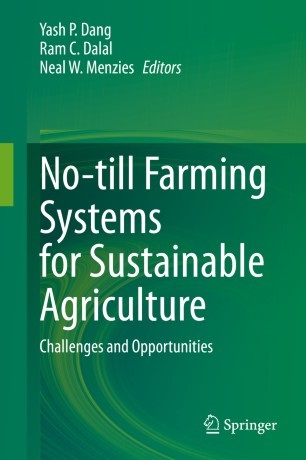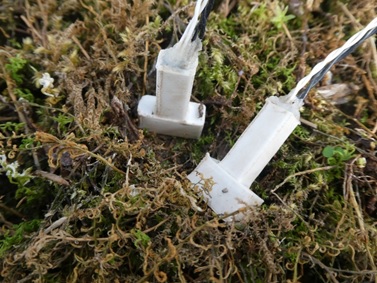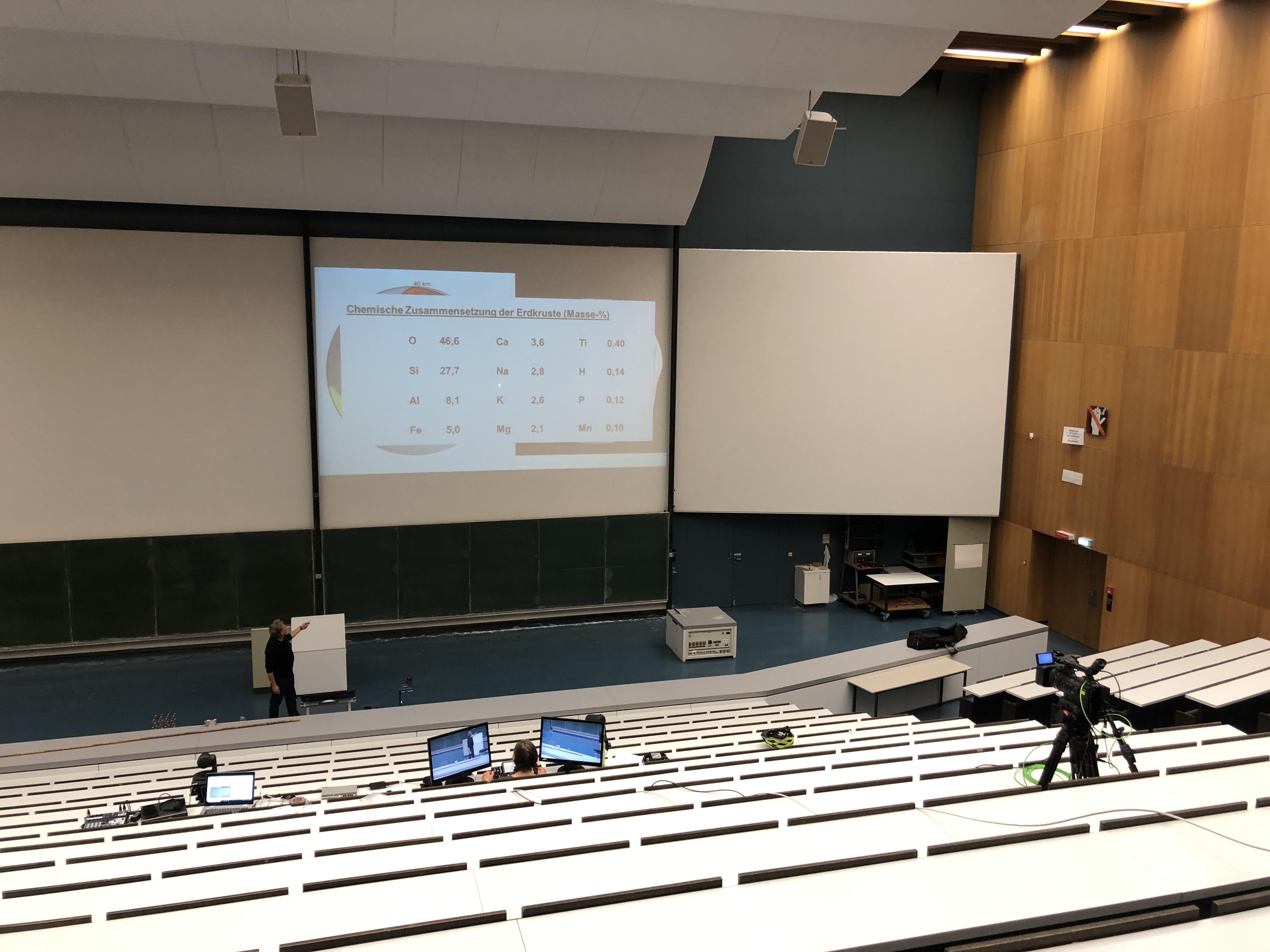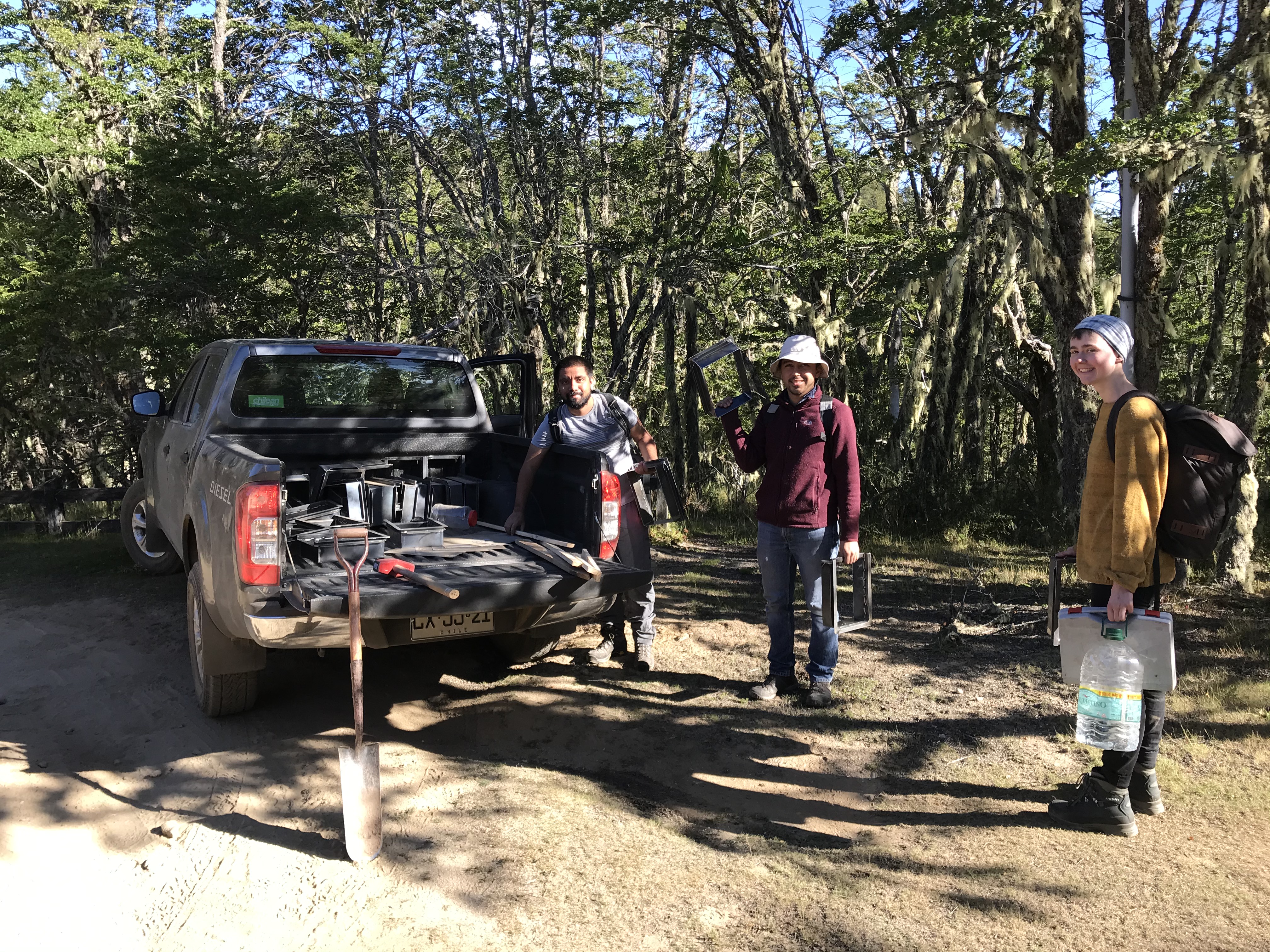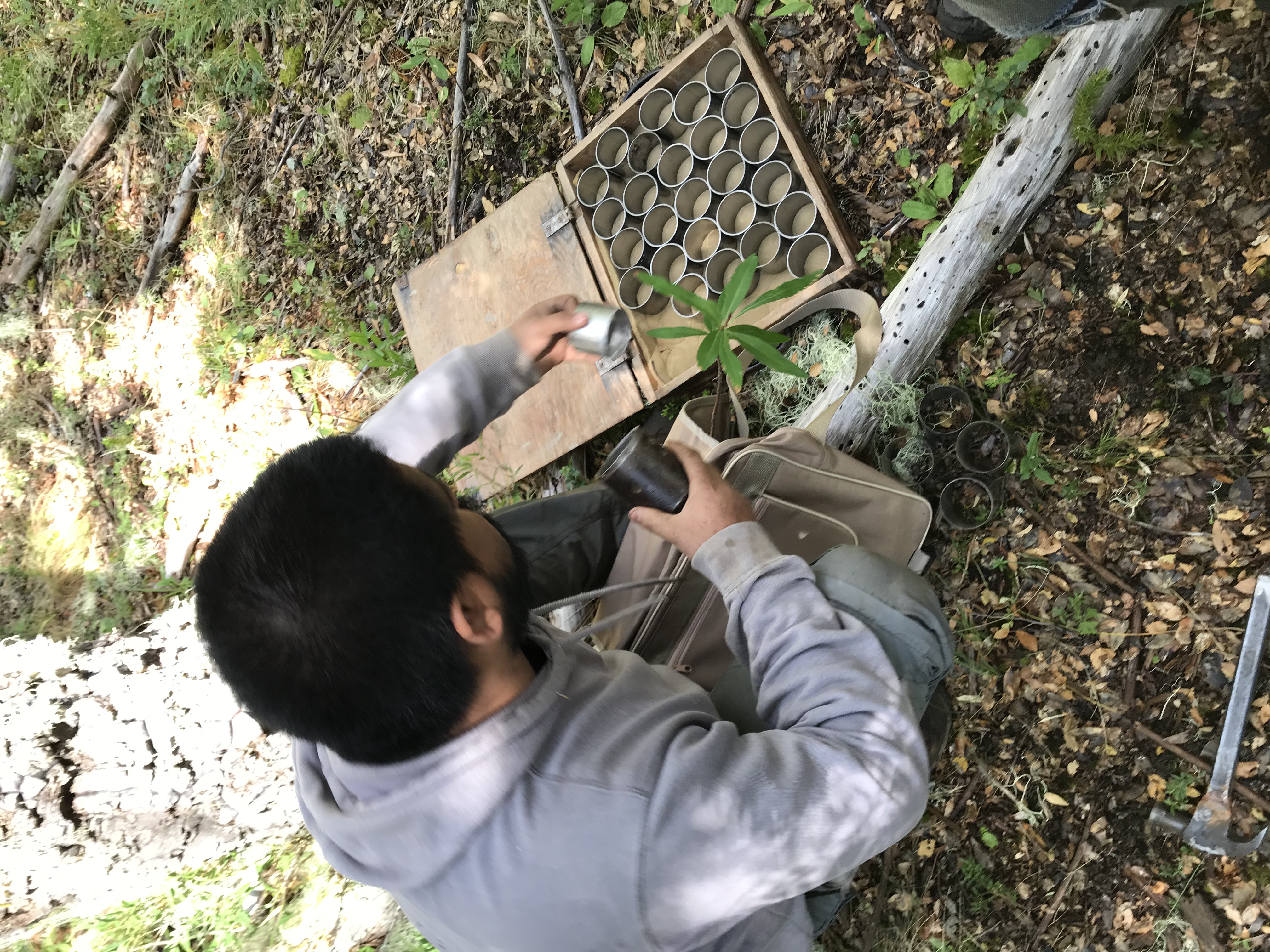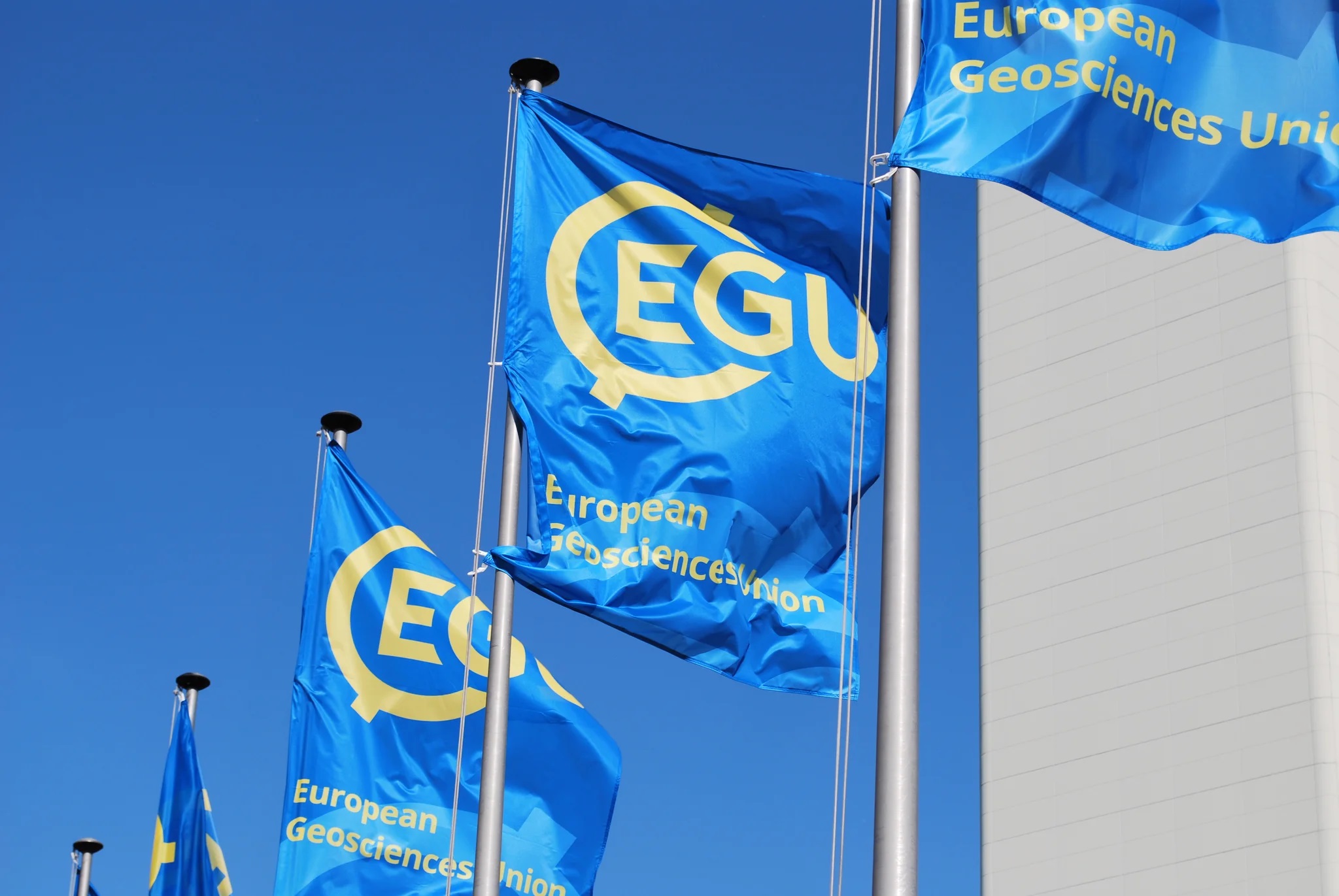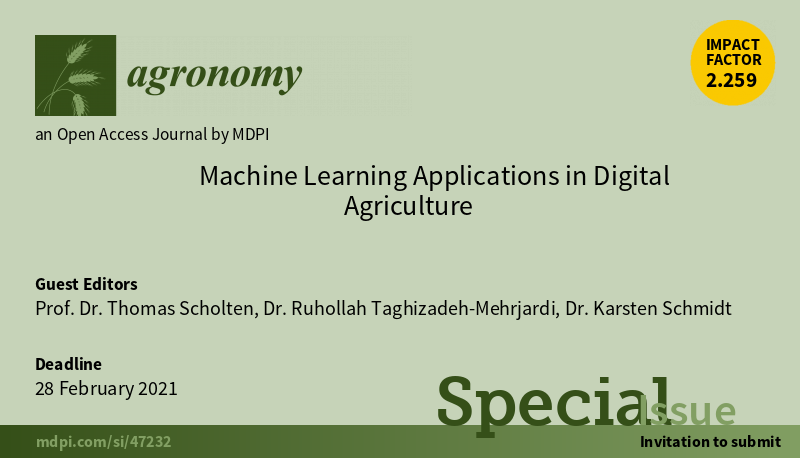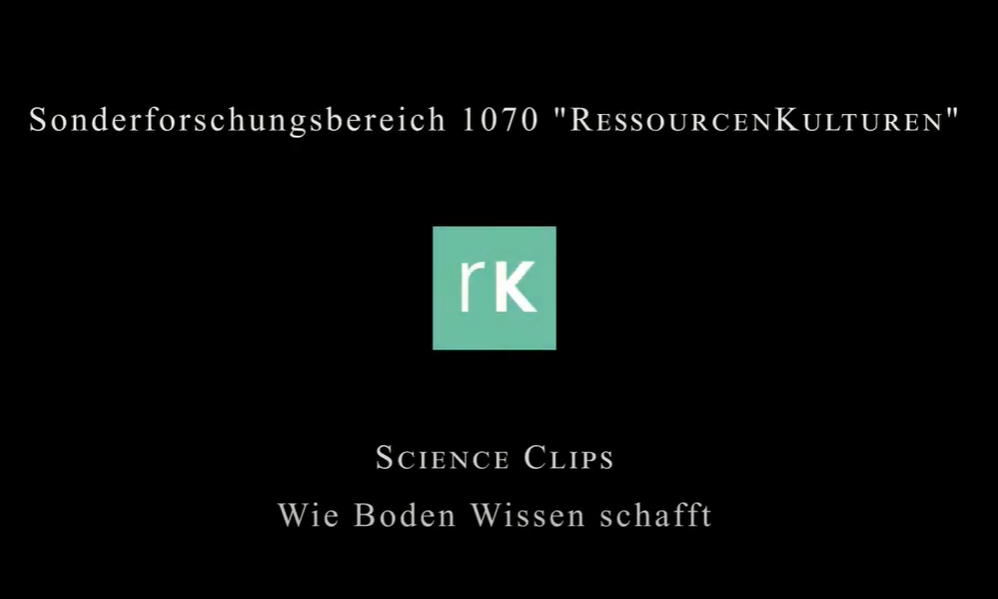News archive
10.06.2024
Vb-Wetterlage: Bachelor-Studierende trotzen dem Dauerregen
Exkursion des Moduls GEO21 unter erschwerten Umständen
Die Niederschläge am Wochenende des 31.05. – 02.06.2024 führten in weiten Teilen Süddeutschlands zu teils erheblichen Hochwasserschäden. Vom Dauerregen blieb auch die alljährliche GEO21 Exkursion nicht verschont.
Am Freitag kämpften sich die Studierenden knapp sieben Stunden mit dem Fahrrad durch das Ammertal; für den einzigen trockenen Moment sorgte dabei die Mittagspause unter dem Vordach eines Einkaufsladens. Im Fokus lag eine praktische Einführung in die Bodenkunde, von den Ausgangsgesteinen über die Pedogenese und Bodenaufnahme nach der KA5, bis hin zur anthropogenen Nutzung unserer Böden. Die vorausgegangenen Niederschläge rückten sehr anschaulich den Themenkomplex der Bodenerosion auf brachliegenden Ackerschlägen in den Mittelpunkt.
Am Samstag, diesmal mit dem Bus, beschäftigten wir uns mit der Landschaftsgeschichte und Geomorphologie, insbesondere dem Karst auf der Schwäbischen Alb. Während im Keuperbergland und den Oberen Gäuen westlich von Tübingen über das Wochenende „nur“ 40,5 mm innerhalb von 48 Stunden gemessen wurden (Station Bondorf), sorgte die Vb-Wetterlage auf der Schwäbischen Alb für eine Niederschlagssumme von 150,3 mm innerhalb von 72 Stunden (Wetterstationen). Der in St. Johann aufgenommene extrem ergiebige Dauerregen ist nach KOSTRA-DWD als mindestens 50-jähriges Niederschlagsereignis einzuordnen und entspricht etwa einem Sechstel der durchschnittlichen jährlichen Niederschlagssumme.
Wenn auch das Wetter den Studierenden die schöne Sicht auf den Albtrauf und die Kuppenalb nahm, offenbarte sich an der Falkensteiner Höhle, östlich von Reutlingen ein spektakuläres Bild. Dort, wo sonst gerne ein Stopp für die Mittagspause eingelegt wird, zeigte sich eindrucksvoll, wie schnell das System im seichten Karst auf starke Niederschläge anspringt. Nicht nur die Falkensteiner Höhle, sondern auch etliche Karstaustritte in der unmittelbaren Umgebung schütteten stark und sorgten spätestens ab dieser Station für vollkommen durchnässte Wanderschuhe bei den Studierenden.
Die Niederschläge führten bereits am vorausgehenden Freitag für großflächig übersättigte Böden auf der Alb, was sich im Laufe des Wochenendes in zahlreichen kleineren Rutschungen und der Ausbildung einiger stehender Gewässer, sowie von Gerinnen in den Trockentälern der Karstlandschaft wiederspiegelte.
Zusammengefasst bot sich den Studierenden eine zwar sehr nasse, aber auch sehr anschauliche GEO21-Exkursion, wie sie selten der Fall ist. Den angehenden GeographInnen, GeoökologInnen und ArchäologInnen als auch dem Exkursionsleiter Herrn Felix Weinschenk ist das größte Kompliment zu machen, da sie trotz aller Widrigkeiten zwei Tage mit Engagement voll durchzogen und somit die Exkursion zu einem großen Erfolg machten.
15.05.2024
Lehre und Forschung in der Echazaue
Das Mastermodul Boden und Landschaft führt Studierende in die Echazaue bei Betzingen und Wannweil
Vom 8.-12. April 2024 fand unter der Leitung von Peter Kühn die Geländeübung mit 16 Studierenden des Mastermoduls GEO 86 „Boden und Landschaft“ in der Echazaue bei Betzingen und Wannweil statt. Es wurden vier Bodenprofile ausgehoben, nach KA5 beschrieben und beprobt. Gleichzeitig führte ein fünfte Studierendengruppe mit zwei Doktorandinnen (SPP 2361 On the Way to the Fluvial Anthroposphere) Snježana Pejdanović (Tübingen) und Ema Zvara (Leipzig) Rammkernsondierungen durch. Die meisten der Studierenden beschäftigten sich zum ersten Mal intensiv mit Auenböden, die jedoch keine Langeweile aufkommen ließen. Die ausgezeichnete Lern- und Arbeitsatmosphäre wurde durch das gute Wetter unterstützt, sodass am letzten Geländetag die Echaz für eine angenehme Abkühlung genutzt wurde.
Im Forschungsprojekt des Schwerpunktprogrammes SPP 2361 steht die Frage nach dem Einfluss des Menschen im Mittelalter auf die Aue der Echaz und der Eger bei Nördlingen im Mittelpunkt. Im Modul GEO 86 wird nach Möglichkeit Lehre mit aktuell laufenden Forschungsprojekten verknüpft, sodass sowohl die Gelände- als auch die Laborergebnisse in die laufenden Forschungen mit einfließen werden.
Die im April entnommenen Bodenproben wurden inzwischen von den Studierenden getrocknet, gesiebt und gemahlen und werden in der Pfingstwoche im Rahmen der Laborübung in GEO 86 im Labor für Bodenkunde und Geoökologie analysiert werden.
28.02.2024
Kinder erforschen den Boden
Die Hector Kinderakademie Biberach erhebt Daten für das Citizen-Science-Projekt Teabag-Index
Die Hector Kinderakademie im Landkreis Biberach ermöglicht begabten Grundschülern eine besondere Form der Förderung. In einem aktuellen Kurs an der Hochschule Biberach beschäftigen sich die Schüler mit der Zersetzung von organischem Material im Boden, insbesondere mit einem Experiment, bei dem Teebeutel verwendet werden. Das Besondere an diesem Kurs ist, dass die Kinder nicht nur für sich selbst forschen, sondern ihre Daten auch an die Wissenschaftler der Universität Tübingen weitergeben.
Die Kinder, die für diese Akademie nominiert wurden, nehmen an speziell entwickelten Kursen teil, die sich auf die MINT-Fächer (Mathematik, Informatik, Naturwissenschaften und Technik) konzentrieren. Die Hector Kinderakademien, finanziert von der Hector Stiftung II und unterstützt vom Kultusministerium, veranstalten seit 2010 solche Kurse für begabte Grundschulkinder. Das Ziel ist es, ein Verständnis für wissenschaftliche Arbeits- und Erkenntnisprozesse zu vermitteln und die Kinder für naturwissenschaftliche Forschung zu begeistern.
In diesem konkreten Kurs steht der Teebeutelindex im Mittelpunkt, eine wissenschaftlich anerkannte Methode, um die Abbaurate von organischem Material im Boden zu bestimmen. Die Kinder beteiligen sich dabei an einem Citizen-Science-Projekt, bei dem sie Daten zur Zersetzungsrate in Böden sammeln, die dann an die Wissenschaftler der Universität Tübingen weitergegeben werden. Die Hoffnung ist, dass solche Projekte den begabten Kindern die Möglichkeit bieten, ihren Wissensdurst zu stillen und gleichzeitig zur wissenschaftlichen Forschung beizutragen.
04.02.2024
Milestones Achieved
Two More Papers from the Working Group on Geomorphology and Soil Science Attain "Highly Cited Paper" Status
We are proud to announce that two recent publications from the Tübingen Working Group on Geomorphology and Soil Science have achieved the prestigious status of "Highly Cited Paper." This recognition reflects the impactful and influential nature of the research conducted by our dedicated team.
The first paper, titled "Improving the spatial prediction of soil salinity in arid regions using wavelet transformation and support vector regression models", delves into the field of predicting soil salinity utilising machine learning algorithms with the aim to improve agricultural productivity in arid regions. Its recognition as a "Highly Cited Paper" underscores the significance of the findings and the relevance of the research to the broader scientific community.
In the second paper, titled "Global maps of soil temperature", global maps of soil temperature and bioclimatic variables at a 1-km2 resolution for 0–5 and 5–15 cm soil depth were created. This achievement reaffirms the Tübingen Working Group's commitment to producing high-quality research that contributes to the advancement of our field.
We extend our sincere gratitude to all collaborators, supporters, and contributors who have played a crucial role in these accomplishments. This recognition motivates us to continue our pursuit of excellence and innovation in the realm of geomorphology and soil science.
| Taghizadeh, R., Schmidt, K., Toomanian, N., Heung, B., Behrens, T., Mosavi, A., Band, S., Amirian, A., Fathabadi, A., Scholten, T. (2021): Improving the spatial prediction of soil salinity in arid regions using wavelet transformation and support vector regression models. Geoderma. doi: 10.1016/j.geoderma.2020.114793 |
| Lembrechts, J. J., van den Hoogen, J., Aalto, J., Ashcroft, M. B., Frenne, P. de, Scholten, T. et al. (2022): Global maps of soil temperature. In: Global change biology 28 (9), 3110–3144. doi: 10.1111/gcb.16060. |
21.01.2024
"Multicultural New Year 2024 Diner"
A special event at the Chair of Soil Science and Geomorphology
In accordance with the three sums of words of the university of Tübingen; Innovative, Interdisciplinary, and International, the Chair of Soil Science and Geomorphology hosted a delightful “Multicultural New Year Dinner – 2024” on Thursday 11th Jan 2024 for a swift start of the year. The event, spearheaded by Chair Prof. Thomas Scholten, aimed to kickstart the year in a spirit of unity and diversity. Prof. Thomas Scholten unfolded the event sharing brief insights into the internationalization journey of the research group. He highlighted the rich history of international collaboration, acknowledged the current national-international members of the research team, and shed light on ongoing international research projects.
The party was kicked-off at 4 o’clock with a diverse array of drinks and multinational appetizers exemplifying the cultural richness of the team, such as bung cheese with pretzels (Rheinhessen), salad made of strips of sausage, onions, and gherkins (Schwaben), bulgur salad with cucumber and tomato (Iran and Lebanon) and potato-yogurt salad (Chukaini, Nepal). Before serving each meal items, researchers who prepared were provided time to explain the recipe and how it is linked to their respective culture. As a main course, participants fully enjoyed the variety of foods including but not limited to fresh prepared burek from Croatia, barberry rice with chicken (Iran), potato pancakes with leek, onion, and bacon (Saarland), Persian rice, hot and spicy okra vegetable (Nepal) and many more. Similarly, puddling cream and chocolate (Westfalen), chocolate and cherry cake (Donau), gingerbread of Saarland and marvelous Black Forest cake with cherry (Germany) stealing the spotlight as desserts.
Admits the delightful dinner, the program was coupled with research work/excursion updates organized in 2023. Experiences of research field expedition such as TREELINE-II research presented by our PhD student Rabindra from Nepal while the latest China research visit by Prof. Thomas Scholten and team was presented by Dr. Steffen Seitz and a brief video documentary presented by Dr. Peter Kühn from the research project DFG SPP “Fluvial Anthroposphere”.
To conclude the evening on a lively note, table football matches were played among different groups/teams fostering unity and team sprite. The event concluded with a vote of thanks from Chair Prof. Thomas Scholten, marking the success of the first-ever organized multicultural dinner evening in the research team.
Photos and text: Rabindra Adhikari (2024)
Zurück13.11.2023
Chair of Soil Science publishes new book chapter:
A brief review of digital soil mapping in Iran
The anthology Remote Sensing of Soil and Land Surface Processes: Monitoring, Mapping, and Modeling couples artificial intelligence and remote sensing for mapping and modeling natural resources, thus expanding the applicability of AI and machine learning for soils and landscape studies and providing a hybridized approach that also increases the accuracy of image analysis. The book covers topics including digital soil mapping, satellite land surface imagery, assessment of land degradation, and deep learning networks and their applicability to land surface processes and natural hazards, including case studies and real life examples where appropriate.
The chapter provides a brief overview of digital soil mapping (DSM) in Iran, which uses machine learning and environmental data to create soil maps for better soil management. The report reviews the background of DSM in Iran, recent developments in machine learning methods and the environmental covariates commonly used in DSM. Despite its short history in Iran, DSM has attracted significant interest in recent years, with several studies conducted in different regions of the country. The report highlights the importance of advanced machine learning methods, such as random forests and artificial neural networks, for accurate prediction and classification of soil properties. It also discusses the importance of environmental covariates such as topography, geology, climate and land use for DSM in Iran. The article concludes that DSM has the potential to play a critical role in soil management and conservation in Iran and that further research is needed to realise this potential.
Taghizadeh, R., Zeraatpisheh, M., Amirian Chakan, A., Scholten, T. (2024): A Brief Review of Digital Soil Mapping in Iran. In: Melesse, A.M., Rahamati, O. und Khsoravi, R. (Hrsg.): Remote Sensing of Soil and Land Surface Processes. Elsevier Earth Observation Series. Amsterdam, S. 217–228, ISBN: 978-0-443-15341-9.
14.10.2023
Joint Japanese-German Workshop held in Tübingen
A bilateral workshop on "Understanding and large-scale mapping of soil erosion and soil carbon accumulation in forest ecosystems using machine learning" funded by the Japanese Society for the Promotion of Science (JSPS) and the German Research Foundation (DFG) was successfully hosted at the Institute of Geography in Tübingen. The purpose of this joint exchange format is to promote scientific cooperation between partner institutions in both countries.
20 scientists from Japan and Germany met over four days and discussed current issues in applied soil erosion research, ecohydrology and pedometrics. Furthermore, Prof. Dr. Thomas Scholten introduced the aims and possibilities of the Cluster of Excellence in Machine Learning in a keynote talk and affiliated scientists presented their soil-related research work with state-of-the-art techniques using artificial intelligence.
The scientific programme was accompanied by excursions to the biodiversity exploratories Swabian Alb, the Schönbuch Nature Park and the botanical garden of the University of Tübingen, as well as a visit to Hohentübingen Castle with its museum (MUT). The two initiators, Dr. Kazuki Nanko (Forestry and Forest Products Research Institute, Tsukuba) and Dr. Steffen Seitz (Department of Geosciences, Tübingen) drew a very positive conclusion of the joint exchange after the final discussion round and are looking forward to future cooperation formats.
Zurück06.10.2023
The Best Poster Award at IEEE-GRSS IADF School
The Best Poster Award was won by Dr. Nafiseh Kakhani at the 2nd IEEE-GRSS IADF School in Benevento, Italy, which took place from September 13–15. This school focused on computer vision for earth observation and drew attendees from all over the world.
Her winning poster, "SoilNet: A Spatio-temporal Deep Learning Framework for Digital Soil Mapping," showcased her work on SoilNet. This project represents an ongoing endeavor aimed at utilizing the power of deep learning to extract maximum insights from multimodal data. The ultimate goal is to construct a meticulously designed model for digital soil mapping, a task of great significance in the field of earth sciences.
Zurück02.10.2023
Exchange workshop on rainfall simulation funded by DAAD
In the last week, the first part of a DAAD-funded exchange workshop between the Soil Science and Geomorphology Group (project lead Dr. Steffen Seitz) and colleagues from the Department of Landscape Water Conservation at Czech Technical University Prague (project lead Dr. Josef Krása) took place in Tübingen. We successfully tested and compared two portable rainfall simulators with different setups from both research institutions. In this context we used laser distrometer and sand-filled splash cups (T-cups) for calibration. Furthermore, we tested a MiniJet device.
Thank you very much for this great exchange and the invitation for a return visit to Prague.
Zurück26.09.2023
DBG-Tagung 2025 in Tübingen
Tübingen als Gastgeber der Jahrestatung 2025 der Deutschen Bodenkundlichen Gesellschaft ausgewählt
Vom 13. bis 18 September 2025 findet die Jahrestagung der Deutschen Bodenkundlichen Gesellschaften (DBG) in Tübingen statt, nun steht es offiziell fest. Auf der diesjährigen Tagung an der Universität Halle (Saale) übergab Prof. Dr. Bruno Glaser den goldenen Bohrstock an Prof. Dr. Thomas Scholten (im Hintergrund die frisch gewählte neue Präsidentin der DBG, Prof. Dr. Daniela Sauer von der Universität Göttingen). Es werden etwas 800-1000 Teilnehmerinnen und Teilnehmer aus Deutschland, der Schweiz und Österreich sowie anderer Länder erwartet.
12.09.2023
Tagung der Deutschen Bodenkundlichen Gesellschaft 2023
Die diesjährige Tagung der Deutschen Bodenkundlichen Gesellschaft (DGB) fand vom 2. Bis 8. September in Halle an der Saale statt und stand unter dem Motto „Böden – divers und multifunktional“. Die Arbeitsgemeinschaft Bodenkunde und Geomorphologie der Universität Tübingen wurde von Prof. Dr. Thomas Scholten, Dr. Steffen Seitz, Dr. Tobias Rentschler, Dr. Peter Kühn, Corinna Gall und Kerstin Rau vertreten. Auch Dr. Sascha Scherer war als ehemaliges Mitglied der Arbeitsgruppe vor Ort.
Den diesjährigen Posterpreis für junge WissenschaftlerInnen gewann Corinna Gall.
Zurück22.08.2023
Studentische Hilfskraft (w/m/d) im Umfang von 30 Stunden/Monat gesucht
Hector-Institut für Empirische Bildungsforschung
Bewerbungsfrist: 15.09.2023
Das Hector-Institut für Empirische Bildungsforschung (Leitung Prof. Dr. Trautwein) sucht zur Unterstützung der wissenschaftlichen Begleitung der Hector Kinderakademien
eine studentische Hilfskraft (w/m/d)
im Umfang von 30 Stunden/Monat.
Die Stelle ist ab Oktober 2023 zu besetzen und zunächst für die Dauer von sechs Monaten befristet. Das Hector-Institut für Empirische Bildungsforschung beschäftigt sich in Forschung und Lehre mit individuellen, sozialen und institutionellen Determinanten von Lehr- und Lernprozessen. Zusammen mit dem Leibniz-Institut für Bildungsforschung und Bildungsinformation (DIPF) in Frankfurt ist es zuständig für die wissenschaftliche Begleitung der Hector Kinderakademien. Bei den Hector Kinderakademien handelt es sich um ein landesweites Enrichmentprogramm für besonders begabte, interessierte und motivierte Grundschulkinder. Im Rahmen unseres Hector Core Courses „An die Schaufeln, fertig, los! Mit Wissenschaftler*innen den Boden erforschen“, der für die Hector Kinderakademien entwickelt wurde, nehmen Kinder an einem bodenwissenschaftlichen Citizen-Science-Projekt zur Erfassung des Tea-Bag-Index teil. Ziel des Projekts ist, Grundschulkinder an aktueller Forschung zu beteiligen. Bei dem Projekt handelt es sich um eine interdisziplinäre Zusammenarbeit zwischen dem Hector-Institut und der Professor für Bodenkunde und Geomorphologie der Universität Tübingen. Zur Unterstützung unseres Citizen-Science-Projekts wird eine studentische Hilfskraft gesucht. Bewerben können sich Studierende der Geographie, Geowissenschaften, Geoökologie oder ähnlicher Fachrichtungen sowie Studierende der Erziehungs- und Bildungswissenschaften, Psychologie, Soziologie und Lehramtsstudierende.
Weitere Informationen zu uns, dem Citizen-Science-Projekt sowie dem Hector Core Course „An die Schaufeln, fertig, los!“ und den Hector Kinderakademien finden Sie unter https://uni-tuebingen.de/de/216151, www.hectorkinderakademien.de und bit.ly/bodenkunde.
Typische Tätigkeiten:
- Koordination, Vorbereitung und Distribution der CitizenScience-Aktionskits
- Bearbeitung der zurückgesandten Citizen-ScienceAktionskits und Datenerfassung
- Laborarbeiten nach Einweisung (Einwaage, Sieben, etc.) im Labor des Geographischen Instituts
- Unterstützung bei der Gestaltung der Citizen-ScienceErgebniskommunikation an die Kinder
Ihr Profil:
- Interesse an der Mitarbeit in einem interdisziplinären Forschungsprojekt
- ausgeprägte organisatorische Fähigkeiten
- hohes Maß an Selbstständigkeit, strukturierte und sorgfältige Arbeitsweise
- Zuverlässigkeit und Engagement
Bei Interesse freuen wir uns über Ihre Bewerbung (Anschreiben, Lebenslauf, Abiturzeugnis, Zwischenprüfungszeugnis oder Transcript of records in einem PDF-Dokument). Richten Sie diese bitte bis spätestens 15.09.2023 per E-Mail an Frau Julia Maria Lange (julia-maria.langespam prevention@uni-tuebingen.de). Die Universität Tübingen fördert qualifizierte Studentinnen und bittet deshalb um ihre Bewerbung. Schwerbehinderte Bewerber/innen werden bei gleicher Eignung bevorzugt berücksichtigt. Die Einstellung erfolgt durch die Zentrale Verwaltung.
Downloads
Zurück29.07.2023
Human-Environment Interactions in Ancient Arabia
International Conference to be held from 6th to 8th November 2023
The UmWeltWandel-project organized conference Human-Environment Interactions in Ancient Arabia (HEIAA) will be held at Tübingens Alte Aula from 6th to 8th November 2023. The registration for listeners is open until 30 august 2023. More information and can be found at the conferences official homepage:
Preliminary Program
Day 1 – Monday 6th November 2023
09:00 – Welcome and introductory remarks
Conrad Schmidt, University of Tübingen
09:30 – Fluvial investigations in the context of paleoenvironmental change over the last 330,000 years and its influence on human occupation in SE Arabia
Kira Raith, Oxford Brookes University; Ash Parton, Oxford Brookes University / University of Oxford; Gareth Preston, Oxford Brookes University; Knut Bretzke, University of Tübingen; Adrian Parker, Oxford Brookes University
10:00 – New evidence of Late Pleistocene and Holocene sedimentary processes and eolian dynamics in the northern al-Hajar Range (UAE, Oasis of Masafi)
Louise Purdue, Université Côte d’Azur, CNRS-CEPAM (UMR 7264); Sophie Costa, Université Côte d’Azur, CNRS-CEPAM (UMR 7264); Maël Crépy, University Lumière Lyon 2; Julien Charbonnier, Archaïos
10:30–11:00 – Coffee Break
11:00 – Environmental dynamics in northwestern Arabia during the Holocene: fluvial, wetland and dune archives in the AlUla oasis
Laurent Lespez, Université Paris Est-Créteil (UMR 8591); Louise Purdue, Université Côte d’Azur, CNRS-CEPAM (UMR 7264); Hatem Djerbi, Université Côte d’Azur, CNRS-CEPAM (UMR 7264); Amaury Fernandes, Université Paris Est-Créteil (UMR 8591); Eric Andrieux, Durham University; Jean-François Girard, Université de Strasbourg, Ecole et observatoire des sciences de la terre (EOST); Gourguen Davtian, Université Côte d’Azur, CNRS-CEPAM (UMR 7264); Ségolène Saulnier-Copard Laboratoire de Géographie Physique CNRS UMR 8591; Sophie Costa, Université Côte d’Azur, CNRS-CEPAM (UMR 7264); Alain Carré, Université Côte d’Azur, CNRS-CEPAM (UMR 7264); Claude Rouvier, Independent Researcher, Valentina Villa Université Côte d’Azur, CNRS-CEPAM (UMR 7264)
11:30 – Early- to mid-Holocene lake formation in NW Arabia was driven by the West African Monsoon
Max Engel, Heidelberg University; Samantha Klügl, Heidelberg University; Ina Neugebauer, Helmholtz Centre Potsdam; Michèle Dinies, German Archaeological Institute (DAI), Berlin / Freie Universität Berlin; Anne Dallmeyer, Max Planck Institute for Meteorology (Hamburg); Martin Claussen, Max Planck Institute for Meteorology (Hamburg) / Universität Hamburg; Helmut Brückner, University of Cologne; Peter Frenzel, Friedrich Schiller University Jena; Gerd Gleixner, Max Planck Institute for Biogeochemistry (Jena); Philipp Hoelzmann, Freie Universität Berlin; Anna Pint, Friedrich Schiller University Jena; Rik Tjallingii, Helmholtz Centre Potsdam; Kai Wellbrock, Technische Hochschule Lübeck; Birgit Plessen, Helmholtz Centre Potsdam
12:00 – The Nexus of Cult and Pastoralism in Neolithic Northwest Arabia: Contextualising the Mustatil Phenomenon
Melissa Kennedy, The University of Sydney / The University of Western Australia; Hugh Thomas, The University of Sydney / The University of Western Australia; Laura Strolin, Museum of Natural History of Geneva
12:30–14:00 – Lunch
14:00 – Grass, Water and Sand: Exploring the Environmental Parameters and Practicalities of Cattle Herding in the Neolithic of Northern Arabia
Maria Guagnin, Max Planck Institute of Geoanthropology
14:30 – Hayl (pl. huyul), a specific landscape form in the Al-Hajar Mts (SE Arabia)
Inna Mateiciucová, Centre of Prehistoric Archaeology of the Near East (PANE); Maximilian Wilding, Centre of Prehistoric Archaeology of the Near East (PANE); Slavomír Nehyba, Masaryk University; Jiří Otava, Czech Geological Survey; Jiří Šindelář, Geo-cz, s.r.o., Mladá Vožice
15:00 – Southeastern Arabia population patterns and intensity of cultural exchanges across the Holocene Humid Period
Maria Pia Maiorano, Goethe University Frankfurt; Eugenio Bortolini, University of Bologna
15:30–16:00 – Break
16:00 – Caprines in prehistoric south-eastern Arabia: Variations in animal exploitation through zooarchaeological data
Elena Maini, Sapienza Università di Rome; Laura Strolin, Museum of Natural History of Geneva
16:30 – An overview of the interactions between human societies and natural hazards in Arabia since the Late Pleistocene
Eric Fouache, Sorbonne University
Starting at 17:30: Icebreaker
Day 2 – Tuesday 7th November 2023
09:00 – First results from the UmWeltWandel project in Al Khashbah (Oman)
Conrad Schmidt, University of Tübingen; Tara Beuzen-Waller, University of Tübingen; Lucas Proctor, Goethe University Frankfurt; Katharina Elena Schmitt, University of Mainz; Julia Unkelbach, University of Göttingen
09:30 – Emergence and evolution of date palm cultivation in Northwestern Arabia
Margot Besseiche, IDR/ University of Montpellier; Vincent Battesti, Muséum national d’histoire naturelle; Muriel Gros-Balthazard, IDR/ University of Montpellier
10:00 – Meat, milk and ‘invisible’ organic products in pottery: results of ceramic lipid residue analysis of vessels from Bronze Age sites in SE Arabia
Akshyeta Suryanarayan, Universitat Pompeu Fabra / Université Côte d’Azur; Sophie Méry, CNRS, UMR 7041; Charlotte Marie Cable, Michigan State University; Eli Dollarhide, New York University Abu Dhabi; Stephanie Döpper, Goethe-Universität Frankfurt / Julius-Maximilians-Universität Würzburg; Daniel Eddisford, Durham University; Michele Degli Esposti, Polish Academy of Science, Warsaw; Arnaud Mazuy, Université Côte d’Azur; Jennifer Swerida, Bryn Mawr College / Penn Museum University of Pennsylvania; Michel de Vreeze, Durham University; Martine Regert, Université Côte d’Azur
10:30–11:00 – Coffee Break
11:00 – Towers and settlement in the Bisya region (ad-Dakhiliyah, Oman) during the Early Bronze Age: adaptation strategy of human occupation in a semi-arid environment
Martin Sauvage, CNRS, VEPMO UMR 7041; Mathilde Jean, CNRS, VEPMO UMR 7041
11:30 – Facing Early Bronze Age climate change in South East Arabia: new data from Salūt-ST1, Central Oman
Mauro Cremaschi, Università degli Studi di Milan; Michele Degli Esposti, Polish Academy of Science, Warsaw; Andrea Zerboni, Università degli Studi di Milan
12:00 – Cultural and environmental resiliency at Bat, Oman: Early Bronze Age and today
Jennifer Swerida, University of Pennsylvania; Eli Dollarhide, New York University Abu Dhabi
12:30–14:00 – Lunch
14:00 – Impossible farming! Spotting and documenting agricultural practices outside oases in Arabia
Maël Crépy, Institut Français d’Archéologie Orientale
14:30 – Persistent pastoralism in a dynamic Dhofar landscape: Results from the ASOM Project
Mark Moritz, The Ohio State University; Ian Hamilton, The Ohio State University; Katie Horisk, Penn State University; Madelyn Green, The Ohio State University; Sarah Ivory, Penn State University; Lawrence Ball, Kent Wildlife Trust; Daniel Peart, University Library Newark; Ali Ahmed Al Kathiri, Ministry of Heritage and Tourism of the Sultanate of Oman; Ali Al Mehri, Ministry of Heritage and Tourism of the Sultanate of Oman; Andrea Zerboni, Università degli Studi di Milan; Guido Mariani, Università di Torino; Joy McCorriston, The Ohio State University
15:00 – Millennial-scale transformations of landscapes and land use in the canyon of Southeast Arabia. Insights from the archaeological investigations in Tanuf, North-Central Oman
Taichi Kuronuma, Research Institute for Humanity and Nature; Takehiro Miki, The University of Tokyo; Kantaro Tanabe, The University of Tokyo; Yasuhisa Kondo, Research Institute for Humanity and Nature
15:30–16:00 – Break
16:00 – The plain between the mountains, report of the second season of MASPAG’s survey in the Sultanate of Oman
Guido Antinori, Sapienza Università di Roma; Edoardo Zanetti, Sapienza Università di Roma; Silvia Lischi, Università di Pisa; Marco Ramazzotti, Sapienza Università di Roma
16:30 – Late prehistoric environments and human adaptations at Saruq al-Hadid, Dubai: the archaeobotanical evidence
Claire Newton, Independent Scholar; Lloyd Weeks, University of New England; Adrian Parker, Oxford Brookes University; James Roberts, Independent Scholar; Charlotte Cable, Michigan State University
Day 3 – Wednesday 8th November 2023
09:30 – The second millennium in Southeast Arabia
Derek Kennet, Durham University
10:00 – Between mountains and the sea. Archaeological survey and landscape studies at Al-Tikha/Rustaq, Oman
Rocco Palermo, Bryn Mawr College; Sara Pizzimenti, University of Pisa; Khaled Douglas, Sultan Qaboos University
10:30–11:00 – Coffee Break
11:00 – Reconstructing the history of al-‘Ulā oasis (kingdom of Saudi Arabia): first insights from the al-‘Ulā Cultural Oasis Project (2019-2023)
Julien Charbonnier, Archaïos; Yasmin Kanhoush, Archaïos / UMR 5133 Archéorient; Mathias Haze, Archaïos; Sarra Ben Bader, Archaïos; Sofian Boudia, University Paris 1 Panthéon-Sorbonne; Manuela Cascetta, Archaïos; Pascale Clauss-Balty, Archaïos; Arthur Defauconpret, Archaïos; Cassandra Furstos, Archaïos; Gaël Gourret, Archaïos; Julie Gravier, UMR 8557 EHESS; Valentin Koszarek, University Paris 1 Panthéon-Sorbonne; Maureen Le Doaré, Archaïos; Anne Leschallier de Lisle, Archaïos; Céline Marquaire, Archaïos; Maria Paola Pellegrino, Archaïos; Ali Othman, Archaïos; Jean-Daniel Ricart, Archaïos; Alexia Rosak, Archaïos / University Paris 1 Panthéon-Sorbonne; Salomé Sepeau, University Paris 1 Panthéon-Sorbonne; David Serres, University Paris 1 Panthéon-Sorbonne; Francelin Tourtet, Archaïos / Freie Universität Berlin; Jessica Giraud, Archaïos
11:30 – How Bone Connects Life’s Past to the Present. Zooarchaeology at Dadan (AlUla, Saudi Arabia)
Hervé Monchot, CNRS UMR 8167
12:00 – Landscape evolution and environmental dynamics of Nafūn (al-Wusṭā Governorate, central Oman)
Roman Garba, Institute of Archaeology of the CAS / Nuclear Physics Institute of the CAS, Prague; Alžběta Danielisová, Institute of Archaeology of the CAS, Prague; David Daněček, Institute of Archaeology of the CAS, Prague; Maria Pia Maiorano, Goethe-Universität Frankfurt; Dominik Chlachula, Masaryk University in Brno; Angelo Eugenio Fossati, Catholic University of the Sacred Heart, Milan
12:30–14:00 – Lunch
14:00 – Industrial periodicity of copper smelting: new research in Wadi al-Raki (Oman)
Joseph W. Lehner, The University of Sydney; Amir Zaribaf, The University of Sydney; Abigail Buffington, College of William and Mary; Ioana A. Dumitru, The University of Sydney, Centre for Urban Network Evolutions (UrbNet), Aarhus University; Smiti Nathan, Anthico LLC; Paige Paulsen, Johns Hopkins University; Alexander J. Sivitskis, Teton Science Schools; Eli Dollarhide, New York University Abu Dhabi; Michael J. Harrower, Johns Hopkins University
14:30 – The late development of Central Arabian oases. Al-Kharj as a case study
Elora Chambraud, AASPE – UMR 7209; Hervé Monchot, CNRS UMR 8167; Jérémie Schiettecatte, CNRS UMR 8167; Charlène Bouchaud, AASPE – UMR 7209, Vladimir Dabrowski, AASPE – UMR 7209
15:00 – Malacological assemblages in oases environment, a way to recount human activities through time
Hatem Djerbi, Université Côte d’Azur, CNRS-CEPAM (UMR 7264); Louise Purdue, Université Côte d’Azur, CNRS-CEPAM (UMR 7264); Pauline Garberi, Université Côte d’Azur, CNRS-CEPAM (UMR 7264); Alain Carré, Université Côte d’Azur, CNRS-CEPAM (UMR 7264); Laurent Lespez, Université Paris Est-Créteil (UMR 8591); Valentina Villa, (Université Côte d’Azur, CNRS-CEPAM (UMR 7264); Claude Rouvier, Independent Researcher; Sophie Costa, Université Côte d’Azur, CNRS-CEPAM (UMR 7264); Eric Andrieux, Durham University; Gourguen Davtian, Université Côte d’Azur, CNRS-CEPAM (UMR 7264); Julien Charbonnier, Archaeïos
15:30 – Past vegetation and impact of human activities in Southeast Arabia during the medieval period: First regional charcoal synthesis
Vladimir Dabrowski, AASPE – UMR 7209 / UMR 7264; Margareta Tengberg, AASPE – UMR 7209
16:00 – Closing Remarks
18.07.2023
Alexander Humboldt Fellowship
Dr. Kamal Nabiollahi
Dr. Kamal Nabiollahi is an associate professor at the University of Kurdistan specializing in soil science. His research focuses on digital soil mapping, classification, and land suitability. In 2022, he received a scholarship from the Alexander von Humboldt Foundation. The objective is to predict the spatial distribution of land suitability classes.
Zurück22.05.2023
acatech am Dienstag, 23.05.2023:
„Zu viel Stickstoff im Boden! Wie können Landwirtschaft und Konsum zur Verringerung beitragen?“
Die Veranstaltung fand online via Zoom von 19:30 Uhr bis 21:00 Uhr statt. Eine Zusammenfassung des Treffens steht auf dieser Seite zur Verfügung.
Alle Pflanzen brauchen Stickstoff zum Leben. Zwar ist reichlich Stickstoff in der Luft, aber diese Form kann von den Pflanzen meist nicht verwertet werden. In der Regel erfolgt die Aufnahme über die Wurzeln, durch Symbiose mit Pilzen oder Bakterien.
Eine intensivierte Landwirtschaft führt den Pflanzen große Mengen an Stickstoffverbindungen über Dünge- und Futtermittel zu. Dadurch gelangen deutschlandweit jährlich durchschnittlich pro Hektar landwirtschaftlicher Fläche 92 Kilogramm ungenutzter Stickstoff in die Umwelt – bei einer bestehenden gesetzlichen Obergrenze von 80 kg/ha – und reichern sich in Böden und Gewässern an.
Zielgerichtete, effiziente und bedarfsgerechte Ausbringungstechnologien, können zu einer deutlichen Verringerung der Stickstoffeinträge in Grundwasser, Oberflächengewässer, Böden und die Luft führen.
Bei diesem acatech am Dienstag setzen wir uns mit unterschiedlichen Strategien zur Reduktion des Stickstoffgehalts in den Böden auseinander: Wie sehen nachhaltige Bewirtschaftungsstrukturen aus? Wie müssen die Rahmenbedingungen geändert werden? Welchen Beitrag können nachhaltiger Konsum und informierte Kaufentscheidungen leisten?
Die Veranstaltung fand im Rahmen des Flower Power Festival München statt.
Begrüßung:
- Prof. Dr.-Ing. Jan Wörner, Präsident acatech
Podium:
- Prof. Dr. Thomas Scholten, Lehrstuhl für Bodenkunde und Geomorphologie, Eberhard-Karls-Universität Tübingen
- Dr. Anette Freibauer, Institut für Agrarökologie und Biologischen Landbau, Bayerische Landesanstalt für Landwirtschaft, Freising
- Dr. Eberhard Nacke, Director Corporate Product Strategy, CLAAS KGaA mbH
- Andreas Puchner, Referent für Umwelt- und Naturschutz, Bayerischer Bauernverband
Moderation:
- Dr. Martin Bimmer, acatech Geschäftsstelle
Bitte melden Sie sich bis spätestens Dienstag, den 23. Mai um 19:00 Uhr unter diesem Link an. Gerne können Sie den Veranstaltungshinweis weiterleiten. Die Anmeldung ist dann unter diesem Link möglich. |
Fachlicher Ansprechpartner: | Organisatorische Ansprechpartnerin: Hannah Lecheler T +49 (0)89 / 52 03 09-44 lechelerspam prevention@acatech.de |
Weitere Informationen finden Sie unter www.acatech.de.Eine Zusammenfassung des Treffens steht auf dieser Seite zur Verfügung.Geschäftsstelle Karolinenplatz 4 I 8033 München I T +49 (0)89 / 52 03 09-0 I F +49 (0)89 / 52 03 09-900 |
Geschäftsführendes Gremium des Präsidiums | Committee of Board and Vice Presidents: Prof. Dr. Ann-Kristin Achleitner, Prof. Dr. Ursula Gather, Dr. Stefan Oschmann, Manfred Rauhmeier, Prof. Dr. Christoph M. Schmidt, Prof. Dr.-Ing. Thomas Weber, Prof. Dr.-Ing. Johann-Dietrich Wörner Registergericht AG München | District Court Munich, VR 20 20 21 Vorstand i.S.v. | Board acc. to §26 BGB: Prof. Dr.-Ing. Johann-Dietrich Wörner, Prof. Dr.-Ing. Thomas Weber, Manfred Rauhmeier Datenschutz |
27.04.2023
Boden unter Druck
Ein Versuch im Lehrwald der Hochschule für Forstwirtschaft in Rottenburg
Ende März fand im Lehrwald in Rottenburg ein von der Hochschule für Forstwirtschaft und der Universität Tübingen begleiteter Befahrungsversuch statt, bei dem unterschiedliche Verfahren der Erfassung von Bodenveränderungen bei und nach der Befahrung eingesetzt wurden.
Externer Link:
https://www.hs-rottenburg.net/aktuelles/aktuelle-meldungen/meldungen/aktuell/befahrungsversuch/
08.04.2023
SFB1070 Project B07 Presenting Results at the CAA 2023
The first result of B07 project from the SFB1070 are presented at the CAA 2023 (Computing Applied for Archaeology) in Amsterdam. In this poster Mathias Bellat, Ruhollah Taghizadeh, Tobias Rentschler and Thomas Scholten from the Soil Sciences and Geomorphology working group are presenting archaeological predictive models in Kurdistan based on soil properties. It is the result of a sampling campaign conducted in the summer 2022 and intensifies archaeological surveys made from 2013 until 2019 under the supervision of Paola Sconzo, Peter Pfälzner and Benjamin Glissman.
This results are showing the importance of soil properties - in particular total Carbon and Calcium Carbonate - for predicting the presence of archaeological sites in desertic areas.
27.03.2023
PhD Position (m/f/d, TV-L E 13, 75 %)
Department of Geosciences, Institute of Geography
Bewerbungsfrist: 1.6.2023
PhD Position (Soil Science)
(Start date 1st June 2023, 36 months, 75 %, salary: pay grade E13 TV-L).
The Chair of Soil Science and Geomorphology is offering a three-year PhD position within the DFG- funded (German Research Foundation) project on soil erosion in agricultural landscapes in the context of dynamic changes of land use patterns and structures (DYLAMUST). The candidate (m/w/d) will analyze the dynamic of today’s agricultural landscapes and its interrelation with soil erosion processes. We ask whether, why, and to what extent changing landscape patterns and structures affect the hydrological and sedimentological connectivity of agricultural landscapes. Soil erosion modeling with data driven machine learning and conceptual erosion models is at the center of the project. Such hybrid landscape scale modeling can open the possibility of identifying optimal land use patterns that reduce on-site and off-site damage from soil erosion. In-field measurements are located in Germany. Project work will be performed in close collaboration with another PhD student from the Water and Soil Resource Research Group (Prof. Dr. Peter Fiener, University of Augsburg, Germany).
Your responsibilities are:
- research on the perspectives and application of machine learning for soil erosion modeling,
- apply novel machine learning methods in close collaboration with the research group
- at the University of Augsburg,
- documentation and publication of results in international peer reviewed journals,
- presentation of results at national and international scientific meetings, and
- contribution to the teaching activities of the group to a limited extent.
We expect:
- completed MSc in Soil Science, Geoecology, Geoinformatics, Remote Sensing, Agriculture,
- Geosciences, Environmental Sciences, or other closely related disciplines,
- a research interest in the application of machine learning in soil science,
- expertise in spatial statistical analysis and/or big data modeling and /or soil erosion modeling,
- experience in programming (R and/or Python) and GIS software (QGIS), and
- very good communication skills (oral and written) in English.
We offer:
- an excellent, interdisciplinary and dynamic research environment in an international team
- (http://www.uni-tuebingen.de/soilscience) and a vibrant city (https://www.tuebingen.de/en/), and
- a close collaboration with the Tübingen cluster of excellence ‘Machine Learning: New Perspectives for Science’ (http://www.machinelearningforscience.de) and the Collaborative Research Center ‘ResouceCultures’ (SFB1070) including interesting career opportunities and an extensive range of training and further education courses.
The appointment will be limited to June 2026 (36 month). Workplace is Tübingen. Salary will be according to the German public service (TVL E13, 75 %). In case of equal qualification and experience physically challenged applicants are given preference. The University of Tübingen aims to increase the share of women in research and encourage female scientists to apply. For more information contact Prof. Dr. Thomas Scholten (thomas.scholtenspam prevention@uni-tuebingen.de). Please send your application (one pdf-formatted document) with detailed curriculum vitae, and statement of research interests, certificates/transcripts before 17 April 2023 to Margaretha Baur (margaretha.baurspam prevention@uni-tuebingen.de).
Downloads
Zurück10.03.2023
Landwirtschaftlicher Stickstoff-Überschuss: Folgen und Lösungsansätze
Ein Beitrag in 'transforming economies' von Prof. Dr. Thomas Scholten
Seit Jahren überschreitet Deutschland den von der EU vorgegebenen Grenzwert für Nitrat im Grundwasser. In einem aktuellen Beitrag beschreibt Prof. Dr. Thomas Scholten die Folgen des überhöhten Stickstoff-Eintrags der Landwirtschaft in Deutschland ohne dem Leser Lösungsvorschläge schuldig zu bleiben.
Der volle Artikel kann über folgenden Link abgerufen werden:
Die Stickstoffeinträge aus der Landwirtschaft in die Umwelt verursachen dadurch gesellschaftliche Kosten in geschätzter Höhe von 30 bis 70 Milliarden Euro pro Jahr.
Prof. Dr. Thomas Scholten
Der Blog 'transforming economies' widmet sich im Auftrag der Bertelsmann-Stiftung den Zielkonflikten bei der Transformation in eine nachhaltige Soziale Marktwirtschaft.
07.03.2023
News aus dem Exzellenzcluster – Maschinelles Lernen für die Wissenschaft
Lieblingswissenschaftlerin Kerstin Rau
26.01.2023
Cluster-Doktorandin Kerstin Rau gewinnt Schülerwettbewerb von „I’m a Scientist“
Bei der Themenrunde „Künstliche Intelligenz“ von „I’m a Scientist, get me out of here“ war unser Cluster mit 6 Wissenschaftler*innen vertreten: Jonas Beck, Rabanus Derr, Nina Effenberger, Nicole Ludwig, Cornelius Schröder und Kerstin Rau - die zur Lieblingswissenschaftlerin dieser Runde gewählt wurde.
Bei diesem wissenschaftlichen Kommunikationsformat können Schüler und Schülerinnen in textbasierten Live-Chats Fragen stellen, die von Wissenschaftler*innen aus dem jeweiligen Forschungsfeld beantwortet werden. „I’m a Scientist“ bietet mehrmals jährlich ein- bis zweiwöchige Themenrunden an. Am Ende jeder Themenrunde wählen die Schüler ihre*n Favorit*in: Von den insgesamt 34 Wissenschaftler*innen für „Künstliche Intelligenz“ wurde Kerstin Rau zur Lieblingswissenschaftlerin ausgewählt. Kerstin ist Doktorandin in der Arbeitsgruppe "Bodenkunde und Geomorphologie" von Thomas Scholten.
Wir haben hinterher mit Kerstin gesprochen und sie zu ihren Erfahrungen aus diesen 2 Wochen gefragt sowie nach ihren Plänen für das Preisgeld.
1) Was hast Du mit dem Preisgeld von 500€ vor und warum hast Du Dich für diese Aktion entschieden?
Da ich mit Machine Learning Bodentypen vorhersage, möchte ich gerne mit dem Preisgeld mit einer Schule - am besten mit einer, die bei dem Wettbewerb mitgemacht hat - ins Gelände gehen. Dort will ich die Verknüpfung zwischen den Daten und dem ML-Modell veranschaulichen. Denn ich glaube diese zwei Bereiche werden oft separiert betrachtet, was aber super wichtig ist, um seine Daten zu kennen und dadurch auch besser ein geeignetes Modell auswählen zu können. Außerdem ist es ziemlich langweilig, den Schüler*innen einfach nur einen Code zu zeigen.
2) Gab es eine Frage, Die Du besonders interessant fandest oder eine, über die Du selbst nicht nachgedacht hast? Und was zeigen Dir die Fragen der Schüler*innen, was ist das, was sie beschäftigt, wenn es um KI geht?
Besonders interessant fand ich die Fragen über unser Leben als Wissenschaftler*innen. Bei den Schüler*innen existiert immer noch ein Bild von einer*m Wissenschaftler*in, welche*r non-stop arbeitet und keine Hobbies oder Freunde hat.
Die meisten Fragen, über die ich selbst sehr wenig nachgedacht habe, waren Fragen zur Historie und Entwicklung von KI. Klar in manchen Bereichen, wie bei mir bzgl. Neuronalen Netzwerken, weiß man ein paar Facts darüber. Aber so die Entstehung des generellen Interesses für KI, ab wann es so benannt wurde, was die erste KI war, waren Fragen, die ich mir selbst noch nicht gestellt hatte.
Generell ist mir aufgefallen, dass die Meisten Bedenken haben, dass KI oder Roboter die Welt übernehmen, uns Menschen unterdrücken oder die Welt sogar zerstören. Ich denke, das Bild ist sehr stark durch die großen Hollywoodfilme geprägt, hat aber mit der Realität zum Glück - wie so oft - nichts zu tun.
3) Würdest Du anderen Wissenschaftler*innen empfehlen auch an Wissenschaftskommunikation-Formaten teilzunehmen, die einen Austausch mit Schüler*innen ermöglichen und warum?
Definitiv. Man lernt selbst noch so viel dazu, auch was es für andere Bereiche noch gibt, in der KI verwendet wird durch die anderen Wissenschaftler*innen. Ebenfalls bekommt man dann auch mal mit, wie die Menschen außerhalb der Wissenschaftsbubble uns eigentlich sehen. Und zuletzt, diese Schüler*innen sind unsere zukünftigen PhDs, Postdocs, etc. Darum ist es ja umso besser, innerhalb so einer einfachen Kommunikation, den Schüler*innen zu zeigen, was wir eigentlich machen, dass man kein 1er Schüler*in sein muss für eine wissenschaftliche Karriere und sie früh dafür zu motivieren. Insbesondere die große Barriere zwischen Wissenschaftler*innen und Nichtwissenschaftler*innen abzubauen. Und es macht seeehr viel Spaß!
“I’m a Scientist” wird seit 2020 als deutschsprachiges Angebot von “Wissenschaft im Dialog” umgesetzt. Seitdem gab es Runden zu den Themen Nachhaltigkeit, Infektionen, Teilchenphysik, Gesundheit, Wissen, Klimawandel, Digitalisierung, Demokratie sowie Künstliche Intelligenz & Medizin. Über 4000 Schüler*innen von mehr als 150 Schulen haben bislang aktiv an den Themenrunden teilgenommen. Unterstützt wurde das Projekt bisher von mehr als 200 Wissenschaftler*innen.
Ähnliche Meldungen
27.02.2023
New Topics for Theses Announced
The Chair of Soil Science and Geomorphology offers many new topics for BSc and MSc theses
A total of eight new topics for theses in the field of soil science are proposed as of today:
- Can we source extra remote sensing covariates to use in digital soil mapping? (BSc/MSc) [PDF]
- Assessing scale-dependent controls of topsoil organic carbon based on multivariate and machine learning approaches (BSc/MSc) [PDF]
- Comparison of Spectral and Geometrical Features in Soil Classification (MSc) [PDF]
- Mathematical Morphology in Digital Soil Mapping (MSc) [PDF]
- Use of Soil Maps for Vegetation Classification and Management (MSc) [PDF]
- Assessing the Spatial Variability of Soil Erosion at a Global Scale Using (R)USLE (BSc/MSc) [PDF]
- Multivariate Random Forest for Predicting Soil Quality Indicators (BSc/MSc) [PDF]
- Semi-Supervised Learning for Spatial Prediction of Soil Properties (BSc/MSc) [PDF]
More theses and additional information can be found in the open thesis section.
Zurück23.02.2023
PhD Position (m/f/d, TV-L E 13, 65 %)
Department of Geosciences, Institute of Geography
Bewerbungsfrist: 20.03.2023
For a DFG-funded research project investigating the evolution of local pathways to the Fluvial Anthroposphere and the underlying socio-ecological processes during the medieval and pre-industrial modern periods, we invite applications for a
PhD Position (Soil Science/Physical Geography)
(Start date 1st May 2023, 36 months, 65 %, salary: pay grade E 13 TV-L).
The position of a PhD is embedded in the research project “Local pathways to the Fluvial Anthroposphere at Echaz (Rhine) and Eger (Danube). A comparative analysis from c. AD 1100 to 1800” in the context of the newly established Priority Programme 2361 “On the Way to the Fluvial Anthroposphere”. Floodplains in Central Europe are subject to massive human influences, which had already led to significant ecological changes in the pre-industrial era. The main goal of the doctoral project is the interpretation of geo-biochemical marker analyses from fluvial sediment archives for the comparative reconstruction of different land uses in the floodplains of Echaz and Eger. The study will be conducted within an interdisciplinary team comprising experts from soil science, geomorphology, history and archaeology.
Your tasks will be to conduct fieldwork in the study areas in close cooperation with the Leipzig University and the Helmholtz Centre of Environmental Research (UFZ, Leipzig). Together you will organise and conduct direct push and vibra-coring campaigns in both floodplains as well as sediment/soil sampling and be responsible for geoscientific GIS data management and the geoscientific interpretation of maps and remote sensing data. In particular, you will be responsible for all laboratory analyses (C, N, δ15C and δ13N) in Tübingen and the marker analyses (enzymes, PAH and faecal biomarkers) with the cooperation partners at the Universities Hohenheim and Bayreuth. Together with the entire research group, you will contribute to the project results and publish them in peer-reviewed relevant interdisciplinary journals.
You are qualified in Soil Science, Geoarchaeology, Geosciences, Physical Geography or related sciences with above-average results. You have experience in soil science/physical geography field and laboratory work, and want to deepen and expand this knowledge with archaeopedological components and are interested in cooperation with archaeology and history. The willingness to cooperate with colleagues from other disciplines and institutes is a prerequisite. Furthermore, excellent team work skills, fluency in English and German is an advantage, and a motivation to present results at international conferences are expected. A Class B driving licence is required.
You can expect a very diverse and challenging job. We offer an excellent, interdisciplinary and dynamic research environment in an international team (http://www.uni-tuebingen.de/soilscience) and a vibrant city (https://www.tuebingen.de/en/). You are trained in interdisciplinary methods, conduct joint fieldwork and attend training events.
Tübingen is a beautiful place to live, combining a historic and venerable flair with the liveliness of a young and cosmopolitan student town. Reconciling work and family life is of particular concern to our university, and we offer a working environment that promotes this. The Eberhard Karls University of Tübingen aims to increase the share of women in research and encourage female scientists to apply. Severely disabled applicants will receive preference over equally qualified nondisabled applicants.
Please send your application (one single pdf-formatted document) with detailed curriculum vitae, and statement of research interests, certificates/transcripts by 20 March 2023 to Margaretha Baur (margaretha.baurspam prevention@uni-tuebingen.de). For more information, contact Dr. Peter Kühn (peter.kuehnspam prevention@uni-tuebingen.de).
Downloads
Zurück13.02.2023
Beitrag zur Sonderausstellung "Cyber and the City"
KI-basierte Vorhersage von Bodentypen
Im Exzellenzcluster Maschinelles Lernen arbeiten Kerstin Rau, Philipp Hennig und Thomas Scholten an einer KI-basierten Bodenanalyse. Die KI-Anwendung kann u. a. vorhersagen, welche Bodentypen mit welchen Eigenschaften wo am wahrscheinlichsten auftreten. Daraus kann z. B. die Menge an gespeichertem Kohlenstoff oder der Wassergehalt abgeleitet werden und generiert so genauere und flächendeckendere Vorhersagen als bisher. Zudem müssen nur noch Stichproben vor Ort gesammelt und ausgewertet werden. Diese KI-Anwendung und eine Auswahl vorhergesagter Bodentypen können im Zusammenhang mit der Ausstellung Cyber and the City: Künstliche Intelligenz bewegt Tübingen im Stadtmuseum Tübingen bis zum 22. Oktober 2023 besichtigt werden.
Ähnliche Meldungen
19.01.2023
PhD position (m/f/d, TV-L 13, 65 %)
Faculty of Science, Department of Geoscience
Bewerbungsfrist: 12.02.2023
The Chair of Soil Science and Geomorphology invites applications for a PhD position (m/f/d) in the field of climate change-induced treeline dynamics for the soil science sub-project of the project “TREELINE-II: Sensitivity and Re-sponse of Treeline Ecotones in the Nepal Himalaya to Climate Warming”. TREELINE-II is an ambitious research project at Universität Hamburg, Universität Tübingen and Tribhuvan University Kathmandu, funded by the German Research Foundation (DFG).
The project:
The project aims to understand effects of climate change on treeline environments in the Nepal Himalaya, focusing on spatial and temporal differences between krummholz and non-krummholz treelines in response to climate change. Understanding these differences is key to the question to what extent Himalayan treeline shifts can be expected in the 21st century. Results of TREELINE-I indicate that climate warming effects are altered at local scale by non-thermal factors. At the Rolwaling treeline study site (approx. 4000 m), the dense Rhododendron campanulatum krummholz zone retards a treeline shift to higher elevations. Krummholz thickets are highly competitive and act as a barrier, slowing down population processes at the front-edge of the treeline-forming species Betula utilis and Abies spectabilis. Other driving factors of treeline inertia presumably include limited availability of nitrogen and phosphorous, as well as soil moisture deficits in the pre-monsoon season, the latter adversely affecting tree growth in recent decades. TREELINE-II will test the hypothesis that krummholz zones are the crucial structural component of central Himalayan treeline ecotones controlling any treeline shifts, and that climate warming leads to widely disparate spatial and temporal responses of krummholz and non-krummholz treelines.
Responsibilities and specific duties:
Duties include academic services in the project named above. The candidate will be responsible for the Work Package 2 ‘Treeline Soils Analysis’ of TREELINE-II. In this work package, we will assess soil property effects to elucidate the role of krummholz zones in treeline dynamics across central Himalayan treelines and underlying mechanisms and feedbacks that maintain the competitiveness of R. campanulatum, but are unfavourable to most other plants. These are (i) inhibition of growth of other plants beneath R. campanulatum driven by allelopathy, (ii) limited nutrient availability resulting from low CNP contents, low cation exchange capacity and high soil acidity, and (iii) pre-monsoon drought stress at the beginning of the growing season.
Requirements:
The candidate should have experience in field-based methods of soil science and/or geoecology. Earlier experience in soil sampling and lab work is not absolutely required, but would be a plus. Preferably, the candidate has a strong interest in treeline research. Experience of fieldwork in high mountain regions is desired. The willingness to cooperate with colleagues from other disciplines and institutes is a prerequisite. The candidate must have either profound knowledge in English or in German with good knowledge in English. We are looking for motivated PhD students with MSc degree or equivalent.
The PhD position is remunerated at the salary level TV-L 13 and calls for 65 % of standard work hours per week (Full-time positions currently comprise 39 hours per week). The fixed-term nature of this contract is based upon Section 2 of the academic fixed-term labor contract act (Wissenschaftszeitvertragsgesetz, WissZeitVG). The term is fixed for a period of 3 years.
The University of Tübingen aims to increase the share of women in research and encourage female scientists to apply. Severely disabled applicants will receive preference over equally qualified non-disabled applicants. We offer an excellent, interdisciplinary and dynamic research environment in an international team (https://www.uni-tuebingen.de/soilscience) and a vibrant city (https://www.tuebingen.de/en/). For more information contact Prof. Dr. Thomas Scholten (thomas.scholtenspam prevention@uni-tuebingen.de). Please send your application (one single pdf-formatted ocument) with detailed curriculum vitae, and statement of research interests, certificates/transcripts before 12 February 2023 to Margaretha Baur (margaretha.baur@uni-tuebingen.de).
Downloads
Zurück18.01.2023
acatech-Projekt: Nachhaltige Stickstoffnutzung in der Agrarwirtschaft
Ein Beitrag in attempto online Forschung
18.01.2023
Stickstoff-Überschüsse in der Landwirtschaft dringend abbauen
Studie der acatech zeigt Wege auf – Forschungsprojekt unter Leitung des Tübinger Geowissenschaftlers Thomas Scholten
Ohne Stickstoff kein Pflanzenwachstum – doch erhebliche Mengen aus der Landwirtschaft schädigen ganze Ökosysteme und tragen als Lachgas massiv zum Klimawandel bei. Deutschland verfehlt zudem die EU-Grenzwerte für Nitrat im Grundwasser. acatech – Deutsche Akademie der Technikwissenschaften zeigt entlang der gesamten Wertschöpfungskette, wie Stickstoffüberschüsse wirksam reduziert werden können. Die Studie „Nachhaltige Stickstoffnutzung in der Agrarwirtschaft“ wurde von Expertinnen und Experten unter Leitung von Thomas Scholten, Professor für Bodenkunde und Geomorphologie an der Universität Tübingen erstellt. Unter anderem empfiehlt sie schärfere Grenzwerte, Anreize für nachhaltige Bewirtschaftungsstrukturen, eine präzisere Düngung verbunden mit einer Bepreisung von Stickstoffüberschüssen und mehr Transparenz für Verbraucherinnen und Verbraucher.
Eine nachhaltige Landwirtschaft gehört zu den wichtigsten Zielen der UN-Biodiversitäts-Konvention vom Dezember letzten Jahres. Stickstoffüberschüsse, also Dünger, der über den Bedarf der Pflanzen hinaus ausgebracht wird, bedrohen Ökosysteme und Artenvielfalt. Deutschland überschreitet seit Jahren die Grenzwerte der EU für Nitrate im Grundwasser. Auf jedem Hektar landwirtschaftlicher Fläche fallen jährlich 92 Kilogramm Stickstoff-Überschuss an. Insgesamt sind es in Deutschland rund 1,5 Millionen Tonnen Stickstoff, die in die Atmosphäre und den Wasserkreislauf gelangen.
Die Umwelt-Folgen sind fatal – so gibt es in Nord- und Ostsee aufgrund der stickstoffreichen Süßwasser-Zuflüsse seit vielen Jahren eine übermäßige Eutrophierung und ein verstärktes Algenwachstum. Stickstoff als Treibhausgas in der Atmosphäre ist 298-mal so wirksam wie CO2 und macht daher einen auf die Menge bezogen überproportionalen Teil des anthropogenen Treibhauseffektes aus. Zudem beeinträchtigen Stickstoffüberschüsse die Biodiversität. Die Stickstoffeinträge aus der Landwirtschaft in die Umwelt verursachen dadurch gesellschaftliche Kosten in geschätzter Höhe von 30 bis 70 Milliarden Euro pro Jahr.
Die Bundesregierung hat Stickstoff entsprechend zu einer Kenngröße ihrer Nachhaltigkeitsstrategie gemacht. Bis 2030 sollen die Stickstoffüberschüsse auf höchstens 70 Kilogramm Stickstoff je Hektar landwirtschaftlicher Fläche sinken. acatech Präsident Jan Wörner: „Dieser Zielwert reicht nicht, um den drängendsten Umweltproblemen entgegenzuwirken. Mehr noch, Deutschland wird diese wenig ambitionierte Zielmarke verfehlen, wenn wir hierzulande nicht umsteuern. Wir brauchen eine konsistente Strategie, wie im Zusammenspiel von Landwirtschaft, Politik und Forschung die Stickstoffemissionen wirksam und nachhaltig sinken.“
Dies ist nicht die einzige Forderung der acatech Expertinnen und Experten: Für eine nachhaltige Stickstoffwirtschaft müssten viele Teilbereiche der Landwirtschaft zusammenwirken.
Ökologischen Landbau ausweiten, konventionellen Landbau nachhaltiger gestalten
Zunächst einmal müssen nach Dafürhalten der Expertinnen und Experten durch nachhaltige Bewirtschaftungsstrukturen in weitgehend geschlossenen Kreisläufen die Stickstoffüberschüsse besonders im konventionellen Landbau gesenkt werden. Um das zu erreichen, sollten verschiedene Ansätze kombiniert und mit Forschung weiterentwickelt werden. Thomas Scholten: „Landwirte können sich für artenreiche Fruchtfolgen mit Leguminosen und Zwischenfrüchten entscheiden und gleichzeitig ihren Einsatz von Mineraldünger gezielt reduzieren.“ Zudem sei es wichtig, ökologische Landwirtschaft auszuweiten, wo keine chemisch-synthetischen Stickstoffdünger eingesetzt werden. „Bei Getreide bringt der Ökolandbau geringere Erträge als der konventionelle Anbau. Deshalb ist auch der Flächenbedarf im Verhältnis zum Ertrag größer. Ertragslücken im Ökolandbau zu schließen, ist eine dringliche Forschungsaufgabe.“
Regionale Überkonzentration der Nutztierhaltung verringern
In einigen Regionen Deutschlands sorgen die geballt angesiedelte Nutztierhaltung und daraus anfallender Wirtschaftsdünger für sehr hohe Stickstoffüberschüsse. Die Politik muss die Rahmenbedingungen für den Umbau der Nutztierhaltung so setzen, dass Tierwohl und verringerte Stickstoffüberschüsse Hand in Hand gehen. Dazu trägt auch eine stärkere Vernetzung von Tierhaltungs- und Marktfruchtbetrieben bei.
Stickstoff bepreisen, Düngeverordnung schärfen
Die Politik muss Stickstoff-Sparen durch ökonomische und rechtliche Rahmenbedingungen belohnen. In der Gemeinsamen Agrarpolitik der EU (GAP) sollten Prämien für Umwelt- und Klimaschutzmaßnahmen flächengebundene Direktzahlungen weitgehend ersetzen. So wie im Klimaschutz der CO2-Preis den Anreiz setzt, Emissionen zu reduzieren, sollten zudem auch Stickstoffüberschüsse bepreist werden, um sie zu verringern. Um dabei die landwirtschaftlichen Betriebe nicht übermäßig zu belasten, sollen die Einnahmen wieder in die Landwirtschaft zurückgehen, etwa in der Förderung nachhaltiger, stickstoffsparender Bewirtschaftung. Die Düngeverordnung schreibt bereits eine bodennahe Ausbringung von Wirtschaftsdünger auf Äckern und ab 2025 auch auf Grünland vor. Doch das reicht noch nicht. Auch auf unbestellten Ackerflächen sollte Wirtschaftsdünger verpflichtend bodennah ausgebracht werden.
Precision Farming und Precision Feeding nutzen
Moderne Landtechnik und Sensortechnologien verbunden mit Datenmanagementsystemen, KI und Modellierungen machen es möglich, lokale Gegebenheiten, auch innerhalb eines Feldes, bei der Düngung zu berücksichtigen. Mit „Precision Farming” lassen sich so gezielt die Teilflächen düngen, für die dies nachhaltig sinnvoll und nutzenbringend ist. Analog zu Precision Farming biete sich auch Precision Feeding an, also stickstoffminimierte und bedarfsgerechte Tierfütterung.
Weniger Fleisch essen, weniger Lebensmittel wegwerfen
Verhaltensänderungen bei Konsumenten und Händlern ist ein weiterer wichtiger Ansatzpunkt. Thomas Scholten: „Wenn wir weniger Lebensmittel wegwerfen, müssen wir weniger Lebensmittel produzieren, was wiederum die Umwelt schont. Auf Industrieebene kann das zum Beispiel durch angepasste Handelsnormen angestoßen werden.“ Darüber hinaus sollten Konsumentinnen und Konsumenten dazu animiert werden, sich gesund und umweltfreundlich zu ernähren – also zum Beispiel weniger Fleisch zu essen und stärker auf die nachhaltige Erzeugung und Herkunft zu achten. Der Staat könne mit gutem Beispiel vorangehen, indem er Beschaffungsvorgaben staatlicher Stellen für Lebensmittel oder Catering anpasst, sodass mehr Biolebensmittel und weniger tierische Produkte auf den Kantinenteller kommen.
„Solche Maßnahmen wirken über alle Teile der landwirtschaftlichen Wertschöpfungskette zurück und leisten somit mittelbar einen Beitrag zur nachhaltigen Stickstoffnutzung in der Agrarwirtschaft“, sagt Scholten.
Transparenz über den ökologischen Fußabdruck landwirtschaftlicher Produkte erfordert der acatech Position zufolge eine nachvollziehbare und vertrauenswürdige Kennzeichnung. Ein Vertrauenslabel sollte demnach Stickstoffeinträge und andere bedeutende Umwelteffekte wie den CO2-Fußabdruck und den Wasserverbrauch umfassen. Dafür müsse eine entsprechende Datenbank geschaffen und fortlaufend weiterentwickelt werden. Eine staatlich vorgegebene Kennzeichnung gewährleiste Einheitlichkeit und Vertrauen von Konsumentenseite.
Nach einer Pressemitteilung der acatech – Deutsche Akademie der Technikwissenschaften
Publikation: https://www.acatech.de/publikation/nachhaltige-stickstoffnutzung-in-der- agrarwirtschaft/
Projekt „Wege in eine nachhaltige Stickstoffwirtschaft“: https://www.acatech.de/projekt/wege-in- eine-nachhaltige-stickstoffwirtschaft/
Über acatech – Deutsche Akademie der Technikwissenschaften
acatech berät Politik und Gesellschaft, unterstützt die innovationspolitische Willensbildung und vertritt die Technikwissenschaften international. Ihren von Bund und Ländern erteilten Beratungsauftrag erfüllt die Akademie unabhängig, wissenschaftsbasiert und gemeinwohlorientiert. acatech verdeutlicht Chancen und Risiken technologischer Entwicklungen und setzt sich dafür ein, dass aus Ideen Innovationen und aus Innovationen Wohlstand, Wohlfahrt und Lebensqualität erwachsen. acatech bringt Wissenschaft und Wirtschaft zusammen. Die Mitglieder der Akademie sind herausragende Wissenschaftlerinnen und Wissenschaftler aus den Ingenieur- und den Naturwissenschaften, der Medizin sowie aus den Geistes- und Sozialwissenschaften. Die Senatorinnen und Senatoren sind Persönlichkeiten aus technologieorientierten Unternehmen und Vereinigungen sowie den großen Wissenschaftsorganisationen. Neben dem acatech FORUM in München als Hauptsitz unterhält acatech Büros in Berlin und Brüssel.
Kontakt
Universität Tübingen
Prof. Dr. Thomas Scholten
Telefon 49(0)7071-29-72-400
thomas.scholtenspam prevention@uni-tuebingen.de
acatech – Deutsche Akademie der Technikwissenschaften
Marieke Schmidt Pressesprecherin
Telefon +49 151 727 244 14
schmidtspam prevention@acatech.de
Ähnliche Meldungen
Zurück15.01.2023
New UmWeltWandel Comic Published
The UmWeltWandel project has created a comic about archaeological excavation and the study of the ancient environment of Oman, the illustrations are by Joachim Galerne.
The comic is readable in German, English and Arabic and will be printed for a travelling exhibition.
https://www.archaeoman.de/en/the-joint-research-project-umweltwandel/kids/comic/
06.01.2023
Neue Ausgabe von AGRIman Adventures
3. Ausgabe des Comics erschienen
AGRIman Adventures ist ein lehrreicher Comic, welcher sich mit den Themen Bodenkunde, Landwirtschaft und Umwelt beschäftigt. Dieses farbenfrohe und lustige Abenteuer ist das perfekte Lernwerkzeug für Freunde der Bodenkunde jeden Alters. Agriman wird von WHYFARM in Zusammenarbeit mit dem Climate Change and Natural Resources Program des Inter-American Institute for Cooperation on Agriculture (IICA) herausgegeben.
Folge 3 von AGRIman Adventures kann als PDF heruntergeladen werden.
02.05.2023
EGU General Assembly 2023
A summary of the contributions of the working group Geomorphology and Soil Science
After a fully-loaded but successful week in Vienna, our PostDocs and PhD-students returned from the EGU General Assembly 2023 by train. Presenting our results to a big audience live after three years of Corona-related restrictions was a great experience. The extensive feedback and new contacts made showed once again the value of face-to-face meetings for scientific networking.
We will come back on April 14 - 19, 2024.
Seven oral and poster presentations were given in the course of the week.
Corinna Gall:
Water-related soil-moss interactions at different scales [Link]
Nafiseh Kakhani & Ndiye Kebonye:
- Exploring the ‘Individual Treatment Effects’ (ITE) of Vegetation with Causal Inference on Soil Organic Carbon Prediction in Germany [Link]
- Topography and climate dictate soil NPK stoichiometry across Africa [Link]
Kerstin Rau:
How can we quantify, explain and apply the uncertainty of complex soil maps predicted with neural networks? [Link]
Nicolas Riveras:
How do biocrusts modulate erosion along different climatic conditions?
- Vegetation diversity and plant traits affect throughfall partitioning and subsequent splash erosion in managed woodlands [Link]
- Concentrative drop impacts by a bunch of canopy drips: hotspots of soil erosion in forest [Link]
Ruhollah Taghizadeh:
Quantification of uncertainty using artificial neural networks for mapping of soil properties in Germany [Link]
Session
Vegetation and canopies: Effects on erosion and hydrological, pedological, biogeochemical processes and patterns
Co-organized by HS2/BG3/SSS8 Convener: Johanna Clara Metzger & Steffen Seitz
12.12.2022
Bodenkunde und Geomorphologie:
Kerstin Rau gewinnt Wissenschafts-Kommunikationspreis
Unsere Doktorandin Kerstin Rau hat in den letzten zwei Wochen als Wissenschaftlerin bei dem Projekt I'm a Scientist in der Themenrunde KI mitgemacht und wurde von den Schüler*innen zur beliebstesten Wissenschaftlerin gewählt. Das Projekt ist ein Online-Angebot, welches Schüler*innen verschiedenster Schulen ermöglicht, mit Wissenschaftler*innen zu chatten und einen Einblick zu einem Themenbereich bekommen. In der Themenrunde KI wurden von den Schüler*innen fleißig Fragen gestellt, die von einer möglichen Übernahme der Welt durch Roboter bis hin zu einer KI, die alles kann, reichten. Aber auch das Leben einer*s Wissenschaftler*in war ein großes Thema. Am Ende konnten die Schüler*innen für ihre Lieblingswissenschaftler*in stimmen. Diesen Titel gewann Kerstin Rau, die damit auch ein Preisgeld für ein Projekt zur Wissenschaftskommunikation gewonnen hat.
Mehr Details dazu und wie diese Erfahrung war, hat Kerstin im folgendem Interview erzählt:
https://ki.imascientist.de/2022/12/01/themenrunde-ki-gewinnerin-kerstin-rau-im-interview/
22.11.2022
Comic "Das Leben im Boden" nun auch in deutscher Sprache verfügbar
Der galizische Kulturrat hat den Comic “Vivir no solo” in galizischer Sprache veröffentlicht, um junge Menschen für die Wichtigkeit des Bodens zu sensibilisieren. Ebenfalls soll auch auf die Notwendigkeit, unsere Böden zu schützen, aufmerksam gemacht werden. Anlässlich des Internationalen Jahres des Bodens (2015) wurde der Comic angepasst und auf Spanisch „Vivir en el suelo“ und Englisch „Living in the soil“ veröffentlicht, um seine internationale Verbreitung zu erhöhen. Im Rahmen der Internationalen Bodendekade (2015-2024) wurde nun auch eine deutsche Version „Leben im Boden“ erstellt. Sie ist eine Anpassung und Übersetzung der englischen Ausgabe, die in Zusammenarbeit mit der Spanischen Gesellschaft für Bodenkunde (SECS, Delegation von Galicien) und der Deutschen Bodenkundlichen Gesellschaft (DBG) durchgeführt wurde.
Sämtliche Sprachversionen sind derzeit auf www.fao.org zu finden.
22.11.2022
World Soil Day 2022, 5 December
Soils: Where food begins
Soil nutrient loss is a major soil degradation process threatening nutrition and is recognized as being among the most important problems at a global level for food security and sustainability all around the globe. World Soil Day 2022 (#WorldSoilDay) and its campaign "Soils: Where food begins" aims to raise awareness of the importance of maintaining healthy ecosystems and human well-being by addressing the growing challenges in soil management, increasing soil awareness and encouraging societies to improve soil health.
22.11.2022
New Special Issue of Quaternary International
Tara Beuzen-Waller is co-editor for a special issue in Quaternary International with Pr. Adrian G. Parker (Oxford Brookes University, UK) and Dr. Stéphane Desruelles (Sorbonne University, France). Their contribution is "Geoarchaeology from Mediterranean Areas to Arid Margins".
Zurück22.11.2022
HEIAA
Tübingen, 6-8 November 2023
Tara Beuzen-Waller is organizing the HEIAA a conference about "Human-Environment Interactions in Ancient Arabia" that will be held in Tübingen 6-8 November 2023.
The call for papers is opened until 15th of january.
Zurück18.10.2022
Field research in Iraqi Kurdistan
SFB1070 ResourceCulture, Project B07
From August to October 2022, the SFB1070 B07 project (Dir. Prof. T. Scholten and Prof. P. Pfälzner) was conducted on the field in the Iraqi Kurdistan by Mathias Bellat, PhD. Candidate from the geomorphology and soil science working group, and Benjamin Glissmann, Post Doc. from Institue for Ancient Near East Studies. While B. Glissmann focused on a geophysical survey on the tell of Bassetki, M. Bellat collected soil samples in the Selevani plain. Over 100 locations have been visited and 550 soil samples collected.
The information collected will be a first step in drawing the soil map of the region and help to explain the distribution of the archaeological settlement through space and time.
Link to the SFB1070 B07 project
10.10.2022
EarthShape Conference 2022
After six years of activity, the last meeting of the EarthShape consortium, a project founded by the German Science Foundation since 2016, was held. The conference took place from September 17 — 22, 2022, in Obergurgl, Austria, with the participation of more than 60 scientific collaborators from Chile and Germany. The activity included a series of keynote talks, co-working, coaching, networking, and synthesis papers writing sessions, addressing the influence of biota on land surface formation at multiple scales.
Our soil science and geomorphology group at the University of Tübingen participated in both 3-year phases of Earthshape: phase I Project 13: Microbiological stabilization of the Earth's surface across a climate gradient starting January 2016 and phase II Project 3: Microorganisms and soil structure start January 1, 2019, with the collaboration of the GFZ Potsdam, Technical University of Munich, University of Chile, University of Atacama and University of Copenhagen.
In the six years of EarthShape's activity, more than 80 scientific articles were published, outreach activities were carried out in Chile and Germany, about 20 PhDs and postdocs researched in different fields of geosciences and ecology, and strong collaborative links were established between Chilean and German scientists.
05.10.2022
Meet your EGU Biogeosciences Team
New officers were elected for the BG Division of the European Geosciences Union, including Dr. Steffen Seitz representing terrestrial biogeosciences.
Read the blog here and meet them all:
https://blogs.egu.eu/divisions/bg/2022/09/21/meet-your-bg-team-2022-23/
24.09.2022
Presentation of Palaeosol Sequences at the DBG Conference 2022
During the half-day excursion at this year's DBG conference in Trier, Dr Julian Struck (Erftverband) and Dr Peter Kühn presented two sedimentary palaeosol sequences on the Upper Middle Terrace (HET) and the Middle Main Terrace (BAN) of the Moselle to 25 participants on 09 September.
In the HET profile two interglacial soils are developed, in the BAN profile three interglacial palaeosols, the lowest of which in each case intervenes in the terrace gravels. Noteworthy in each case is a layer directly above the interglacial soil, which consisted mainly of charcoal-cored concretions and can be regarded as a stratigraphic marker layer.
Luminescence dating provided consistent ages up to the third last glacial. We would especially like to thank Mr. Müller (Baustoffrecycling Lehnen) for the extraordinary help in the field and the easy access to the outcrop. Photographs by Dr. Vincent Felde (Hannover).
Zurück15.09.2022
Festival International de Géographie in Saint-Dié-des-Vosges, France
For more than 30 years, every year at the beginning of autumn, the Festival International de Géographie celebrating geography is held, attended by more than 40,000 people. Its goal is to make geography known and share it with the public and the curious who are interested in knowledge and knowledge. Saint-Dié-des-Vosges has become a meeting place for geographers, professionals and amateurs. This year's theme is "Deserts".
Dr. Tara Beuzen-Waller will attend the event as a representative of Tübingen's Chair of Soil Science an Geomorphology.
15.09.2022
European Night of Research 2022 in France
The European Research Night 2022 will take place on September 30th in sixteen cities across France. This event aims to:
- Appeal to a non-science audience by offering an exciting event
- Reach a broad audience that interacts with researchers
- Share “science in the making”: what are the questions, the procedures, the alliances, the successes and the difficulties?
- Involve members of the public and awaken the desire to develop and maintain a connection with research before and after the event
Dr. Tara Beuzen-Waller will attend the event at the Speed Searching 2.0 as a representative of Tübingen's Chair of Soil Science an Geomorphology.
13.09.2022
New Book Chapter Published
"The potential of using satellite-related precipitation data sources in arid region"
Precipitation Science: Measurement, Remote Sensing, Microphysics and Modeling addresses the latest key concerns for researchers in precipitation science, mainly observing, measuring, modeling and forecasting. Using case studies and global examples, the book demonstrates how researchers are addressing these issues using state-of-the-art methods and models to improve accuracy and output across the field. In the process, it covers such topics as discrepancies between models and observations, precipitation estimations, error assessment, droplet size distributions, and using data in forecasting and simulations. Other sections cover improved standard approaches, novel approaches, and coverage of a variety of topics such as climatology, data records, and more.
In this book chapter the general factors affecting the equilibrium and stability of arid regions are discussed, with particular focus given to rainfall, the primary factor influencing the continuity and development of these environments. Unfortunately, the scarcity or complete lack of rain gauges in such areas complicates the collection of sufficient rainfall data. Consequently, systematic steps are proposed toward the development of alternative analyses of the spatiotemporal distribution of rainfall in arid regions. The foremost approach is the incorporation of remote sensing data, along with the appropriate classifiers, into the indirect evaluation of rainfall. For the purpose of assessing the suitability of the proposed methods, a detailed study on rainfall in the eastern side of the Gulf of Suez in Egypt is presented.
Downloads
Zurück01.09.2022
New FNR-funded project on forest mosses started
In September, our new sub-project starts within the framework of the federal Forest Climate Fund (Waldklimafonds: cebBMEL and BMUV). Together with scientists from CEBra e.V. in Cottbus under the lead of Dr. Maik Veste, we investigate the influences of forest mosses on soil water retention, the soil structure and CO2 storage. The focus is on the drought resistance of forest stands, the erosion control at disturbance sites, and carbon sequestration, both in moss communities and in associated forest soils. In addition, specific species effects of individual mosses, as well as regional-climatic differences between two sites are investigated. The study sites are located in Baden-Württemberg (Schönbuch Nature Park, stable precipitation: 760 mm/year) and Brandenburg (Linde, falling precipitation: 539 mm/year). The objects of investigation are natural forest moss communities of the two locations, as well as mosses cultivated in sterile culture and restored in the field.
Zurück30.08.2022
International Conference of the International Association of Geomorphologists 2022
The 10th International Conference of the International Association of Geomorphologists (IAG) will take place in Coimbra (Portugal) from 12 to 16 September 2022, under this year's theme "Geomorphology and Global Change". Dr. Tara Beuzen-Waller will attend the event as a representative of Tübingen's Chair of Soil Science an Geomorphology.
18.08.2022
A Novel Approch for the Spatial Extrapolation of Soil Information
A New Publication
Taghizadeh, R., Sheikhpour, R., Zeraatpisheh, M., Amirian-Chakan, A., Toomanian, N., Kerry, R., Scholten, T. (2022): Semi-supervised learning for the spatial extrapolation of soil information. Geoderma, 426, 116094. doi: 10.1016/j.geoderma.2022.116094
Digital soil mapping (DSM) can be used to predict soils at unvisited sites, but problems arise when predictions are needed in areas without any soil observations. In such situations, DSM can still extend the results from reference areas with soil data to target areas that are alike in terms of soil-forming factors and obey the same rules. Such DSM methods have low accuracy due to the complexity of spatial variation in soil, and the difficulty of matching soil-forming factors exactly between reference and target areas. A new approach for extrapolating soil information from reference to target areas is proposed in the current research. We evaluated the ability of a semi-supervised learning (SSLR→T) approach compared to a supervised learning (SLR→T) approach for extrapolating soil classes in two areas (reference and target areas) in central Iran. The SSLR→T used soil observations from the reference area and covariates from both areas. Then, the learned knowledge produced by SSLR→T was transferred to the target area to estimate soil classes. The findings revealed that SSLR→T resulted in higher overall accuracy (0.65) and kappa index (0.44) in the target area compared to the SLR→T (overall accuracy = 0.40 and kappa index = 0.18). Furthermore, the SSLR→T produced the lower values of the confusion index (mean = 0.66) compared to the SLR→T (mean = 0.80). This indicated that the SSLR→T could not only increase the accuracy but also decrease the uncertainty of the soil class predictions, compared to the spatial extrapolation predictions derived from the SLR→T. Generally, these findings indicated that leveraging covariate information from the target area during the training of DSM models in the reference area could successfully improve the generalization power of the models, indicating the effectiveness of SSLR→T for spatial extrapolation.
Zurück27.07.2022
World Congress of Soil Science 2022:
Crossing Boundaries, Changing Society
The World Congress of Soil Science (WCSS) is the leading international soil science conference, held every 4 years in different countries and attended by over 3,000 soil scientists from around the globe. This year the conference takes place in Glasgow from 31 July to 5 August 2022 and it will be the 22nd one since it was first held in 1927 in Washington DC.
This year's motto 'Crossing Boundaries, Changing Society' focuses on the link between soil and society, with sessions covering soil systems, soil processes, soil management and how we interact with and use soils around the world.
The chair of Soil Science and Geomorphology will attend the conference. Here is a preview of the contributions from our team.
14.07.2022
Flutkatastrophe in Braunsbach 2016
Heilbronner Stimme im Interview mit Dr. Joachim Eberle
Sechs Jahre nach der Flutkatastrophe in der Gemeinde Braunsbach inteviewte die Heilbronner Stimme Dr. Joachim Eberle zu diesem Thema. Neben neuen, gerade erst veröffentlichten Befunden spricht Eberle über mögliche Präventivmaßnahmen.
Downloads
Zurück11.07.2022
Geopark Schwäbische Alb
UNESCO zeichnet Schwefelquellen von Bad Sebastiansweiler als Geopoint aus
Die Schwefelquellen Bad Sebastiansweiler wurden durch die UNESCO als Geopoint ausgezeichnet. Damit erhält der Geopark Schwäbische Alb unter der Leitung von Dr. Sandra Teuber seinen 36. Geopoint.
Das schwefelhaltige Wasser der Quelle wurde vermutlich seit dem Mittelalter zu Heilzwecken verwendet, wobei der Schwefel selbst aus der Posidonienschieferformation stammt. Der neue Geopoint soll eine Verknüpfung zwischen Geologie und Kulturgeschichte herstellen.
Zur Einweihung sprachen Chris Kühn (Parlamentarischer Staatssekretär und MdB), Anke Armbrust-Hikel (stellvertretend für den Landkreis Tübingen), Mössingens Oberbürgermeister Michael Bulander (Bildmitte) und Volker Gurski (Geschäftsführer des Heilbades Bad Sebastiansweiler GmbH) Grußworte.
Downloads
Zurück31.05.2022
EGU 2022
First Fully Hybrid EGU General Assembly
Finally! After two years of online meetings, the EGU 2022 was held in a hybrid format both online and in Vienna.
Between the 23rd and the 27th of Mai, the Soil Science and Geomorphology group was there. In total 6 PhD students (Corinna, Nicolas, Carla, Thomas, Kerstin, Mathias) one Post-Doc (Ruhollah) and one assistant professor (Steffen) present their research during small talks.
The great number of PhD students present at this international symposium of first-order shows the ability and willingness of Tübingen University to promote early-career scientists. The diversity of presentations went from soil physiques and biogeosciences to Machine Learning and geoarchaeology.
Waiting EGU 2023 let’s meet us at the World Soils Sciences Congress in Glasgow this summer!
30.05.2022
Kinder forschen in der Bodenkunde
Josh erklärt unser Citizen-Science-Projekt
Der Kurs „An die Schaufeln, fertig, los! Mit Wissenschaftler*innen den Boden erforschen“ ist ein Angebot des Hector-Institut für empirische Bildungsforschung zur Förderung des wissenschaftlichem Interesses und Denkens. Ziel ist, ein Verständnis für Wissenschaft zu vermitteln und für naturwissenschaftliche Forschung zu begeistern.
Die Kinder erschließen sich dabei gemeinsam mit Wissenschaftler*innen der AG Bodenkunde und Geomorphologie das Thema Boden und reflektieren die angewandten Arbeitsschritte im Rahmen eines Citizen-Science-Projektes. Dies bietet ihnen die besondere Gelegenheit, selbst zu echter Forschung beizutragen und das Gelernte direkt anzuwenden. Zugleich wird das forschende Interesse der Kinder gestärkt.
In unserem Projekt wird der sogenannte Tea-Bag-Index erhoben. Dabei handelt es sich um eine einfache und wissenschaftlich anerkannte Methode zur Bestimmung der Abbaurate von organischem Material (in diesem Fall von Tee) im Boden. Der Tea-Bag-Index dient Wissenschaftler*innen dazu, den Einfluss des Klimawandels auf den Boden besser zu verstehen.
Josh erklärt uns in seinem Video, was die Kinder während der Studie alles zum Tea-Bag-Index beitragen und wie viel Arbeit in dieser Forschung steckt:
Externer Inhalt
Hier wäre eigentlich ein Video zu sehen. Damit Sie diesen Inhalt (Quelle: www.xyz.de) sehen können, klicken Sie bitte auf "Akzeptieren". Wir möchten Sie darauf hinweisen, dass durch die Anzeige dieses Videos Daten an Dritte übertragen oder Cookies gespeichert werden könnten.
Weitere Informationen finden Sie in unserer Datenschutzerklärung.
05.04.2022
Geoarchäologie
Eine neue Buchveröffentlichung unter Mitarbeit des Forschungsbereichs Bodenkunde und Geomorphologie
Unter Mitarbeit des Tübinger Forschungsbereichs für Bodenkunde und Geomorphologie ist das erste deutschsprachige Lehrbuch der Geoarchäologie erschienen. Es bietet einen hervorragenden Einstieg in eine vielfältige Disziplin, die der Archäologie wie auch der Physischen Geographie und anderen Geowissenschaften zugewandt ist. Der Überblick über die breite methodische Vielfalt der Geoarchäologie macht dieses Buch zum verlässlichen Nachschlagewerk für Studierende, Forschende und Praktiker. Es gehört daher zum unverzichtbaren Handwerkszeug für alle, die sich mit umwelt- und kulturgeschichtlichen Fragen auseinandersetzen.
Geoarchäologische Fragestellungen zählen zu den populärsten Themen innerhalb der beteiligten Fächer. Durch die Entschlüsselung von Geoarchiven mithilfe moderner Datierungs- und Analysemethoden und interdisziplinären Ansätzen gelingt es, frühere Kulturen innerhalb ihrer Umwelt zu verorten und vergangene Landschaften zu rekonstruieren. Gerade im Zeitalter des globalen Wandels erscheint es umso wichtiger, Zustände, Prozesse und Dynamiken der Vergangenheit zu verstehen, nicht zuletzt um daraus gewonnene Erkenntnisse auf zukünftige Entwicklungen anwenden zu können.
Das Buch wurde von Wissenschaftlerinnen und Wissenschaftlern von über 30 verschiedenen Universitätsinstituten, Behörden und Forschungseinrichtungen erarbeitet. Die Herausgeber sind Sprecher des 2004 gegründeten Arbeitskreises Geoarchäologie. Ihre über 70 Mitautorinnen und Mitautoren gehören zu den kundigsten Fachleuten ihrer Themen im deutschsprachigen Raum und darüber hinaus.
14.03.2022
New 'Frontiers in Soil Science' Special Issue announced: (Kopie 1)
"Connecting People and Soil: Perspectives from Eurosoil 2021 Conference"
Eurosoil 2021, the conference of the European Confederation of Soil Science Societies, aimed to bring soil science closer to the stakeholders of soil causes and other scientific disciplines. It was therefore organized based on the Sustainable Development Goals and included the "Connecting People and Soil" event, which addressed 4 priority topics for soil resource preservation and regeneration:
- To share stakeholders’ connections and expectations with the research community to define common soil goals
- To coordinate the establishment of common roadmaps to protect soil along the food value chain
- To acquire common knowledge by rethinking ways of doing research
- To foster common soil education and awareness
The corresponding key questions were addressed by scientists and stakeholders during the conference, under different formats (classical sessions, workshops, webinars etc.). A wrap-up session organized by the working groups took place on the last day of the conference.
The purpose of this Frontiers Topic is to gather and develop the main contributions and debates related to the 4 priority areas addressed by Connecting People and Soil. The main contributors are therefore solicited to either synthesize the elements brought during the conference or to develop additional contributions.
For more information please visit Frontier's website.
Zurück14.02.2022
100 Jahre Journal of Plant Nutrition and Soil Science
Heft 1 des Jubiläumsjahrgangs erschienen!
Das erste Heft des Jubiläumsjahrgangs der Mitgliederzeitschrift "Journal of Plant Nutrition and Soil Science" ist jetzt erschienen. Es enthält mehrere eingeladene Artikel, vor allem in den Kategorien "Game Changer" und "Viewpoints". In einem "Editorial" werden die beeindruckende, aber auch sehr wechselvolle 100-jährige Geschichte und der aktuell erreichte Stand kurz erläutert.
Die elektronische Ausgabe der Zeitschrift ist für Mitglieder online zugänglich: https://www.dbges.de/de/publikationen/journal-jpnss
14.02.2022
Stellenanzeige
EFTAS Fernerkundung Technologietransfer GmbH sucht 20 neue MitarbeiterInnen
Die EFTAS Fernerkundung Technologietransfer GmbH, sucht für die Projektarbeit „INVEKOS-2022 – GIS- und fernerkundungsbasierte Agrarkontrollen“ derzeit Absolventinnen und Absolventen (B.Sc., M.Sc., Diplom o.ä.) der Fachrichtungen Geographie, Geowissenschaften, Geoinformatik, Agrarwissenschaften, Landschaftsökologie oder ähnliches.
EFTAS kontrolliert seit über 25 Jahren im Auftrag verschiedener Bundesländer die Flächen und Beihilfeanträge mehrerer Tausend landwirtschaftlicher Betriebe auf deren Richtigkeit und die Einhaltung diverser Kriterien anhand aktueller Luftbilder und Satellitenaufnahmen. Für die diesjährigen Kontrollen von landwirtschaftlichen Flächen und Anträgen im Rahmen des Projekts InVeKoS werden qualifizierte und motivierte Mitarbeiterinnen und Mitarbeiter gesucht.
Gesucht werden Bewerberinnen und Bewerber mit GIS-Kenntnissen (möglichst in QGIS oder der ESRI-Software ArcGIS) und Erfahrungen mit der Auswertung und Interpretation von Luftbildern. Es werden 20 Mitarbeiterinnen und Mitarbeiter mit demselben Profil gesucht.
Mit den angebotenen Stellen bietet die EFTAS eine Aufgabe und Tätigkeit an, die sowohl einen idealen Einstieg ins Berufsleben darstellt, als auch die ideale Möglichkeit bietet, wichtige Praxiserfahrung in diesem Bereich zu sammeln.
Die EFTAS Fernerkundung Technologietransfer GmbH mit Sitz in Münster ist in Deutschland einer der führenden Dienstleister für:
- Luftbildinterpretation
- Satellitenbildauswertung
- Digitale Photogrammetrie
- Geo-Informationssysteme
- Schulung/Consulting
Zu den Kunden der EFTAS zählen kommunale, nationale wie internationale Behörden ebenso wie Auftraggeber aus der Privatwirtschaft. Von der kleinen Gemeinde bis hin zu europäischen Institutionen erarbeitet sie für ihre Auftraggeber kundenspezifische Lösungen durch Fernerkundung und GIS. EFTAS ist seit 1999 nach ISO 9001 zertifiziert.
Downloads
Zurück04.02.2022
New Laboratory Equipment Arrived:
The ICP OES PlasmaQuant 9100 Elite (analytikjena)
This week our new ICP OES PlasmaQuant 9100 Elite (analytikjena) was installed and put into operation. This allows us to measure a wide range of elements in liquids now with a high resolution of e.g. 0.002 nm at 200 nm.
08.01.2022
Die verborgenen Schätze der Universität Tübingen
Artikel der Südwest Presse gewährt Einblicke
Downloads
Zurück06.12.2021
New 'Frontiers in Soil Science' Special Issue announced:
"Organic and Inorganic Carbon Pools in Soils: response to management, spatial distribution, and modeling chronological changes"
About this Research Topic
Organic carbon (SOC) and inorganic carbon (SIC) are the two components of the soil carbon pool. SOC includes organic compounds in various decomposition stages such as fine litter and roots, fauna, carbon (C) in microbial biomass, as well as simple sugars and polysaccharides, while SIC comprises carbonate-containing minerals and the dissolved H2CO3 species in soil solution. C stored in soils is the greatest C reservoir in most terrestrial ecosystems (~ 1500 Pg C in the top meter). The C level is a crucial component of soil health as it affects all physicochemical and biological properties and defines soil functioning in ecosystem services. Anthropogenic activities i.e., land management, usually lead to C loss but also recovery. Thus, monitoring changes in content, understanding the governing processes, and modeling future states of soil C depending on land management and climatic conditions are important for sustainable use of land resources, soil conservation, and mitigation strategies.
This Special Issue welcomes papers presenting innovative research or case studies dealing with Organic and Inorganic Carbon Pools in Soils. We invite researchers to contribute original articles presenting the most advanced progressions and interesting case studies regarding the following topics and beyond:
- Soil Carbon
- Soil health
- Soil Quality
- Digital Soil Mapping
- Remote and Proximal Sensing
- Modeling, mapping, and monitoring
Keywords: Soil Carbon Soil health Soil Quality Digital Soil Mapping Remote and Proximal Sensing Modeling, mapping, and monitoring
Zurück05.12.2021
Internationaler Tag des Bodens
Pelosol ist der Boden des Jahres
Auf einer Festveranstaltung unter der Schirmherrschaft des Landes Baden-Württembergs wurde der Pelosol (oder Tonboden) in Berlin zum Boden des Jahres 2022 gekürt. Dieser Bodentyp kommt vor allem im südwestdeutschen Schichtstufenland auf Tongesteinen des Keupers und Juras vor.
Der Weltbodentag (englisch World Soil Day) ist ein internationaler Aktionstag mit dem ein jährliches Zeichen für die Bedeutung der natürlichen Ressource Boden gesetzt und für den Bodenschutz geworben wird. Durch die offizielle Vorstellung in der Hauptstadt, bei der der neue "Held der Bodenkunde" aus verschiedenen Blickwinkeln betrachtet und diskutiert wurde, führte Prof. Dr. Thomas Scholten.
Weitere Infos: baden-wuerttemberg.de
Zurück29.11.2021
Die Wohltäter für Böden
Good for the earth
Die Arbeit zu biologischen Bodenkrusten im Naturpark Schönbuch wurde prominent in der neuesten Ausgabe des Forschungsmagazins Attempto der Universität Tübingen präsentiert:
Erosion zerstört Flächen weltweit. Für einen natürlichen Bodenschutz nehmen Tübinger Bodenkundler derzeit Moose in den Fokus: Wie schützende Decken halten diese Feuchtigkeit und ermöglichen eine Regeneration.
The biocrust research in the Schönbuch Nature Park conducted by our group was recently featured in Attempto:
Erosion causes significant land damage around the world. Soil experts at the University of Tübingen are investigating whether mosses could be used as a natural method of protecting soil. Like a protective blanket, moss retains moisture and promotes regeneration.
https://uni-tuebingen.de/universitaet/aktuelles-und-publikationen/veroeffentlichungen/attempto/
25.11.2021
Mid-European Geomorphology Meeting (MGM)
Die Doktoranden Corinna Gall und Nicolas Riveras-Munoz vertraten die Arbeitsgruppe beim Mid-European Geomorphology Meeting vom 6. bis 8. November, welches 2021 an der TU München ausgerichtet wurde. Sie präsentierten unsere Ergebnisse zum Einfluss von Biokrustengemeinschaften auf Bodenstabilität und -erosion und konnten dabei auf umfangreiche Daten verschiedener DFG-Projekte (MesiCrust, EarthShape, BEF China) in Deutschland, Chile und China zurückgreifen.
https://www.ak-geomorphologie.de/tagungen/mgm-2021/
21.10.2021
Postdoctoral Researcher position in Pedometrics
The Chair of Soil Science and Geomorphology is offering a three-year PostDoc position
The Chair of Soil Science and Geomorphology is offering a three-year PostDoc position (full time for three years). Within the DFG-funded (German Research Foundation) project MLTRANS The candidate (m/w/d) will analyze complex interactions of soils and environment and how they can be modeled using machine learning. Main research question is about the causality and transferability of machine learning models in soil science. The research work in this project is focusing on soil landscape modeling including data analysis and spatial modelling of soil functions and properties using data sets from Europe, Germany and Iran.
Your responsibilities are:
- Research on the application of machine learning for soil function and soil property mapping
- Develop novel machine learning methods to extrapolate soil information
- Documentation and publication of results in international peer reviewed journals
- Presentation of results at national and international scientific meetings
- Contribution to the teaching activities of the group to a limited extent
We expect:
- Completed PhD in Soil Science, Geoinformatics, Remote Sensing, Agriculture, Geosciences, Environmental Sciences, or other closely related disciplines
- A research interest in the application of machine learning in soil science
- Expertise in spatial statistical analysis and big data modeling
- Experience in remote sensing of soil property
- Experience in programming (R and/or Python) and GIS software (QGIS)
- Very good communication skills (oral and written) in English
We offer:
- An excellent, interdisciplinary and dynamic research environment in an international team (http://www.uni-tuebingen.de/soilscience) and a vibrant city (https://www.tuebingen.de/en/)
- Close collaboration with the Tübingen cluster of excellence ‘Machine Learning for Science’ (http://www.machinelearningforscience.de) and the Collaborative Research Center ‘ResouceCultures’ (SFB1070) including interesting career opportunities and an extensive range of training and further education courses
The appointment will be limited to December 2024 (36 month). Work place is Tübingen. Salary will be according to the German public service (TVL E13, 100 %). In case of equal qualification and experience physically challenged applicants are given preference. The University of Tübingen aims to increase the share of women in research and encourage female scientists to apply. For more information contact Dr. Ruhollah Taghizadeh (ruhollah.taghizadeh-mehrjardi@mnf.uni-tuebingen.de). Please send your application (one pdf-formatted document) with detailed curriculum vitae, and statement of research interests, certificates/transcripts before 22 November 2021 to Margaretha Baur (margaretha.baur@uni-tuebingen.de).
Downloads
Zurück19.10.2021
Work of Tübingen's Soil Science Nominated for the Best Paper 2020
The Awards Committee of the Pedometrics Commission has received nominations from an open call for the Best Paper 2020 competition. A work of Tübingen's Chair of Soil Science and Geomorphology is among the five nominated papers:
The full post on the Pedometrics' homepage can be found here.
Zurück04.10.2021
Impact Festival 2021
Prof. Dr. Thomas Scholten participated at the Impact Festival 2021
As europe's first community-based platform, the festival's purpose is to accelerate the green transformation by connecting the thought-leader of sustainability, especially innovators like green start-ups with corporates and investors. The Festival took place on September 16th and 17th brought together innovators, corporates, investors and thought-leaders to discuss and develop sustainable business. See the discussion on soil regeneration at the festival's main stage featuring Prof. Dr. Thomas Scholten in the video.
Impact Festival 2021 | Main Stage - Agriculture Technology, Expert Panel: Soil Regeneration
More information on the festival can be found here: https://impact-festival.earth/
Zurück
24.09.2021
Water’s path from moss to soil
A multi-methodological study on water absorption and evaporation of soil-moss combinations
Within the MesiCrust project a new paper was published regarding the influence of moss structural traits such as leaf area, leaf frequency and shoot density on maximum water storage capacities and evaporation rates of five moss species typical for Central European temperate forests. Furthermore, we investigated species-specific effects on water absorption and evaporation patterns in moss layers, moss-soil-interfaces and soil substrates using biocrust wetness probes.
The paper can be found in the special issue on “Biocrust Hydrology” of the Journal of Hydrology and Hydromechanics (JHH) [direct link].
Zurück21.09.2021
Projekt MesiCrust (Kopie 1)
Jahresexkursion der BLAM zum Feldberg
In diesem Jahr führte uns die Jahresexkursion der Bryologisch-Lichenologischen Arbeitsgemeinschaft für Mitteleuropa e.V. (BLAM) zum Feldberg in den Schwarzwald. Im Rahmen von drei Ganztagesexkursionen lernten wir die Moos- und Flechtenflora am Schluchsee, dem atlantisch geprägten Westabhang des Schwarzwaldes bei Todtnau und im kontinental geprägten Schwarzwald um Neuglashütten kennen. Unter anderem konnten wir an verschiedenen Stellen beobachten, in welcher Form Moose biologische Bodenkrusten (Biokrusten) bilden und so zum Erosionsschutz beitragen.
Die Exkursion wurde von Seiten der BLAM für Nachwuchs-WissenschaftlerInnen zu 70 % gefördert, wofür wir uns an dieser Stelle herzlich bedanken möchten.
Mehr zum Projekt: MesiCrust: Mechanisms of Soil Erosion under Forest – The Role of Biological Soil Crusts
21.09.2021
Nuit européenne des chercheurs
Follow the "European Researchers Night" on friday 24th september
Don't miss the "Nuit européenne des chercheurs" (24.09.2021):
https://nuitdeschercheurs-france.eu/?WelCome
Zurück08.09.2021
New Paper in Science Advances
A publication by Wittwer et al. with Thomas Scholten and Steffen Seitz
New publication by Wittwer et al. with Thomas Scholten and Steffen Seitz demonstrates that different cropping systems provide opposing services, enforcing the productivity–environmental protection dilemma for agroecosystem functioning.
https://www.science.org/doi/10.1126/sciadv.abg6995
09.08.2021
The Machine Learning Cluster has launched a new Platform
The Cluster of Excellence "Machine Learning: New Perspectives for Science" has a new Blog
The Cluster of Excellence "Machine Learning: New Perspectives for Science" has a new platform for its science communication. The cluster's aim is to apply machine learning to enable and accelerate scientific discoveries. It's primary goal is to develop algorithms that solve scientific problems, rather than commercial ones. With the new blog, the team intents to share its research with as many scientists and interested members of the public as possible and, ideally, get into a dialog with them.
The blog has three categories, each designed for a special purpose and with a specific target group in mind.
- The category Latest Research is where the Cluster groups present their papers to the wider scientific public. The authors explain why they started working on a particular topic, highlight their most important findings and make clear why their work is relevant in the context of machine learning in science.
- The Debate texts are opinion pieces by individual authors or groups of authors. The idea is to discuss aspects of machine learning that have an impact on society and science.
- The Science Stories are for the general, interested public. Here, scientists from the Cluster are introduced that give insights into their motivation and work.
https://www.machinelearningforscience.de/
Zurück09.08.2021
New 'Agronomy' Special Issue announced:
"Recent Advances in Soil Monitoring and Mapping in Agriculture Systems"
"Recent Advances in Soil Monitoring and Mapping in Agriculture Systems" is a special issue of the open-access journal Agronomy (ISSN 2073-4395) published monthly online by MDPI. This new Special Issue belongs to the section "Precision and Digital Agriculture".
Manuscripts can be submissed until 15 April 2022.
Zurück30.07.2021
"Recent Advances in Soil Monitoring and Mapping in Agriculture Systems"
Agronomy opens new special issue
Rapid population growth means that more food will be required to meet the demands of growing populations in an era of increasing climate uncertainty and environmental degradation. In this fast-changing world, and given the urgent need to ensure food security and nutrition, understanding and attaining sustainable soil management has never been more important. In this regard, soil mapping and monitoring provide the necessary information to sustain food safety and security.
Conventional methods for mapping and monitoring soil properties involve regular field visits to collect soil samples followed by laboratory analyses and are labor-intensive, time-consuming, and expensive. In recent decades, soil mapping and monitoring practices have largely transitioned toward the use of digital soil mapping approaches as a means to reduce the cost and time required to develop soil maps and leverage advances in modern technologies related to computing, remote sensing, UAVs, geostatistics, machine learning, and geographical information systems.
Novel methods, new applications, comparative analyses of models, case studies, and state-of-the-art review papers on topics pertaining to advances in soil monitoring and mapping in agriculture systems of agronomy are particularly welcomed.
Please check:
https://www.mdpi.com/journal/agronomy/special_issues/SoilMonitoring_Mapping
14.07.2021
Reconstruction of the Laboratory of Soil Science and Geoecology
The reconstruction of our main lab has now begun
The reconstruction of our main lab has now begun. The ceilings have already been removed and most of the equipment is additionally installed in the west wing part of the lab for about 1 year. Space is now the biggest shortage. This means that we are still able to do lab-work, even if only to a limited extent. The new lab is scheduled for completion in summer 2022, so we are happy to take on the current work situation.
Zurück28.06.2021
Stellenausschreibung des SFB1070 RessourcenKulturen
Wissenschaftliche Mitarbeiterin / Wissenschaftlicher Mitarbeiter
English version: see attached PDF below.
Im SFB1070 RessourcenKulturen der Eberhard Karls Universität Tübingen ist im Rahmen des Teilprojektes B07 Eine Jagd nach Rohstoffen? – Raummodelle in den RessourcenKulturen der nördlichen Peripherie Mesopotamiens zum 01. August 2021 befristet bis zum 30. Juni 2025 folgende Stelle zu besetzen:
Wissenschaftliche Mitarbeiterin / Wissenschaftliche
– Entgeltgruppe 13 TV-L, 65% –
Das Projekt B07 untersucht die Ressourcen Böden, Siedlungen, Wasser und Wege in der nördlichen Rand- bzw. Nachbarregionen Mesopotamiens im nördlichen Irak im Rahmen einer interdisziplinären Kooperation von Bodenwissenschaften und Archäologie. Aus der ersten Förderphase des SFB1070 liegen umfangreiche Untersuchungen von Böden und Siedlungen vor, wobei eine überraschend hohe Anzahl von 529 alten Siedlungen bzw. archäologischen Fundstellen in dem 4400 km² großen Gebiet erstmals erfasst und intensiv betrachtet wurden. Erste Analysen deuten auf die herausragende Rolle der genannten vier Ressourcen und deren Zusammenwirken zu übergreifenden RessourcenKomplexen in der Region hin. Dies äußert sich im Befund des archäologischen Surveys der Untersuchungsregion in auffälliger Weise durch strukturell über die Epochengrenzen hinweg gleichbleibende Siedlungssysteme. Diese geht offenbar einher mit der besseren Qualität der Böden, deren Rolle für die strukturelle Kontinuität der Siedlungssysteme über Epochengrenzen hinweg bislang unklar ist. Um diese Zusammenhänge zu entschlüsseln, sollen die räumlichen Relationen zwischen den genannten Ressourcen analysiert und modelliert werden, wobei modernste Verfahren der Bodenanalytik für große Probenanzahlen (u.a. FTIR-Spektroskopie) und innovative Methoden des Maschinellen Lernens (ML, u.a. Deep Learning) für die Raummodellierung eingesetzt werden. Auf diese Weise sollen die charakteristischen Ressourcen-Konstellationen und deren Kontinuitäten und Diskontinuitäten ablesbar werden. Das Projekt möchte auf diese Weise zur Synthese des Gesamtkonzepts im SFB1070 beitragen und eine long durée-Perspektive in die Betrachtung von RessourcenKulturen einbringen.
Ihre Aufgabe ist äußerst spannend, vielseitig und anspruchsvoll, wobei Sie in allen Bereichen umfangreich durch den SFB1070 und die Arbeitsgruppen Bodenkunde und Geomorphologie sowie das Institut für die Kulturen des Alten Orients unterstützt werden. Die Arbeiten umfassen Geländeaufenthalte im nördlichen Irak mit anschließender Laborarbeitsphase zur Analyse der Bodenproben. Ein zweiter Aufgabenblock widmet sich der Erstellung von Raummodellen, wobei ML-Verfahren und GIS-Techniken angewendet werden. Die Laboranalysen werden durch studentische Hilfskräfte und Laborpersonal unterstützt. Die Modellierungsarbeiten werden von Wissenschaftlerinnen und Wissenschaftlern aus dem Exzellenzcluster „Maschinelles Lernen für die Wissenschaft“ an der Universität Tübingen begleitet.
Sie bringen ein wissenschaftliches Hochschulstudium in Bodenkunde, Geoökologie, Geographie, Archäologie, Informatik, Geowissenschaften oder einem verwandten Fach mit überdurchschnittlichem Ergebnis mit und streben eine Promotion an. Sie haben Interesse an der Arbeit mit anderen Kulturen und verfügen über Erfahrung in mindestens einem der genannten Forschungsbereiche. Sie wollen dieses Wissen vertiefen und erweitern und haben Interesse an einer Zusammenarbeit mit der Archäologie.
Informationen zum SFB 1070 RessourcenKulturen finden Sie unter http://www.unituebingen.de/forschung/forschungsschwerpunkte/sonderforschungsbereiche/sfb-1070.html. Schwerbehinderte werden bei gleicher Eignung bevorzugt berücksichtigt. Die Universität Tübingen strebt eine Erhöhung des Anteils von Frauen in Forschung und Lehre an und bittet deshalb entsprechend qualifizierte Wissenschaftlerinnen um ihre Bewerbung. Für weitere Informationen wenden Sie sich bitte an Prof. Thomas Scholten (thomas.scholtenspam prevention@unituebingen.de). Ihre Bewerbung mit den üblichen Unterlagen (Anschreiben, Lebenslauf, Zeugnisse) richten Sie bitte in Form eines einzigen pdf-Dokuments per E-Mail bis zum 15.07.2021 an Margaretha Baur (margaretha.baurspam prevention@uni-tuebingen.de). Die Einstellung erfolgt durch die Zentrale Verwaltung.
Zurück05.05.2021
vEGU21: 19 to 30 April 2021
This year's virtuel EGU with over 18,000 paricipants from 136 countries took place in April
Here are the PICO contributions of the Soil Science & Geomorphology work group giving a colorful and quick overview of its recent reseach topics.
Zurück15.04.2021
"Machine Learning in Digital Agriculture"
Agronomy opens new special issue
The journal Agronomy (ISSN 2073-4395, IF 2.603) is currently opening a special issue "Machine Learning in Digital Agriculture". Prof. Dr. Thomas Scholten, Dr. Karsten Schmidt, and Dr. Ruhollah Taghizadeh-Mehrjardi are serving as Guest Editors for this issue.
Agriculture plays an important role in sustaining all human activities. The rapid increase in the world's population will further exacerbate food, water, and energy challenges. Digital agriculture—with precision farming, data analytics, machine learning, and artificial intelligence—has the potential to address the challenges of sustainable agricultural use. Machine learning—the scientific field that gives machines the ability to learn without being strictly programmed—has the potential to make agriculture more efficient and effective. The increasing amount of sophisticated data (e.g., remote sensing and proximal sensing) makes it possible to bridge the gap between data and decisions within agricultural planning. On-demand representative sampling and modeling of useful soil information in an unprecedented resolution leads to an improvement in the decision-making processes of, for example, liming, irrigation, fertilization, higher productivity, reduced waste in food, and biofuel production. Additionally, sustainable land management practices are only as good as the data they are made of, and they help to minimize negative consequences such as soil erosion, soil compaction, and organic carbon and biodiversity loss. In the last few years, different machine learning techniques, different geophysical sensor platforms, as well as newly available satellite data have been tested and applied in precision agriculture. This Issue on Machine Learning in Digital Agriculture provides international coverage of advances in the development and application of machine learning for solving problems in agricultural disciplines such as soil and water management. Novel methods, new applications, comparative analyses of models, case studies, and state-of-the-art review papers on topics pertaining to advances in the use of machine learning in agriculture are particularly welcomed. For further reading, please follow the link:
https://www.mdpi.com/journal/agronomy/special_issues/Machine-Digital
08.04.2021
Dr. Alexandre Wadoux receives Margaret Oliver Award 2021
Tübingen master's graduate of Soil-Science receives award for Early-Career Pedometricians
The Margaret Oliver Award is made biennially by the Pedometrics Commission of the International Union of Soil Sciences. It is named in honour of Professor Margaret Oliver, and to mark her particular commitment to developing and supporting young pedometricians. The award is made to an early-career scientist, active in pedometrics and in promoting and supporting the discipline who, at the time of nomination had held the degree of PhD for less than six years. In 2021 a total of four candidates were nominated for the award. They came from three continents, and each had an impressive CV evidencing a range and depth of interests, and original contributions to Pedometrics.
This year, the committee has made the 2021 Margaret Oliver Award to Dr. Alexandre Wadoux. Alexandre graduated in Environmental Geography from the University of Angers, France, in 2012. He obtained Master's degrees in soil science at the University of Tübingen, and philosophy of science (Nantes, France) before graduating from Wageningen in 2019 with a PhD thesis entitled Sampling design optimization for geostatistical modelling and prediction under the supervision of Gerard Heuvelink and Dick Brus. These studies were undertaken within a highly competitive Marie Curie Initial Training Network (EU) programme, under which he gained experience as a visiting researcher at Sydney, the British Geological Survey, Delft University of Technology and Bristol University. Since the end of his PhD studies Alexandre has been employed as a Research Associate at the Sydney Institute of Agriculture & School of Life and Environmental Sciences, Australia.
Read the full article written by Murray Lark and published by Nicolas Saby at pedometrics.org.
Zurück01.04.2021
Mini-Graduate School: MUSTEIN
New Mini-Graduate School Modeling and Understanding SpatioTemporal Environmental INteractions
New MiniGrad School "Modeling and Understanding Spatiotemporal Environmental Interactions - MUSTEIN" funded with Martin Butz, Volker Franz, Bedartha Goswami, Hendrik Lensch, Nicole Ludwig, Georg Martius, Thomas Scholten, Carl-Johann Simon-Gabriel and Christiane Zarfl as Principle Investigators.
Newly funded Innovation Fund projects In the third round of calls for proposals within the framework of our intramural Innovation Fund, so-called "Mini Graduate Schools" are being funded for the first time - five of them were successful, as well as one individual project:
11.03.2021
Der SWR zu Besuch in der Bodenkunde
Ein Beitrag mit Corinna Gall und Steffen Seitz
Sarah Beschorner und Michael Richmann vom SWR haben unsere Experimente zu biologischen Bodenkrusten, Bodenstabilisierung und Erosion in Augenschein genommen und verschiedene Akteure interviewt. Das Ergebnis kann man hier anhören:
https://www.swr.de/~embed/swr2/wissen/wie-biokrusten-dem-wald-helfen-koennen-100.html
Zurück23.02.2021
New Press Release
Research on biological soil crusts featured as a press release by Tübingen University
22.02.2021
Biologische Bodenkrusten bremsen Erosion
Tübinger Forschungsteam untersucht, wie natürliche „Teppiche“ Böden gegen das Wegschwemmen durch Regen schützen
Durch Erosion gehen jährlich weltweit Milliarden von Tonnen an wertvollem Boden verloren, vieles davon lagert sich in Gewässern ab, die dadurch versanden oder verschlammen. Die in Deutschland gemessenen Bodenverluste reichen von 1,4 bis 3,2 Tonnen pro Hektar und Jahr, bei Extremwetter können es bis zu fünfzig Tonnen sein. Einen Schutzschirm gegen die Erosion bieten biologische Bodenkrusten, wie ein Forschungsprojekt von Geowissenschaftlern an der Universität Tübingen zeigt. Diese natürlichen „Teppiche“ bestehen aus Bakterien, Moosen, Flechten, Pilzen und anderen Organismen, die Erdpartikel zu zusammenhängenden Schichten verbinden.
Biokrusten sind nur wenige Millimeter dick, aber sie stabilisieren die Bodenoberfläche und schützen sie gegen den Abtrag durch Regen und Wind. Bislang wurden sie vor allem in trockenen Regionen erforscht, wo sie wegen ihrer Speicherfähigkeit für den Wasserhaushalt und als Schutz gegen Winderosion sowie als Staubfang besonders wichtig sind. Unter Leitung von Dr. Steffen Seitz vom Lehrstuhl für Bodenkunde und Geomorphologie untersuchten die Tübinger Wissenschaftler im baden-württembergischen Naturpark Schönbuch bei Stuttgart die Entwicklung biologischer Bodenkrusten auf kurz zuvor befahrenen „Rückegassen“.
Solche Schneisen, die durch Holzerntemaschinen entstehen, bilden zusammen mit Forstwegen und abgeholzten Flächen bevorzugte Habitate für Biokrusten. Zwar verursachen sie eine Störung des Waldbodens, aber sie haben den Vorteil, dass sich die forstwirtschaftlichen Eingriffe auf vorher festgelegte Strecken konzentrieren und die dazwischen liegenden Waldflächen geschützt werden.
Das Tübinger Team maß ein Jahr lang zu unterschiedlichen Jahreszeiten in den Rückegassen und an anderen Geländepunkten die Bodenzusammensetzung und führte Experimente mit Regensimulatoren durch. Die Ergebnisse belegen, wie wichtig Biokrusten für den Erhalt des Bodens sind: „Die Bodenerosion in den Rückegassen ist im Durchschnitt über alle Standorte und Messzeiten dreizehn Mal höher als im ungestörten Waldboden“, sagt Professor Thomas Scholten, der das Projekt am Lehrstuhl für Bodenkunde und Geomorphologie betreut. Doch gleichzeitig habe sich gezeigt, über welche Schutzmechanismen der Waldboden verfüge. „So siedelten sich in den Rückegassen schon bald, nachdem sie nicht mehr befahren wurden, biologische Bodenkrusten an, die die Erosion reduzieren.“
Diese entwickelten sich abhängig vom Standort sehr unterschiedlich, vor allem die Moose, die eine besonders wichtige Rolle für den Erosionsschutz spielen: Ihr Anteil an den Krustengemeinschaften lag je nach Messpunkt zwischen fünf und fünfzig Prozent. Auch die Vielfalt der beteiligten Moosarten schwankte stark, bedingt vor allem durch bodenchemische Unterschiede. Je größer die Vielfalt der beteiligten Arten, desto besser war im Allgemeinen der Erosionsschutz, den die Biokrusten boten. Es zeigte sich auch, dass sie eine Grundlage für weiteres Pflanzenwachstum darstellen: In den Sommermonaten wurden viele Biokrusten auf den Rückegassen durch höhere Vegetation wie Binsen, Gräser oder Baumkeimlinge abgelöst, die ebenfalls einen guten Erosionsschutz darstellen.
In einem weiteren Experiment in Kooperation mit dem Stuttgarter Unternehmen Reinhold Hummel brachten die Wissenschaftler in einigen Rückegassen Moosmatten einer im Gewächshaus angezogenen Moosart aus. Sie kann nicht nur viel Wasser speichern, sondern erwies sich unter 24 getesteten Moosarten auch als die wuchsfreudigste und widerstandsfähigste. Da sie sich außerdem wie Rollrasen aufbringen lässt, eignet sie sich besonders für den praktischen Umweltschutz. Die meisten dieser Moosmatten im Naturpark Schönbuch sind nach nunmehr einem Jahr eingewurzelt. „Unsere bislang gewonnenen Untersuchungsergebnisse zeigen, dass Biokrusten sich gut zur Reparatur und Stabilisierung von Oberflächen eignen. Das gilt nicht nur für Waldböden, auch Bergbaulandschaften oder Böschungen sind mögliche Einsatzgebiete“, so Thomas Scholten.
Publikationen:
Corinna Gall, Martin Nebel, Thomas Scholten, Sonja M. Thielen, Steffen Seitz. On the effect of different
moss species on soil erosion, percolation and carbon relocation. HS1.1.5 – Experimental hydrology and hydraulics in Geosciences. Geophysical Research Abstracts Vol. 22, EGU2021-8389 (2021).
Sonja M. Thielen, Corinna Gall, Martin Nebel, Thomas Scholten, Steffen Seitz. Soil-Moss-Relations: The path of water from dripping to infiltration. HS10.5 – Water and solutes fluxes affected by vegetation canopies: patterns, processes, and interactions at the soil-atmosphere interface. Geophysical Research Abstracts Vol. 22, EGU2021-8390 (2021).
Anita Antoninka, Akasha Faist, Emilio Rodriguez-Caballero, Kristina E Young, V. Bala Chaudhary, Lea A. Condon, David A. Pyke. Biological soil crusts in ecological restoration: emerging research and perspectives. Restoration Ecology Volume 28, Issue S2 (2020), doi: 10.1111/rec.13201.
Henry S. Grover, Matthew A. Bowker, Peter Z. Fulé. Improved, scalable techniques to cultivate fire mosses for rehabilitation. Society for Ecological Restoration, 12982 (2019), doi: 10.1111/rec.12982.
Steffen Seitz, Martin Nebel, Philipp Goebes, Kathrin Käppeler, Karsten Schmidt, Zhengshan Song, Carla L. Webber, Bettina Weber, Thomas Scholten. Bryophyte-dominated biological soil crusts mitigate soil erosion in an early successional Chinese subtropical forest. Biogeosciences 14, 5775-5788, (2017), doi: 10.5194/bg-14-5775-2017.
Kontakt:
Prof. Dr. Thomas Scholten
Fachbereich Geowissenschaften
Universität Tübingen
+49-(0)7071-2974064
+49-(0)1520-1526935
thomas.scholtenspam prevention@uni-tuebingen.de
Dr. Steffen Seitz
Fachbereich Geowissenschaften
Universität Tübingen
+49-(0)7071-2977523
steffen.seitzspam prevention@uni-tuebingen.de
Pressekontakt:
Eberhard Karls Universität Tübingen
Hochschulkommunikation
Dr. Karl Guido Rijkhoek
Leitung
Antje Karbe
Pressereferentin
Telefon +49 7071 29-76789
Telefax +49 7071 29-5566
antje.karbespam prevention@uni-tuebingen.de
www.uni-tuebingen.de/universitaet/aktuelles-und-publikationen
Downloads
Zurück19.01.2021
New SFB1070 RessourceCultures Preprint:
“Middle Bronze Age land use practices in the north-western Alpine foreland”
Middle Bronze Age land use practices such as ploughing, the presence of forest pasture mainly used for pig farming, livestock husbandry on fallow land and the use of fire for various purposes were reconstructed from soil properties, biogeochemical proxies of colluvial deposits and the archaeological record in SW Germany (Hegau).
“Middle Bronze Age land use practices in the north-western Alpine foreland ‐ A multi-proxy study of colluvial deposits, archaeological features and peat bogs” is available online at https://soil.copernicus.org/preprints/soil-2020-84/
Zurück18.01.2021
New SFB1070 RessourceCultures Publication:
“What’s in a colluvial deposit? Perspectives from archaeopedology”
We used an archaeopedological multi-proxy approach on a multi-layered colluvial deposit in Southwest Germany to reconstruct from soil properties land use practices since the Neolithic such as deforestation, wood procurement, the use of fire and livestock farming, which simultaneously shaped the landscape and triggered colluvial deposition.
“What’s in a colluvial deposit? Perspectives from archaeopedology” is available online at doi: 10.1016/j.catena.2020.105040
13.01.2021
Recent article highlighted on Soil Systems' frontpage:
"How Do Newly-Amended Biochar Particles Affect Erodibility and Soil Water Movement?"
Our new article on „How Do Newly-Amended Biochar Particles Affect Erodibility and Soil Water Movement?—A Small-Scale Experimental Approach “ was recently highlighted on the front page of the journal Soil Systems.
In this study, we demonstrate that biochar amendments immediately reduce soil degradation by water erosion without long-term incorporation of particles into the soil.
https://www.mdpi.com/2571-8789/4/4/60
10.12.2020
Nature Communications Publication:
Iron mineral dissolution releases iron and associated organic carbon during permafrost thaw
10.12.2020
Bacteria release climate-damaging carbon from thawing permafrost
Researchers from the Universities of Tübingen and Bristol show that iron minerals fail to trap the organic carbon; vast source of CO2 and methane not included in global warming forecasts
Around a quarter of the ground in the northern hemisphere is permanently frozen. These areas are estimated to contain about twice as much carbon as the world’s current atmosphere. However, these permafrost soils are increasingly thawing out as the Earth becomes warmer. A University of Tübingen research team led by Professor Andreas Kappler, and Monique Patzner of the Center for Applied Geoscience, and Dr. Casey Bryce – now at the University of Bristol – has investigated the way this development affects the microorganisms in the soil. The results of their study have been published in Nature Communications.
The team worked on the assumption that thawing increases the availability of organic carbon for microorganisms to process, in turn releasing vast amounts of carbon dioxide and methane. These gases accelerate the greenhouse effect, leading to further permafrost thawing in a vicious cycle.
Rising temperatures lead to collapse of intact permafrost soils, resulting in landslides and the widespread formation of wetlands. In this latest study, the team investigated what happens to the carbon trapped in the soil when the permafrost thaws out. “The organic material naturally present in the samples accumulated as peat over thousands of years. With permafrost thaw, microbes become active and are able to decompose the peat,” says Kappler. “We also know that iron minerals preserve organic carbon from biodegradation in various environments – and thus they could be a carbon sink even after the permafrost has thawed.” The reactive iron is present as a kind of rust and might be expected to trap the organic material in what the scientists call a “rusty carbon sink.”
Investigations in Sweden
The team investigated the storage potential of the rusty carbon sink at a permafrost peatland at Stordalen mire, Abisko, Sweden. There, samples of the soil porewater and drill cores were taken of the active layer along a permafrost thaw gradient. The research team examined how much organic material was bound to reactive iron minerals, how stable these Fe-C-associations are with permafrost thaw, and whether the microorganisms present could use the material as a source of food and energy. The team also carried out experiments in the laboratory in Tübingen.
The team found that microorganisms are apparently able to use the iron as a food source, thereby releasing the bound organic carbon into the water in the soil. “That means the rusty carbon sink cannot prevent the organic carbon from escaping from the thawing permafrost,” says Andreas Kappler. “Based on data available from elsewhere in the northern hemisphere, we expect that our findings are applicable for permafrost environments worldwide,” says Casey Bryce, who headed the study.
The lead author of the publication, Monique Patzner, summarizes: “The rusty carbon sink is only found in intact permafrost soils; this sink is lost during permafrost thaw.” Now the researchers are seeking to find out how this facilitates greenhouse gas emissions and thus global warming. “It appears that the previously iron-bound carbon is highly bioavailable and therefore, bacteria could immediately metabolize it into greenhouse gas emissions,” says Patzner. “This is a process which is currently absent from climate-change prediction models and must be factored in.”
Publication:
Monique S. Patzner, Carsten W. Mueller, Miroslava Malusova, Moritz Baur, Verena Nikeleit, Thomas Scholten, Carmen Hoeschen, James M. Byrne, Thomas Borch, Andreas Kappler & Casey Bryce: Iron mineral dissolution releases iron and associated organic carbon during permafrost thaw. Nature Communications, https://doi.org/10.1038/s41467-020-20102-6
Contact:
University of Tübingen
Faculty of Science
Center for Applied Geoscience – Geomicrobiology
Professor Dr. Andreas Kappler
Phone +49 7071 29-74992
andreas.kapplerspam prevention@uni-tuebingen.de
Monique Patzner
Phone +49 7071 29-74715
monique-sezanne.patznerspam prevention@student.uni-tuebingen.de
Dr. Casey Bryce
casey.brycespam prevention@bristol.ac.uk
Contact for press:
Eberhard Karls Universität Tübingen
Public Relations Department
Dr. Karl Guido Rijkhoek
Director
Janna Eberhardt
Research Reporter
Phone +49 7071 29-76753
Fax +49 7071 29-5566
janna.eberhardtspam prevention@uni-tuebingen.de
www.uni-tuebingen.de/en/university/news-and-publications
Downloads
Zurück07.12.2020
Warm Advent greetings
to all colleagues, cooperation partners, friends and associates
We wish all colleagues, cooperation partners, friends and associates a contemplative Advent season and as stress-free as possible last working days before Christmas.
Our Advent wreath was made this year by PhD students Sonja Thielen and Corinna Gall from mosses they collected themselves in the Schönbuch forest.
Thanks a lot for this beautiful present.
26.10.2020
Rain Drop Experiment
An observation of how rain drops interact with natural surfaces, mosses and soil substrates
In a cooperation between the working groups „Invertebrate Paleontology and Palaeoclimatology (IPP)“, „Biogeology (BG)“ and „Soil Science and Geomorphology (SSG)“ we set up a new experiment to observe how rain drops interact with different natural surfaces, especially different moss species and soil substrates. The idea was developed by Sonja Thielen (IPP) and Martin Ebner (BG) and the experiment was conducted together with Steffen Seitz and Corinna Gall (SSG).
Out of a height of two meters we produced a rain drop with a pipette which falls down onto different moss species (Amblystegium serpens, Oxyrrhynchium hians, Eurhynchium striatum, Plagiomnium undulatum, Brachythecium rutabulum) and soil substrates (on four different parent materials of the Naturpark Schönbuch). The samples were sprinkled in an air dried state and in a wet state while the droplet impingement was recorded by a high speed camera with 2.500 frames per second. In the next step, we will analyse the slow motion films in regard to drop behaviour on different natural surfaces.
07.10.2020
Veröffentlichung: 'Resiliente und nachhaltige Lebensmittelversorgung'
Herausforderungen der Coronakrise
Die Auswirkungen der Corona-Pandemie auf unsere Nahrungsmittelversorgung sind Gegenstand einer Schrift der Deutschen Akademie für Technikwissenschaften (acatec) und werden im gerade erschienenen IMPULS "Resiliente und nachhaltige Lebensmittelversorgung" beschrieben. Wir sind vergleichsweise gut davongekommen, weil Deutschland die meisten Grundnahrungsmittel zu hundert Prozent oder mehr selbst produziert. Doch Resilienz in der Lebensmittelversorgung heißt auch, dass sich unsere Landwirtschaft auf den Klimawandel einstellen und mit Blick auf den Artenschutz umweltfreundlicher werden muss. Die beteilgten Expertinnen und Experten, zu denen auch Prof. Scholten gehört, zeigen Perspektiven für eine nachhaltige Intensivierung auf - dieser Brückenschlag zwischen Ertrag und Nachhaltigkeit gelingt nur durch Erneuerung mittels Wissenschaft und Technologien. [Link zum Download]
07.10.2020
Projekt MesiCrust
Jahresexkursion der BLAM nach Saas-Almagell
Die diesjährige Exkursion der Bryologisch-Lichenologischen Arbeitsgemeinschaft für Mitteleuropa e.V. (BLAM) führte uns ins Schweizer Kanton Wallis nach Saas-Almagell. Dort bot sich uns die Möglichkeit, gemeinsam mit Bryologen und Lichenologen aus Deutschland, Österreich und der Schweiz die einzigartige Moos- und Flechtenflora der Alpen zu erkunden. Unsere Tübinger Exkursionsgruppe bestehend aus Sonja Thielen, Verena Pietzsch (AG Nebelsick), Steffen Seitz und Corinna Gall (AG Scholten) ergänzte sich ganz hervorragend aufgrund unserer unterschiedlichen fachlichen Ausrichtungen (Biologie, Geoökologie, Bodenkunde und Geomorphologie).
Am ersten Exkursionstag lernten wir bei einer durch Herrn Martin Nebel geführten Tour viele verschiedene alpine Moosarten in Saas-Almagell kennen. Sehr erfreulich war auch ein kleiner Einblick in die heimische Fauna: Wir konnten ein paar Murmeltiere beim Entspannen beobachten. Der zweite Tag war stärker geomorphologisch geprägt. Wir machten uns in Eigenregie auf den Weg zum Schwarzberggletscher und untersuchten auf dem Rückweg die Biologischen Bodenkrusten auf der Lateralmoräne des Gletschers. Am dritten Tag wanderten wir unter Leitung von Martin Nebel und Michael Sauer von Saas-Almagell nach Saas-Fee und fuhren von dort aus mit der Seilbahn auf das 2989 Meter hohe Felskinn.
Die Exkursion wurde von Seiten der BLAM für die JungwissenschaftlerInnen mit 200 € gefördert, wofür wir uns an dieser Stelle herzlich bedanken möchten.
Zurück20.09.2020
Publication: 'No-till Farming Systems for Sustainable Agriculture'
Challenges and Opportunities
https://www.springer.com/gp/book/9783030464080
02.08.2020
Soil-Moss-Interactions
Experiment on the interaction between mosses and soil in water absorption
If you irrigate a soil substrate covered with moss, how is the water absorption working? How much water is stored in the soil and how much in the moss? And are there any differences between moss species?
We, the PhD students Sonja Thielen (working group of Invertebrate Paleontology and Paleoclimatology) and Corinna Gall (working group of Soil Science and Geomorphology), try to answer these questions with a new experiment. During the irrigation process we measure moisture in the moss cover, soil surface and in 3 cm depth of the soil with a biocrust wetness probe (BWP). First, we observe the hydration process by adding six liters of water to each sample, and then we monitor the desiccation process over 72 hours. Afterwards we detach the mosses from the soil substrate and test the maximum water absorption of the different moss species. Furthermore, we took a soil sample with a core cutter and also test the maximum water absorption of the different soil substrates. In total we compare three soil substrates and four moss species.
Zurück15.07.2020
Measuring Splash Erosion
After many years of research on splash erosion under vegetation influence, our group is still active in this exciting topic. After previous campaigns mostly measured erosion rates in the field with the Tübingen Splash Cup and vegetation characteristics manually, we are now breaking new ground. Together with our partners from the KIT in Karlsruhe and the University of Newcastle (Johannes Senn and Dr. Fabian Fassnacht), we are working on the determination of splash erosion, rain spectra, and tree traits using air- and land-based laser scanners. For this purpose, a concept paper was presented at the beginning of the year, whose assumptions are now being tested in the field. We have set up a new experiment in a forest area in Baden-Württemberg in which we calibrate modern measurement methods with classical splash measurements. The first results look very promising and we hope to report more about it soon.
Senn, J. A., Fassnacht, F. E., Eichel, J., Seitz, S., Schmidtlein, S. (2020): A new concept for estimating the influence of vegetation on throughfall kinetic energy using aerial laser scanning. Earth Surface Processes and Landforms. Earth Surface Processes and Landforms 45(7): 1487-1498.
Link: doi: 10.1002/esp.4820
Zurück12.05.2020
Corona-Alltag
Das Landesmuseum Württemberg konzipiert derzeit eine Ausstellung zur Corona-Pandemie in der Region. Dazu werden Fotos von Objekten und Situationen gesammelt, die die gegenwärtige Situation besonders eindrücklich darstellen. Das Foto „Full House“, eingereicht von Steffen Seitz, wurde für die Ausstellung ausgewählt und ist bald im Museum der Alltagskultur in Waldenbuch zu sehen. Es zeigt Prof. Thomas Scholten in einer Online-Vorlesung vor zahlreichen Studenten, aber leerem Hörsaal auf der Morgenstelle. [Link]
12.05.2020
EarthShape Annual Workshop
The annual workshop of the DFG-funded German-Chilean research initiative “EarthShape – Earth Surface Shaping by Biota” is currently held online via video-conferencing. Over the course of three days, all participating scientists will exchange their latest results. On the first day, PhD student Nicolas Riveras Munoz and PI Prof. Thomas Scholten presented the work of our subproject together with collaborators from Universidad de Chile, GFZ Potsdam, TU München and University of Copenhagen.
Please watch our video:
https://www.youtube.com/watch?v=wD8icgZZL0Y
05.05.2020
EGU 2020
„Sharing Geoscience Online“
EGU2020: Sharing Geoscience Online brings part of the activities of the cancelled EGU General Assembly 2020 online. From 4 to 8 May 2020 a broad number of scientific sessions show the diversity of the geosciences through various interactive presentations. Most are offered in a text-based chat system, but some sessions, short courses and debates are also shared by video conferences or on youtube. Everybody can join without registration fees.
https://www.egu2020.eu/
The Soil Science and Geomorphology Group is active with many contributions and also available for questions and answers in the online discussions. Have a look at our contributions here:
Nicolas Riveras Munoz et al.: Soil erosion controlled by biota along a climate gradient in Chile
A session on “Interactions between Geology, Biology and Climate at the Earth’s surface “ (SSS8.10) is organized by Steffen Seitz and Laurent Husson et al. on Friday, 8 May 08:30 – 10:15
https://meetingorganizer.copernicus.org/EGU2020/session/35086
21.04.2020
Machine Learning Applications in Digital Agriculture
The journal Agronomy (ISSN 2073-4395, IF 2.259) is currently running a Special Issue entitled "Machine Learning Applications in Digital Agriculture”. Prof. Dr. Thomas Scholten, Dr. Ruhollah Taghizadeh-Mehrjardi and Dr. Karsten Schmidt are serving as Guest Editors for this issue.
Machine learning—the scientific field that gives machines the ability to learn without being strictly programmed—can make agriculture more efficient and effective. An increasing amount of sophisticated data, from remote sensing and especially from proximal sensing, make it possible to bridge the gap between data and decisions within agricultural planning. On-demand representative sampling and modeling of useful soil information in an unprecedented resolution leads to an improvement in the decision-making processes of, for example, liming, irrigation, fertilization, higher productivity, reduced waste in food, and biofuel production. Additionally, sustainable land management practices are only as good as the data they are made of, and help to minimize negative consequences like soil erosion, soil compaction, and organic carbon and biodiversity loss. In the last few years, different machine learning techniques (e.g., artificial neural networks, decision tree, support vector machine, ensemble models, deep learning), different geophysical sensor platforms, as well as newly available satellite data have been tested and applied in precision agriculture. This Special Issue on Machine Learning Applications in Digital Agriculture provides international coverage of advances in the development and application of machine learning for solving problems in agriculture disciplines like soil and water management. Novel methods, new applications, comparative analyses of models, case studies, and state-of-the-art review papers on topics pertaining to advances in the use of machine learning in agriculture are particularly welcomed. For further reading, please follow the link to the Special Issue Website at:
https://www.mdpi.com/journal/agronomy/special_issues/Machine-Agriculture
Downloads
Zurück08.04.2020
Das S-Projekt des SFB 1070 RessourcenKulturen unterstützt Folding@home
Folding@home ist ein globales Projekt zur Erforschung von Mechanismen der Proteinfaltung. Dies ist für viele medizinische Themen wie Alzheimer, Krebs und aktuell das Corona-Virus von großer Wichtigkeit. Mit den starken Workstations des SFB 1070 für das maschinelle Lernen wird damit ein Beitrag zur Datenanalyse im Großrechnerverbund geleistet.
08.02.2020
A Distributed Neural Network Architecture for Robust Non-Linear Spatio-Temporal Prediction
We introduce a distributed spatio-temporal artificial neural network architecture (DISTANA). It encodes mesh nodes using recurrent, neural prediction kernels (PKs), while neural transition kernels (TKs) transfer information between neighboring PKs, together modeling and predicting spatio-temporal time series dynamics. Details
Externer Inhalt
Hier wäre eigentlich ein Video zu sehen. Damit Sie diesen Inhalt (Quelle: www.xyz.de) sehen können, klicken Sie bitte auf "Akzeptieren". Wir möchten Sie darauf hinweisen, dass durch die Anzeige dieses Videos Daten an Dritte übertragen oder Cookies gespeichert werden könnten.
Weitere Informationen finden Sie in unserer Datenschutzerklärung.
05.12.2019
World Soil Day
December 5th 2019
World Soil Day is held annually on 5 December as a means to focus attention on the importance of healthy soil and advocating for the sustainable management of soil resources.
World Soil Day, December 5th 2019
Zurück25.11.2019
The TeaComposition Initiative
Samples from BEF China in the TeaComposition Initiative
Animation movie outlining the motivations and perspectives of the TeaComposition Initiative, in which we participate with samples from BEF China (Djukic, I., Kepfer-Rojas, S., Kappel Schmidt, I., Steenberg Larsen, K., Beier, C., Berg, B., Verheyen, K., TeaComposition Team with Scholten, T., Seitz, S. et al. (2018))
Klick here to see the movie.
22.10.2019
Vier Wochen in Leutkirch
Teilprojekt B02 bei Grabungsarbeiten im Allgäu
Vier Wochen lang war das Teilprojekt B02 zusammen mit Studierenden der Ur-und Frühgeschichtlichen Archäologie in einem Waldstück nahe Leutkirch im Allgäu tätig. Untersucht wurden dieses Mal zwei Grabhügel aus der Bronze-oder Eisenzeit (2./1. Jahrtausend v. u. Z.). Die Analyse von Probenmaterial soll weitere Details über das Alter der Totenmonumente liefern [Presseartikel vom 22.10.2019]
01.10.2019
Beitrag Attempto 51
Die Black Box hat ausgedient - Maschinelles Lernen verstehen
Downloads
Zurück01.10.2019
Wie Boden Wissen schafft
Ein Film mit Prof. Dr. Thomas Scholten und Sascha Scherer
Bodenwissenschaftliche Untersuchungen zur Entwicklung von Böden als zentrale Ressource für unser Verständnis von Geschichte und Gegenwart: Wie hat sich eine Bodenlandschaft vor dem Eingriff durch den Menschen entwickelt und wie hat der Mensch die Böden verändert? Geowissenschaftliche Analysen ermöglichen Aussagen über heutige und frühere Bodennutzungsformen. [Link]
30.08.2019
4th International Workshop on Biological Soil Crusts
Corinna Gall and Steffen Seitz at the BioCrust4 conference in Australia
Successful presentation of current research on biological soil crust in mesic environments by Corinna Gall and Steffen Seitz at the BioCrust4 conference on Stradbroke Island in Australia. This workshop brought together leading scientists in biocrust research and was a great forum for the productive exchange of research ideas and to forge new collaborations. [Link]

